反义词
反义词大全

反义词大全宽阔―狭窄平静―动荡加重―减轻缓慢―快速节省―浪费分散―聚拢茂盛—枯萎美丽—丑陋静寂—热闹清楚—模糊镇静—慌乱伸开—缩拢威武—沮丧巨大—细小神秘—平常寒冷—炎热原始—现代珍贵—普通舒服―难受弯曲―笔直均匀―悬殊牢固―脆弱新鲜―陈腐反面―正面丰年—歉年干燥―潮湿平坦―崎岖简单―复杂粗糙―细腻幸福―悲惨谦虚―骄傲快乐―伤心宽阔―狭窄强健―软弱清澈―浑浊明白―糊涂茂密―稀疏伸出―缩回成功―失败寒冷―温暖愤怒―高兴灵活―笨拙准许―拒绝热情―冷淡勤劳―懒惰分散―聚集迅速—迟钝认真—马虎失败—胜利犹豫—果断坚定—动摇膨大—缩小迟钝—灵活笨重—轻便临时―长期慎重―马虎柔弱―刚强干燥―湿润光滑―粗糙静谧―热闹崭新―陈旧开始―结尾漂亮―丑陋喧闹―宁静容易―困难凋谢―盛开温暖―寒冷朋友―敌人寒冷―温暖山谷―山峰点燃―熄灭神奇―平常热闹―安静拽住―放开关心―冷漠高傲―谦逊郑重―轻率从容―慌张奢侈―寒酸敏捷―迟缓合上―打开老实―狡猾温柔―粗暴丰富―贫乏高兴―难过淘气―规矩讨厌―喜欢反抗―顺从忠厚―奸诈温暖―寒冷蜿蜒―笔直坚固―脆弱清楚―模糊陡峭―平坦伟大―渺小美丽―丑陋相同―不同古老―现代宏大―微小魁梧―矮小丰满―干瘪故人―新朋无名―有名懒惰―勤劳满意―失望灿烂―暗淡凋零―盛开容易―困难希望―失望安全―危险可怜―可恨庄重―轻浮热情―冷淡坚强―懦弱宽裕―拮据神气―颓丧喜悦―忧伤快乐―悲伤繁华―萧条热闹―宁静褴褛―华丽踊跃―消极清晰―模糊仔细―粗心具体―大略温柔―粗暴危险―安全匆匆―慢慢认识―陌生疏远―亲近聪明―愚蠢长处―短处现代―古代依赖―自立舒适―艰苦输入―输出陌生―熟悉打开―关闭凶猛―温和笨重―轻巧迟钝―灵敏相似―相反特殊―一般美妙―蹩脚优良―低劣勤劳―懒惰俊俏—丑陋轻快—沉重鲜艳—暗淡增添—削减活泼—呆板聚拢—分散停止—开始玲珑—粗笨灵活—呆板陡峭—平坦送行—迎接舒适—难受悲惨—幸福愈合—开裂有名—无名离开—回归害怕—勇敢忧伤—高兴飞快—缓慢成功—失败镇定-- 慌张严寒--温暖恶劣—优良湿润--干燥为难——容易(近义词:惬意—满意惊讶—吃惊朦胧—模糊优惠—优待精巧—精致完美—完善反驳—反对逻辑—规律)危险—安全担心—放心朦胧—清楚高兴—难受便宜—昂贵喜欢—讨厌兴许—也许轻巧—轻松率先—首先忙碌—劳碌欣赏—赏识寻觅—寻找会晤—会见感触—感受振奋—振作生气—生机慈祥—慈爱忧虑—放心糟糕—精彩感激—感谢失望—期望紧张—松懈激烈-- 平静狼狈-- 潇洒英勇--怯懦繁荣—衰败精致—粗糙权利—义务穷苦—富裕精致—粗糙健康—虚弱潮湿—干燥喜欢—讨厌危险—安全寂寞—喧闹奴隶—主人紧张—松弛统一—分裂诚意—假意理屈—理直拒绝—接受惩罚—奖励迟延—提前示弱—逞强好心—恶意破碎—完整酥软—坚硬炎热—寒冷诚实—撒谎仔细—马虎正常—异常非凡—平凡特别—一般扫兴—高兴轻蔑—敬重开心—苦闷寻常—异常违背—遵循怀疑—相信强盛—衰败尊重—侮辱激烈—平静嘈杂—寂静美丽—丑陋信奉—背弃失信—守信率领—追随退化—进化凝结—溶解伟大—渺小聚拢—分散增添—减少活泼—呆板鲜艳—暗淡严寒—酷暑安谧—嘈杂温暖—凉爽柔和—严厉拒绝—同意清醒—糊涂荒芜—耕种清晰—浑浊坚强—软弱纯熟—生疏陌生—熟悉平坦——崎岖光滑——粗糙慎重——随便喜欢——厌恶痛快——难受幽静——喧闹崎岖——平坦刚强——软弱慌忙——镇定熟识——生疏伶俐——笨拙怕羞——大方镇定——慌张团结——分裂羞涩——大方严寒——炎热洒脱——拘谨明朗——阴沉沉重——轻盈迂回——径直清澈——浑浊脆弱——坚强饱满——干瘪衰弱——强健犹豫——坚定丰收——歉收复杂——简单淡妆——浓抹相宜——不宜自在——拘束平常——奇特勤劳——懒惰喜欢——讨厌密集——稀疏胜利——失败挺进——撤退宽敞——狭窄倾斜——竖直闻名——无名认识——陌生有趣——乏味舒畅——苦闷结束——开始紧张——轻松整齐——纷乱安全——危险撒谎——诚实慈祥——凶恶可爱——可恶紧张——轻松仔细——粗心附近——远方赞许——反对淡水——咸水高兴——难过飞快——缓慢精彩——平淡笨重——轻便紧张——松弛有趣——乏味听从——违抗诚实——虚伪承认——否认高兴——伤心起劲——没劲简单——复杂容易——困难熟练——生疏准确——错误温和——严厉暴躁——温和近处——远处气愤——欢喜粗心——细心美丽——丑陋洁白——乌黑高兴——痛苦宽阔——狭窄新款——陈旧兴旺——衰败团结——分裂敏捷——迟钝危险——安全常常——偶尔幼稚——老练含糊——清楚严重——轻微茂密——稀疏光明——黑暗微弱——强大杰出——平庸恶劣——良好灿烂——暗淡特殊——普通异常——平常简陋——豪华笑盈盈—哭啼啼笑嘻嘻――哭兮兮恍恍惚惚—清清楚楚一模一样—截然不同柳暗花明—山穷水尽风平浪静—风号浪吼人声鼎沸―鸦雀无声勤勤恳恳―懒懒散散一丝不苟―敷衍了事隐隐约约―清清楚楚享誉世界―默默无闻相背而行―相向而行恍然大悟―百思不解筋疲力尽―精神抖擞名副其实——名不副实雪中送炭——雪上加霜歪歪斜斜——端端正正风平浪静——狂风恶浪迷迷糊糊——清清楚楚全神贯注——心不在焉断断续续——连续不断赏心悦目——触目惊心一丝不苟——粗心大意力倦神疲——精力充沛万马奔腾——无声无息暖暖和和——冷冷清清吞吞吐吐——干干脆脆毫不犹豫——犹豫不决别具一格——普普通通熙熙攘攘——冷冷清清心惊肉跳——镇定自如理直气壮——理屈词穷一朝一夕——日久天长悔过自新——执迷不悟群策群力——孤掌难鸣废寝忘食——饱食终日沸沸扬扬——鸦雀无声翻来覆去——简单明了吵吵嚷嚷——冷冷清清唇枪舌剑——心平气和粗制滥造——精雕细刻安居乐业——颠沛流离端端正正——歪歪斜斜面露愁容——面带微笑筋疲力尽——干劲十足成竹在胸——胸有成竹大——小多——少上——下左——右前——后冷——热高——低进——退黑——白天——地男——女里——外死——活公——私快——慢矛——盾宽——窄强——弱轻——重缓——急松——紧好——坏美——丑善——恶是——非闲——忙来——去分——合存——亡动——静浓——淡偏——正饥——饱爱——恨升——降开——关始——终胖——瘦迎——送盈——亏真——假虚——实有——无雅——俗是——否稀——密粗——细东——西巧——拙恩——怨新——旧正——邪通——堵止——行古——今张——弛曲——直亮——暗亲——疏收——放输——赢逆——顺苦——甜忠——奸纵——横得——失南——北薄——厚哭——笑文——武推——拉问——答主——仆买——卖深——浅聚——散干——湿彼——此生——熟单——双首——末你——我敌——友警——匪盛——衰胜——败加——减软——硬阴——阳顺——逆反——正祸——福信——疑错——对藏——露老——少断——续钝——锐浓——淡雌——雄醒——睡止——行咸——淡正——歪凉——暖深——浅窄——宽远——近高——低冷——热横——竖涨——降隐——现同——异浑——清紧——松无——有明——暗细——粗嫩——老凹——凸公——母浮——沉朝——暮轻——重。
反义词大全

反义词大全单字反义词大──小多──少上──下左──右前──后冷──热高──低进──退黑──白天──地男──女里──外死──活公──私快──慢矛──盾宽──窄强──弱轻──重缓──急松──紧好──坏美──丑善──恶是──非闲──忙来──去分──合存──亡动──静浓──淡偏──正饥──饱爱──恨升──降开──关始──终胖──瘦迎──送盈──亏真──假虚──实有──无雅──俗是──否稀──密粗──细东──西巧──拙恩──怨新──旧正──邪通──堵止──行古──今张──弛曲──直亮──暗亲──疏收──放输──赢逆──顺苦──甜忠──奸纵──横得──失南──北薄──厚哭──笑文──武推──拉问──答主──仆买──卖深──浅聚──散干──湿彼──此生──熟单──双首──末你──我敌──有警──匪盛──衰胜──败加──减软──硬阴──阳顺──逆反──正祸──福信──疑错──对藏──露老──少断──续钝──锐浓──淡雌──雄醒──睡止──行咸──淡正──歪安──危凹──凸尊──卑本──末褒──贬宾──主表──里并──分瘪──鼓捕──放藏──露敞──盖臣──君成──败沉──浮钝──锐耻──荣纯──杂穿──脱次──好旦──夕倒──顺当──赎跌──涨奢──简贵──贱奖──罚忠──奸集──散嫁──娶吉──凶系──解手──脚借──还精──粗闹──静净──脏久──暂聚──散卷──舒俊──丑闭──开启──停可──否客──主枯──荣坤──乾阔──狭赖──好懒──勤离──合破──立利──弊劣──优灵──笨零──整领──发掩──藏落──涨官──民灭──着牡──牝幕──朝这──那偶──奇抛──拾纳──吐孬──好恼──喜嫩──老赔──赚偏──整二字反义词听从──违抗诚实──虚伪承认──否认高兴──伤心起劲──没劲简单──复杂容易──困难熟练──生疏准确──错误温和──严厉暴躁──温和近处──远处气愤──欢喜粗心──细心美丽──丑陋洁白──乌黑高兴──痛苦宽阔──狭窄新款──陈旧兴旺──衰败团结──分裂敏捷──迟钝危险──安全常常──偶尔幼稚──老练含糊──清楚严重──轻微茂密──稀疏光明──黑暗微弱──强大杰出──平庸恶劣──良好灿烂──暗淡特殊──普通异常──平常简陋──豪华诚意──假意理屈──理直拒绝──接受惩罚──奖励迟延──提前示弱──逞强好心──恶意破碎──完整酥软──坚硬炎热──寒冷诚实──撒谎仔细──马虎聪明──愚笨空虚──充实伶俐──笨拙狭窄──宽阔晦暗──明亮勇敢──懦弱宽容──严格表扬──批评一向──偶尔善良──凶恶寂静──热闹聪明──愚笨穷苦──富裕精致──粗糙健康──虚弱忧虑──放心糟糕──精彩潮湿──干燥喜欢──讨厌危险──安全寂寞──喧闹奴隶──主人紧张──松弛统一──分裂繁荣──衰败精致──粗糙权利──义务正常──异常非凡──平凡特别──一般扫兴──高兴轻蔑──敬重开心──苦闷寻常──异常违背──遵循怀疑──相信强盛──衰败尊重──侮辱激烈──平静嘈杂──寂静美丽──丑陋信奉──背弃失信──守信率领──追随退化──进化凝结──溶解伟大──渺小聚拢──分散增添──减少活泼──呆板鲜艳──暗淡严寒──酷暑安谧──嘈杂温暖──凉爽柔和──严厉拒绝──同意清醒──糊涂荒芜──耕种清晰──浑浊坚强──软弱微云──浓云纯熟──生疏陌生──熟悉平坦──崎岖光滑──粗糙慎重──随便喜欢──厌恶痛快──难受幽静──喧闹崎岖──平坦刚强──软弱慌忙──镇定熟识──生疏伶俐──笨拙怕羞──大方镇定──慌张团结──分裂羞涩──大方严寒──炎热洒脱──拘谨明朗──阴沉沉重──轻盈迂回──径直清澈──浑浊脆弱──坚强饱满──干瘪衰弱──强健犹豫──坚定丰收──歉收复杂──简单淡妆──浓抹相宜──不宜自在──拘束平常──奇特勤劳──懒惰喜欢──讨厌密集──稀疏胜利──失败挺进──撤退宽敞──狭窄倾斜──竖直闻名──无名认识──陌生有趣──乏味舒畅──苦闷结束──开始紧张──轻松整齐──纷乱安全──危险撒谎──诚实慈祥──凶恶可爱──可恶紧张──轻松仔细──粗心附近──远方赞许──反对淡水──咸水高兴──难过飞快──缓慢精彩──平淡笨重──轻便紧张──松弛有趣──乏味标志──丑陋博大──肤浅便利──麻烦表象──实质四字反义词爱不释手──不屑一顾爱财如命──妒贤嫉能唯利是图──仗义疏财爱屋及乌──爱莫能助爱憎分明──暧昧不明国泰民安──民不聊生昂首阔步──垂头丧气傲然屹立──东倒西歪白面书生──彪形大汉白头偕老──分道扬镳百川归海──四分五裂百花齐放──一花独放百思不解──恍然大悟百战百胜──屡战屡败半途而废──百折不挠半信半疑──坚信不疑包罗万象──一无所有宝刀未老──年老体衰报仇雪恨──忍气吞声暴风骤雨──和风细雨暴跳如雷──心平气和杯弓蛇影──谈笑自若杯水车薪──绰绰有余悲观厌世──随遇而安悲痛欲绝──欣喜若狂背井离乡──叶落归根笨嘴拙舌──伶牙俐齿闭关锁国──门户开放闭关自守──广泛交流闭口不言──滔滔不绝闭门造车──集思广益避重就轻──知难而进变化无穷──一成不变标新立异──因循守旧表里如一──口是心非别出心裁──千篇一律别具匠心──平淡无奇别树一帜──千篇一律别有风味──如出一辙无微不至──冷若冰霜彬彬有礼──蛮横无理冰天雪地──冰雪消融兵不厌诈──先礼后兵兵贵神速──犹豫不决屏气凝神──心不在焉兵强马壮──残兵败将并驾齐驱──背道而驰病入膏肓──手到病除波澜壮阔──一潭死水勃然大怒──和颜悦色博大精深──才疏学浅博览群书──目不识丁不辨菽麦──博学多才不耻下问──骄傲自满不乏其人──寥寥无几不分皂白──是非分明不攻自破──坚如磐石不共戴天──相依为命不苟言笑──谈笑风生不寒而栗──临危不惧不欢而散──欢聚一堂不慌不忙──惊慌失措不即不离──亲密无间不计其数──寥寥无几不假思索──深思熟虑不骄不躁──骄傲自满不解之缘──一刀两断不近人情──通情达理不拘小节──谨小慎微不拘一格──论资排辈不堪回首──喜出望外不可理喻──通情达理近义词:飘荡(飘动)、凉爽(凉快)、环绕(围绕)尽情(纵情) 反义词:凉爽(闷热)、欢乐(痛苦)解释(说明、解说)、理解(懂得、了解)、旅游(旅行、远足)发现(发觉)、飘零(飘落)、奉献(贡献)、回归(回来)、肥美(肥壮、肥沃)、葱翠(青翠)、茁壮(强壮、健壮)映照(映射、照耀)、挺拔(挺立、苍劲)、赞美(赞扬、歌颂)、透明(透亮、晶莹)宛如(犹如、好像)、一般(一样、普通)映衬(衬托)、神往(向往)、越发(更加)、雄伟(雄壮)、纯净(纯洁)、壮丽(壮美)、明洁(明净)装点(装饰)、嘱咐(叮嘱)、宝贝(珍宝)、迷惑(困惑)拜访(拜望、访问)、憨厚(忠厚、老实)、神秘(神奇、奇怪)、保存(储存、积存)摇晃(摇动、摇摆)、机灵(机警、机智)、察看(观察、视察)、随即(立即、立刻)招集(召集、聚集)、抵抗(抗击、抵抗)、侵略(入侵、侵犯)、战斗(斗争、奋战)异常(非常、特别)、效果(成效、效验)观赏(欣赏、观看)、聚集(集合、聚拢)、璀璨(灿烂)、闪耀(闪烁)、精彩(出色)、舒服(舒适、畅快)、五颜六色(五光十色)、举世闻名(文明遐迩)黎明(清晨、拂晓)、俊俏(俊秀、俏丽)、格外(分外、特别)、出现(显现、涌现)、光彩(光荣)、告别(辞别、辞行)、生机勃勃(朝气蓬勃)奇怪(古怪、奇异)、刨根问底(追根究底)、聚精会神(全神贯注)维修(修理、修整)、呼啸(咆哮)、释放(开释、保释)、巨大(庞大、宏大)、得意(满意、高兴)镇定(镇静、稳定)、恳切(诚恳、关切)、了不起(了不得、损伤(伤害、受害)、忍受(忍耐、承受)、担心(担忧、忧虑)、苍白(惨白、灰白)、平静(安静、宁静)、勉强(将就、凑合)愿意(情愿、乐意)、犹豫(犹疑、迟疑)、忧郁(愁闷)、结束(终止、完结)、困境(逆境)、轮流(轮番、轮换)、热烈(烈火、热闹)、情况(情形、状况)、珍惜(珍爱、珍视)失望(扫兴、绝望)、娇艳(鲜艳、艳丽)、甘心(情愿、甘愿)、培育(培养、哺育)、附近(邻近、周边)、扫兴(败兴、失望)、梦想(妄想、渴望)情景(情形、景象)、欢聚(团聚)、思念(想念、怀念)、兴高采烈(兴致勃勃)空闲(闲暇、休闲)、陋习(陋俗)、废除(废止、取消)、残害(伤害、杀害)、痛苦(痛楚、困苦)、喜欢(喜爱)、生气(动气、发怒)、笑话(见笑、讥笑)反义词:理解(误解)、强烈(微弱)整体(部分)、茁壮(瘦弱)、奉献(索取)、同(异)、整(零)、美(丑)赞美(嘲笑)、燃烧(熄灭)、透明(浑浊)天堂(地狱)、秀美(粗陋)吸引(排斥)、纯净(污浊)迷惑(清醒)、可爱(可憎)、得意(失意)憨厚(狡诈)、神秘(普通)、保存(销毁)机灵(迟钝)失败(成功)、信心(灰心)、招集(解散)、抵抗(投降)聚集(分散)、舒服(难受)、精彩(低劣、粗糙)、举世闻名(默默无闻)屈辱(荣誉、荣耀)、免除(任命)异常(正常、平常)、分析(综合)俊俏(丑陋)、格外(一般、普通)、出现(消失、隐没)、光彩(羞耻、耻辱)、告别(欢聚、团聚)、生机勃勃(死气沉沉)活泼(严肃、呆板)、甜津津(苦巴巴)、成熟(幼稚、稚嫩)、热闹(冷清)奇怪(正常、平常)、聚精会神(心不在焉)维修(损坏)、释放(拘捕、回收、捉拿)、得意(失意、不满)、巨大(渺小、细小)镇定(慌张、惊慌)、恳切(虚伪、虚假)、忍受(冲动、反抗)、担心(放心)、苍白(红润)、平静(激动、喧闹)、勉强(自愿)愿意(勉强)、犹豫(果断)、忧郁(开朗)、结束(开始)、困境(顺境)、轮流(固定)、热烈(冷清、冷淡)、珍惜(糟蹋、浪费)失望(有望、期望)、培育(摧残)、松软(坚硬)、附近(遥远)、扫兴(尽兴、高兴)、梦想(现实、实际)欢聚(分离、失散)、思念(忘却、忘记)、兴高采烈(无精打采)空闲(紧张、繁忙)、废除(缔结、恢复)、残害(保护、保卫)、痛苦(愉快、幸福)、喜欢(讨厌)、生气(愉快)。
反义词100对
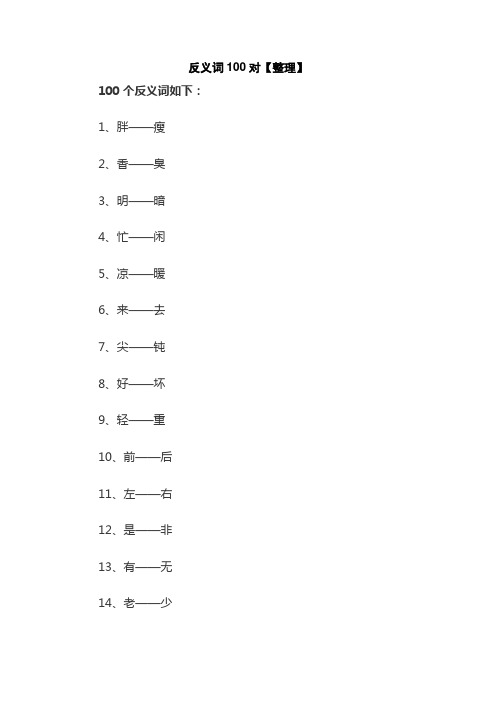
反义词100对【整理】100个反义词如下:1、胖——瘦2、香——臭3、明——暗4、忙——闲5、凉——暖6、来——去7、尖——钝8、好——坏9、轻——重10、前——后11、左——右12、是——非13、有——无14、老——少16、高——低17、快——慢18、升——降19、入——出20、开——关21、斜——正22、落——升23、冷——热24、饿——饱25、贫——富26、死——活27、穷——富28、买——卖29、旧——新30、细——粗32、首——尾33、始——终34、洁白——漆黑35、美丽——丑陋36、仔细——马虎37、告别——会合38、舒服——难受39、粗心——细心40、出发——归来41、安宁——喧闹42、宽敞——狭窄43、困难——容易44、热闹——寂静45、空闲——忙碌46、打开——关闭47、流动——固定48、暖和——寒冷49、弯曲——笔直50、微笑——悲伤51、昂首——低头52、开始——结束53、现在——将来54、喜欢——讨厌55、欢快——沉重56、机灵——愚笨57、明白——糊涂58、希望——失望59、傍晚——清晨60、秘密——公开61、高大——矮小62、坚定——动摇63、张开——合拢64、经常——偶尔65、愤怒——高兴66、坚定——犹豫67、清楚——模糊68、熟悉——陌生69、保护——破坏70、勇敢——懦弱71、聪明——愚蠢72、失败——成功73、敞开——关闭74、飞快——缓慢75、明白——糊涂76、失败——成功77、烦恼——高兴78、特殊——一般80、漂亮——丑陋81、高兴——伤心82、仔细——粗心83、精彩——枯燥84、洁净——肮脏85、心爱——厌恶86、飞快——缓慢87、极小——极大88、温和——暴躁89、好事——坏事90、奔跑——停止91、灾害——幸福92、坚硬——松软93、堵塞——畅通94、贵重——便宜96、聚集——分散97、新鲜——陈旧98、破碎——完整99、未来——现在100、诚实——狡猾。
反义词大全
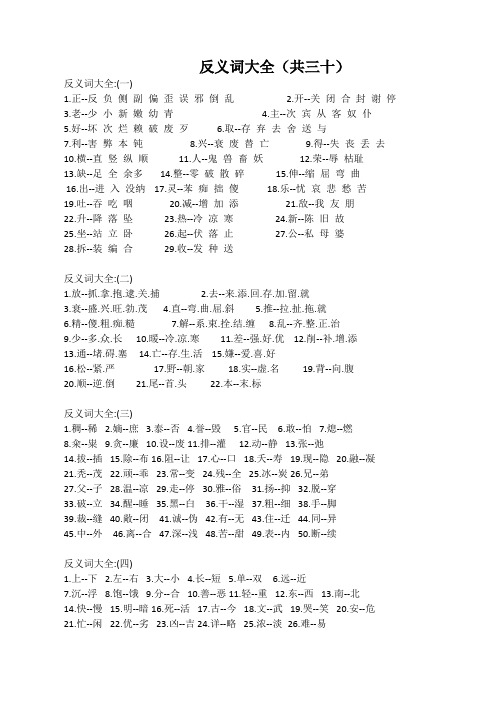
反义词大全(共三十)反义词大全:(一)1.正--反负侧副偏歪误邪倒乱2.开--关闭合封谢停3.老--少小新嫩幼青4.主--次宾从客奴仆5.好--坏次烂赖破废歹6.取--存弃去舍送与7.利--害弊本钝8.兴--衰废替亡9.得--失丧丢去10.横--直竖纵顺11.人--鬼兽畜妖12.荣--辱枯耻13.缺--足全余多 14.整--零破散碎15.伸--缩屈弯曲16.出--进入没纳 17.灵--苯痴拙傻 18.乐--忧哀悲愁苦19.吐--吞吃咽20.减--增加添21.敌--我友朋22.升--降落坠23.热--冷凉寒24.新--陈旧故25.坐--站立卧26.起--伏落止27.公--私母婆28.拆--装编合29.收--发种送反义词大全:(二)1.放--抓.拿.抱.逮.关.捕2.去--来.添.回.存.加.留.就3.衰--盛.兴.旺.勃.茂4.直--弯.曲.屈.斜5.推--拉.扯.拖.就6.精--傻.粗.痴.糙7.解--系.束.拴.结.缠8.乱--齐.整.正.治9.少--多.众.长 10.暖--冷.凉.寒11.差--强.好.优 12.削--补.增.添13.通--堵.碍.塞 14.亡--存.生.活 15.嫌--爱.喜.好16.松--紧.严17.野--朝.家18.实--虚.名19.背--向.腹20.顺--逆.倒21.尾--首.头22.本--末.标反义词大全:(三)1.稠--稀2.嫡--庶3.泰--否4.誉--毁5.官--民6.敢--怕7.熄--燃8.籴--粜9.贪--廉10.设--废11.排--灌12.动--静13.张--弛14.拔--插15.除--布16.阻--让17.心--口18.夭--寿19.现--隐20.融--凝21.秃--茂22.顽--乖23.常--变24.残--全25.冰--炭26.兄--弟27.父--子28.温--凉29.走--停30.雅--俗31.扬--抑32.脱--穿33.破--立34.醒--睡35.黑--白36.干--湿37.粗--细38.手--脚39.裁--缝40.敞--闭41.诚--伪42.有--无43.住--迁44.同--异45.中--外46.离--合47.深--浅48.苦--甜49.表--内50.断--续反义词大全:(四)1.上--下2.左--右3.大--小4.长--短5.单--双6.远--近7.沉--浮8.饱--饿9.分--合10.善--恶11.轻--重12.东--西13.南--北14.快--慢15.明--暗16.死--活17.古--今18.文--武19.哭--笑20.安--危21.忙--闲22.优--劣23.凶--吉 24.详--略25.浓--淡26.难--易27.香--臭28.呼--吸29.软--硬30.水--火31.借--还32.攻--守33.春--秋34.始--终35.旱--涝36.省--费37.亲--疏38.忠--奸39.荤--素40.彼--此41.繁--简42.男--女43.城--乡44.爱--恨45.方--圆46.土--洋47.因--果48.祸--福49.贵--贱50.德--怨反义词大全:(五)1.厚--薄2.质--量3.寒--暑4.俯--仰5.俭--奢6.嫁--娶7.输--赢8.刚--柔9.经--纬10.供--求11.任--免12.凹--凸13.成--败14.褒--贬15.雌--雄16.当--赎17.信--疑18.销--购19.问--答20.进--退21.悲--欢22.点--面23.幼--长24.宝--废25.石--玉26.教--学27.君--臣28.尊--卑29.丰--歉30.乾--坤31.赔--赚32.辞--雇33.好--恶34.强--弱35.来--回36.奉--违37.夫--妻38.你--我39.集--散40.睁--闭41.急--缓42.畅--阻43.遐--迩44.瑕--瑜45.纯--杂46.响--哑47.险--夷48.未--已49.勇--怯50.青--黄反义词大全:(六)1.百孔千疮--万紫千红2.百年大计--权宜之计3.半路出家--科班出身4.包罗万象--挂一漏万5.背道而驰--并行不悖6.别有用心--直举胸情7.病入膏肓--举手成春8.波澜起伏--平铺直叙9.不假思索--深思熟虑10.不胜枚举--寥寥可数11.不相闻问--书来信往12.不屑一顾--另眼相看13.不翼而飞--舍浦珠还14.步履维艰--健步如飞15.步人后尘--独出心裁16.长篇累牍--简明扼要17.畅通无阻--寸步难行18.趁火打劫--救困扶危19.瞠目结舌--口若悬河20.成年累月--一朝一夕21.冲锋陷阵--临阵脱逃22.冲耳不闻--洗耳恭听23.臭名昭著--名满天下24.初出茅庐--老成持重25.初生之犊--惊弓之鸟26.出类拔萃--滥竽充数27.出头露面--隐姓埋名28.慈眉善眼--横眉怒目29.粗声大气--好声好气反义词大全:(七)1.俯首帖耳--桀骜不顺2.釜底抽薪--扬汤止沸3.改弦更张--旧调重弹4.高枕而卧--厉兵秣马5.孤芳自赏--自惭形秽6.骨瘦如柴--脑满肠肥7.顾此失彼--两全其美8.故步自封--勇猛精进9.国富民强--民穷财尽10.寒暑无间--一暴十寒11.好高务远--脚踏实地12.厚古薄今--厚今薄古13.灰心丧志--踌躇满志14.祸不单行--福无双至15.计划经济--市场经济16.寄人篱下--自立门户17.家徒四壁--金玉满堂18.嫁祸于人--引咎自责19.江郎才尽--七步之才20.骄兵必败--哀兵必胜21.今不如昔--今非昔比22.锦上添花--佛头着粪23.精诚团结--分崩离析24.迥然不同--如出一辙25.刻骨铭心--置若罔闻26.口蜜腹剑--倾心吐胆27.恋恋不舍--绝裾而去28.灵机一动--深思熟虑29.老态龙钟--童颜鹤发反义词大全:(八)1.任人唯亲--任人唯贤2.日月如梭--时光荏冉3.融会贯通--生吞活剥4.山河依旧--事过境迁5.姗姗来迟--捷足先登6.神采奕奕--没精打采7.生搬硬套--因地制宜8.生死攸关--无关痛痒9.如愿以偿--事与愿违10.若不禁风--拔山举鼎11.升堂入室--未学肤受 12.盛气凌人--平易近人13.始终不渝--反复无常14.势不两立--唇齿相依15.守口如瓶--信口开河16.高瞻远瞩--鼠目寸光17.水乳交融--水火不容18.司空见惯--见所未见19.四平八稳--操之过急20.俗不可耐--文质彬彬21.随波逐流--自行其是22.随声附和--固执己见23.随遇而安--愤世疾俗24.损公肥私--大公无私25.天南地北--一衣带水26.甜言蜜语--金玉良言27.同舟共济--同床异梦28.兔死狐悲--幸灾乐祸29.歪歪扭扭--端端正正反义词大全:(九)1.有机可乘--无懈可击2.羽毛未丰--羽毛丰满3.乱七八糟--井井有条4.杂乱无章--有条不紊5.蒸蒸而上--每况愈下6.整齐划一--参差不齐7.直截了当--转弯抹角8.直言不讳--指桑骂槐9.趾高气扬--卑躬屈膝10.众寡悬殊--旗鼓相当11.众说纷纭--异口同声12.恣行无忌--谨言慎行13.自食其力--不劳而获14.左顾右盼--目不斜视15.坐失良机--机不可失16.应接不暇--应付自如17.万古长青--昙花一现18.心领神会--迷惑不解19.间接经验--直接经验20.流动资经--固定资经21.天然免疫--人工免疫22.隐花植物--显花植物23.爱才如命--挥金如土24.欣欣向荣--日暮途穷25.表里如一--两面三刀26.实事求是--弄虚作假27.精益求精--敷衍了事28.束手无策--千方百计29.不声不响--惊天动地反义词大全:(十)1.袖手旁观--见义勇为2.虚怀若谷--目空一切3.虚情假意--真心实意4.栩栩如生--死气沉沉5.悬崖勒马--执迷不悟6.血海深仇--雨露之恩7.揠苗助长--顺其自然8.言必有中--言不及义9.言之无物--言之有物10.叶落归根--背井离乡11.衣冠楚楚--衣衫褴褛12.一触即发--牢不可破13.一技之长--一无所长14.一览无余--管中窥豹15.一日千里--停滞不前16.一视同仁--厚此薄彼17.贪得无厌--分文不取18.天下太平--兵荒马乱19.通情达理--蛮横无理20.徒劳无益--劳苦功高21.徒有虚名--名副其实22.推波助澜--息事宁人23.望尘莫及--迎头赶上24.忘恩负义--感恩戴德25.委靡不振--精神抖擞26.未老先衰--老当益壮27.问长问短--不闻不问28.无的放失--有的放矢29.无恶不作--大发慈悲反义词大全:(十一)1.面不改色--面无人色2.明目张胆--偷偷摸摸3.名垂千古--名震一时4.名列前茅--名落孙山5.目不识丁--识文断字6.莫逆之交--一面之交7.藕断丝连--一刀两断8.暗箭难防--明枪易躲9.白璧微瑕--白璧无瑕10.百废待举--百废俱兴11.笨口拙舌--巧舌如簧12.不慌不忙--心慌意乱13.步步为营--长驱直入14.同义词--反义词15.必然性--偶然性16.羊肠小道--康庄大道金光大道17.仰人鼻息--独立自主自力更生18.垂头丧气--斗志昂扬兴高采烈19.光明正大--鬼鬼祟祟阴谋诡计20.理屈词穷--理直气壮义正词严21.门庭若市--门可罗雀门无蹄辙22.密密麻麻--稀稀拉拉稀稀落落23.莫不关心--关怀备至休戚相关24.年迈力衰--年富力强年轻力壮25.舍己为人--自私自利损人利己26.一无所有--无所不有应有尽有27.一心一意—三心二意反义词大全:(十二)1.被动--主动2.白米--糙米3.悲观--乐观4.笔试--口试5.笔译--口译6.便服--礼服7.便函--公函8.粗放--集约9.大写--小写10.淡季--旺季11.淡月--旺月12.地方--中央13.地狱--天堂14.动态--静态15.耳生--耳熟16.房东--房客17.丰收--歉收18.肯定--否定19.付方--收方20.感性--理性21.干线--支线22.公家--私人23.公事--私事24.公诉--自诉25.故杀--误杀26.官邸--私邸27.广义--狭义28.宏观--微观29.后天--先天30.活结--死结31.积极--消极32.寄籍--原籍33.寄读--走读34.间接--直接35.贱民--良民36.近因--远因37.净重--毛重38.净利--毛利 39.绝对--相对40.口语--书面语41.利息--本金42.流动--固定43.密码--明码44.明人--盲人45.内服--外敷46.内功--外功47.内行--外行48.内在--外在反义词大全:(十三)1.逆水--顺水2.片面--全面3.生存--死亡4.文戏--武戏5.无方--有方6.细粮--粗粮7.先手--后手8.阳间--阴间9.阳文--阴文10.义务--权利11.音译--意译12.玉碎--瓦全13.直译--意译14.中餐--西餐15.主犯--从犯16.主攻--助攻17.主观--客观18.主人--客人19.专任--兼任20.坐商--行商21.细心--疏忽22.厌恶--喜爱23.防涝--抗旱24.记忆--忘却25.巨浪--微波26.分开--汇集27.楔入--退出28.贡献--索取29.极小--巨大30.赏赐--惩罚31.厄运--幸运32.稳定--摇摆33.指望--失望34.严重--轻松35.精确--大概36.独力--合力37.独立--依附38.短处--长处39.对立--统一40.恶化--好转41.恶意--善意42.繁茂--枯萎43.繁密--稀疏44.繁重--轻松45.反比--正比46.反常--正常47.反抗--服从48.方便--麻烦反义词大全:(十四)1.放肆--规矩2.放心--担心3.废除--缔结4.分离--结合5.分析--综合6.愤恨--喜爱7.分内--分外8.丰产--减产9.丰富--单调10.丰满--干瘪11.讽刺--恭维12.福星--灾星13.拂晓--傍晚14.腐败--清明15.俯视--仰望16.富贵--贫贱17.富强--贫困18.富饶--贫穷19.副品--正品20.附近--遥远21.干脆--拖沓22.干燥--潮湿23.干才--庸才24.干流--支流25.刚强--脆弱26.高超--低劣27.高大--矮小28.高见--浅见29.高洁--龌龊30.高就--屈就31.高亢--低沉32.高攀--低就33.隔离--接触34.个别--一般35.个性--共性36.工整--潦草37.光滑--粗糙38.光明--黑暗39.光荣--耻辱40.归纳--演绎41.过错--功劳42.过度--适度43.过去--现在44.搭伙--散伙45.搭救--陷害46.达观--悲观47.打击--鼓励48.大度--小气反义词大全:(十五)1.单薄--厚实2.单纯--复杂3.单独--共同4.淡季--旺季5.淡忘--铭记6.淡雅--妖艳7.淡月--旺月8.当地--外地9.倒霉--走运10.倒退--前进11.倒叙--顺叙12.得逞--未遂13.得到--失掉14.低沉--高昂15.低潮--高潮16.低级--高级17.低头--抬头18.敌对--友好19.抵赖--承认20.缔交--绝交21.地方--中央22.地下--地上23.典雅--粗俗24.东方--西方25.东洋--西洋26.动荡--安定27.动乱--太平28.动态--静态29.冻结--融化30.陡峭--平缓31.愁闷--开心32.愁容--笑脸33.仇恨--友谊34.出兵--收兵35.出工--收工36.出家--还俗37.出境--入境38.出生--死亡39.出售--收购40.出席--缺席41.出现--消失42.纯熟--生疏43.聪颖--呆笨44.匆匆--徐徐45.从犯--主犯46.粗心--细心47.粗略--仔细48.粗野--文明反义词大全:(十六)1.摈弃--采纳2.冰凉--滚热3.并重--偏重4.薄弱--雄厚5.猜忌--相信6.参加--退出7.残暴--慈善8.仓促--充裕9.苍白--红润10.苍穹--大地11.沧海--桑田12.拆穿--掩饰13.孱弱--强壮14.长久--短暂15.长途--短途16.畅快--烦闷17.撤回--呈上18.沉闷--爽朗19.沉睡--苏醒20.沉重--轻松21.沉着--慌张22.称赞--责备23.成绩--问题24.成事--败事25.成长--衰落26.诚实--虚假27.暗箭--明枪28.昂扬--低落29.昂首--俯首30.拔高--贬低31.罢工--复工32.白话--文言33.白皙--黝黑34.罢免--任用35.败北--胜利36.败笔--妙笔37.败兴--乘兴38.班师--出师39.帮助--欺负40.包围--突围41.褒义--贬义42.宝贝--废物43.饱满--干瘪44.保持--丢掉45.保存--销毁46.保管--丢掉47.保护--损害48.暴政--仁政反义词大全:(十七)1.背后--当面2.被动--主动3.被告--原告4.笨重--轻便5.彼岸--此岸6.必然--偶然7.必修--选修8.闭幕--开幕9.贬抑--褒扬10.贬值--升值11.消化--吸收12.消灭--保留13.消逝--出现14.销毁--保存15.小气--大方16.小人--君子17.小型--大型18.效果--动机19.孝顺--忤逆20.邪恶--正直21.邪气--正气22.斜视--正视23.协办--主办24.泄露--保密25.卸装--上装26.心虚--胆壮27.辛勤--懒惰28.新式--老式29.新异--陈旧30.修建--拆除31.袖珍--巨型32.序幕--尾声33.绚烂--暗淡34.寻常--特殊35.驯服--调皮36.驯顺--调皮37.压缩--发展38.安逸--劳碌39.安适--辛劳40.害怕--勇敢41.寒带--热带42.寒流--暖流43.豪门--寒门44.好感--恶感45.好看--难看46.好事--坏事47.好心--恶意48.好意--恶意反义词大全:(十八)1.和平--战争2.横死--善终3.后人--先人4.后退--前进5.忽然--逐渐6.糊涂--清楚7.滑稽--严肃8.滑溜--粗糙9.华丽--朴素10.化合--分离11.欢送--欢迎12.缓慢--飞快13.幻想--现实14.荒凉--繁华15.诙谐--严肃16.回顾--展望17.混杂--纯粹18.活泼--死板19.活跃--沉闷20.豁亮--昏暗21.获得--失掉22.积聚--散开23.吉利--凶险24.吉兆--凶兆25.集合--分散26.急迫--从容27.急燥--稳重28.加强--削弱29.加速--减速30.缄默--开腔31.监禁--开释32.坚决--迟疑33.艰苦--舒适34.奸猾--忠厚35.奸诈--忠厚36.简便--繁琐37.简单--复杂38.简洁--罗嗦39.简练--繁冗40.减员--增员41.践约--违约42.降落--起飞43.搅乱--澄清44.结巴--流利45.结果--原因46.解放--束缚47.谨慎--粗心48.进口--出口反义词大全:(十九)1.进步--保守2.晋级--降级3.晋升--降职4.禁止--允许5.近代--远古6.近古--远古7.精致--粗劣8.警惕--麻痹9.静止--运动10.就职--辞职11.旧居--新居12.剧烈--平和13.开拔--驻扎14.开化--野蛮15.开启--封闭16.开通--守旧17.开头--结尾18.开张--关闭19.空洞--充实20.空前--绝后21.口紧--口松22.酷爱--痛恨23.酷暑--严冬24.夸大--缩小25.亏本--赢利26.朗诵--默读27.老本--新功28.老大--少壮29.老练--幼稚30.扩大--缩小31.拉拢--打击32.冷漠--关心33.冷僻--常见34.离别--团聚35.离队--归队36.离奇--平淡37.离散--团聚38.离职--复职39.理论--实践40.理想--现实41.立体--平面42.立正--稍息43.利息--本金44.廉洁--贪贿45.联合--分散46.连续--间断47.良好--恶劣48.劣势--优势反义词大全:(二十)1.流露--隐藏2.沦陷--收复3.卖国--爱国4.漫长--短暂5.莽撞--细心6.没有--拥有7.美化--丑化8.媚骨--傲骨9.密致--稀疏10.明确--含糊11.耐心--急躁12.难受--舒服13.逆境--顺境14.逆流--顺流15.浓密--稀疏16.浓缩--稀释17.浓重--淡薄18.偶数--奇数19.排泄--摄取20.派遣--召还21.配角--主角22.偏向--公平23.片刻--多时24.漂亮--难看25.破例--照例26.破灭--实现27.破损--完好28.欺负--帮助29.漆黑--雪白30.恰当--失当31.谦恭--傲慢32.前方--后方33.前锋--后卫34.浅陋--渊博35.浅显--艰深36.欠缺--齐全37.强劲--微弱38.切题--离题39.亲热--冷淡40.清澈--混浊41.清洁--肮脏42.清朗--阴晦43.清廉--贪贿44.清亮--浑浊45.清明--腐败46.清癯--丰腴47.清音--浊音48.轻盈--蠢笨反义词大全:(二十一)1.权力--义务2.缺额--满额3.群众--干部4.人家--自己5.人间--天上6.人性--兽性7.荣誉--耻辱8.柔嫩--坚硬9.锐角--钝角10.锐利--迟钝11.闰年--平年12.洒脱--拘束13.丧事--喜事14.沙漠--绿洲15.上层--下层16.上面--下面17.神仙--凡人18.慎重--轻率19.升级--降级20.省力--费力21.盛世--乱世22.盛暑--严冬23.湿润--干燥24.师傅--徒弟25.失常--正常26.失利--得胜27.失算--得计28.失约--如约29.释放--逮捕30.过分--适当31.守业--创业32.手段--目的33.受骗--行骗34.受罪--享福35.疏松--严密36.疏通--堵塞37.输入--输出38.熟识--陌生39.熟手--生手40.衰竭--亢进41.衰退--旺盛42.爽利--邋遢43.顺从--反抗44.随便--严肃45.坦白--隐瞒46.坦然--狼狈47.狭隘--宏大48.上策--下策反义词大全:(二十二)1.下放--上交2.上岗--下岗3.上级--下级4.下降--上升5.下联--上联6.下面--上面7.下人--主人8.下调--上调9.下文--上文10.下限--上限11.下游--上游12.先遣--后援13.鲜艳--暗淡14.娴熟--生疏15.衔接--割断16.显赫--卑.现代--古代18.现任--前任19.限制--自由20.相连--分隔21.相通--堵塞22.香花--毒草23.享福--遭罪24.响亮--低沉25.响应--反对26.消耗--积蓄27.体力--脑力28.天才--蠢才29.天干--地支30.天灾--人祸31.甜美--苦涩32.甜头--苦头33.调解--挑拨34.调皮--驯顺35.听从--违抗36.停顿--进展37.停火--开火38.停留--前进39.停业--开业40.通畅--阻塞41.同化--异化42.统统--仅仅43.突然--逐渐44.团体--个人45.推销--采购46.推卸--承担47.拖拉--利索48.外表--内心反义词大全:(二十三)1.外调--内查2.外交--内政3.外科--内科4.外力--内力5.外露--深沉6.外围--核心7.外销--内销8.外延--内涵9.玩忽--忠于10.顽固--开明11.晚年--早年12.晚期--早期13.婉言--直言14.微小--巨大15.违反--符合16.维护--败坏17.伟大--渺小18.违背--遵从19.委婉--生硬20.未然--已然21.温饱--饥寒22.文科--理科23.乌黑--洁白24.无关--有关25.无视--正视26.无畏--恐惧27.无须--必须28.侮慢--敬爱29.务实--务虚30.误解--谅解31.希望--失望32.袭取--篡改33.喜好--厌恶34.喜悦--悲哀35.细小--巨大36.延长--缩短37.延缓--提早38.眼前--长远39.眼生--眼熟40.谣言--事实41.野蛮--文明42.异常--正常43.殷勤--怠慢44.隐瞒--暴露45.英雄--懦夫46.盈余--亏损47.永久--暂时48.勇敢--胆怯反义词大全:(二十四)1.犹豫--果断2.有机--无机3.有益--无益4.幼年--成年5.迂缓--迅速6.愚昧--智慧7.郁闷--畅快8.远视--近视9.悦耳--刺耳10.赞赏--贬斥11.糟蹋--爱惜12.糟糕--精彩13.真实--虚伪14.真理--谬论15.镇静--慌张16.争光--抹黑17.整体--部分18.正史--野史19.滞销--畅销20.治本--治标21.置疑--置信22.制止--允许23.质变--量变24.质量--数量25.中断--持续26.中间--旁边27.终点--起点28.众多--稀少29.主要--次要30.自然--人工31.自私--无私32.诅咒--祝愿33.嘴紧--嘴松34.嘴甜--嘴损35.尊贵--卑贱36.左倾--右倾37.左翼--右翼38.做作--真实.自然39.遵循--背离.违背40.尊重--鄙薄.侮辱41.尊敬--轻慢.侮慢42.罪过--功绩.功劳43.自愿--被迫.强制44.茁壮--孱弱.纤弱45.拙劣--高明.巧妙46.周密--粗疏.疏忽反义词大全:(二十五)1.先进--保守.后进2.粗壮--纤弱.纤细3.相逢--分别.离别4.简备--简明.简略5.详尽--简明.简要6.详情--简况.概况7.反抗--降服.降顺8.高涨--消沉.低落9.消费--积累.生产10.萧条--繁华.繁荣11.晦涩--晓畅.流畅12.新鲜--陈腐.陈旧13.休息--工作.劳动14.虚弱--健壮.强壮15.虚心--骄傲.自满16.许可--反对阻止18.喧闹--安谧.肃静19.削减--增加.增添20.迅速--迟缓.缓慢21.天然--人工.自然22.后来--起先.起初23.严厉--慈祥.温和24.隐蔽--暴露.显露25.阴沉--晴朗.响晴26.庸俗--高尚.文雅27.有利--不利.无利28.有趣--乏味.无聊29.愚蠢--聪明.聪颖30.愚笨--灵活.乖巧31.愉快--烦闷.痛苦32.悦耳--刺耳.难听33.停滞--发展.延续34.停止--进行.延续35.推翻--建立.扶植36.退缩--前进.进取37.外患--内患.内乱38.完整反义词大全:(二十六)1.合法--非法.违法2.合作--分工.单干3.和顺--倔强.凶暴4.后方--前方.前线5.糊涂--明白.清醒6.华丽--朴实.简陋7.怀疑--相信.信任8.激动--沉着.镇静 9.机灵--呆板.笨拙10.继续--中止.中断11.急促--舒缓.缓慢12.简陋--豪华.华丽13.简略--详尽.详细14.减少--增加.增添15.降低--升高.增高16.揭露--掩盖.掩饰17.糟蹋--节省.节约18.解散--成立.集会19.酷寒--酷热.炎热20.酷热--酷寒.严寒21.宽敞--狭小.狭窄22.宽绰--穷困.狭窄23.宽大--狭小.窄小24.严惩--宽容.宽恕25.冷落--繁华.热闹26.冷清--热闹.红火27.利落--迟钝.拖沓28.害处--利益.益处29.廉价--高价.重价30.辽阔--狭小.窄小31.了解--陌生.生疏32.临时--长期.反义词大全:(二十七)1.朴素--花哨.艳丽2.齐整--凌乱.零乱3.平常--奇怪.奇特4.谦逊--傲慢.骄傲5.前辈--后辈.后代6.前面--后面.背后7.强大--弱小.虚弱8.强健--虚弱.孱弱9.强烈--柔和.微弱10.怯懦--大胆.勇敢11.切实--浮夸.空洞12.勤奋--懒惰.怠惰13.清楚--模糊.朦胧14.清淡--浓郁.油腻15.清静--热闹.喧闹16.轻巧--笨重.繁重17.部分--全体.全部18.缺陷--优点.长处19.热情--冷淡.淡漠20.凝固--熔化.融化21.冗长--简短.洗练22.弱小--强大.魁梧23.伤害--爱护.保护24.生动--枯燥.死板25.失败--胜利.成功26.失意--得意.得势27.逝世--出生.诞生28.瘦小--肥大.魁梧29.瘦削--肥胖.丰满30.舒畅--郁闷.抑郁31.熟练--生疏.生僻32.熟悉--陌生.反义词大全:(二十八)1.革命--改良.反动2.柔弱--刚健.刚劲3.高尚--卑鄙.卑劣4.窄小--广大.广阔5.打开--关上.盖上6.大意--小心.精心7.呆板--活泼.自然8.少量--大量.大批9.胆小--胆大.大胆10.当初--今日.现在11.当前--长远.以前12.地面--天空.高空13.地狱--天堂.天国14.客人--主人.东道15.斗争--调和.妥协16.厌恶--爱好.宠爱17.充实--单薄.空虚18.仇人--亲人.恩人19.一般--出众.出色20.处分--奖赏.奖励21.纯洁--肮脏.龌龊22.粗率--典雅.高雅23.冰冷--炽热.火热24.薄情--痴情.多情25.嘲笑--赞美.赞叹26.陈旧--崭新.簇新27.残缺--完好.健全28.拆卸--安装.装配29.常态--失态.变态30.霸道--人道.王道31.高兴--痛苦.悲痛.难过反义词大全:(二十九) 1.忘怀--想念. 挂念.思念2.掩盖--暴露. 揭示. 坦露 3.忧郁--高兴. 快乐. 兴奋4.幼稚--成熟. 老成.老练 5.迥异--相似. 相同.相象6.详细--概要. 扼要. 粗略7.个人--集体. 大家. 大伙8.公开--秘密. 暗中. 隐蔽9.新颖--陈旧.平常.一般10.振奋--颓废. 颓丧.萎靡11.振作--颓废. 颓丧.萎靡12.正确--差错. 错误. 荒谬13.直率--委婉. 隐晦.油滑14.拙见--高见. 高论.卓见15.自卑--自大. 自傲. 自豪16.寒冷--温暖. 暖和. 炎热17.和气--粗暴. 蛮横.凶恶18.和善--凶恶. 凶狠. 粗暴19.黄昏--拂晓. 黎明. 破晓20.集中--分开. 分散.扩散21.寂静--喧闹.喧哗. 喧嚣22.坚定--犹豫. 犹疑. 动摇23.简明--烦琐. 繁琐.繁冗24.将来--目前. 现在. 过去25.奖励--处分. 处罚. 惩罚26.接受--送出. 拒绝.进去27.接受--推辞. 谢绝. 抛弃28.进攻--防守. 退却. 撤退29.拘束--随便. 大方.洒脱反义词大全:(三十)1.深奥--浅显. 通俗. 浅近2.收缩--发展. 扩大. 膨胀3.守旧--创新. 革新. 开通4.疏远--亲近. 密切.亲密5.讨厌--喜欢.喜爱.可爱6.庄重--草率.轻率.轻浮.轻佻7.自己--别人. 大家. 人家.他人8.遵循--违背. 违反. 违抗. 违犯9.郑重--草率. 潦草. 马虎.轻率10.正面--背面. 侧面. 反面.背后11.幸福--悲伤. 痛苦. 灾难.悲惨12.虚伪--诚恳. 诚实. 笃实. 老实13.细致--粗略. 马虎. 粗疏.粗糙14.狭窄--宽阔. 开阔. 广阔. 广泛15.反对--同意. 支持. 拥护.赞成16.丑陋--标致. 漂亮. 优美. 俊美. 美丽17.从容--慌乱. 慌忙. 紧迫.慌张18.暴露--掩盖. 包藏. 隐蔽. 隐藏19.和蔼--严厉. 粗暴. 蛮横.凶恶20.狡猾--老实. 忠诚. 诚实. 忠实21.快活--苦恼. 苦闷. 烦闷.忧愁22.宽广--狭隘. 狭小. 狭窄. 窄小23.浪费--节约. 节省。
反义词大全
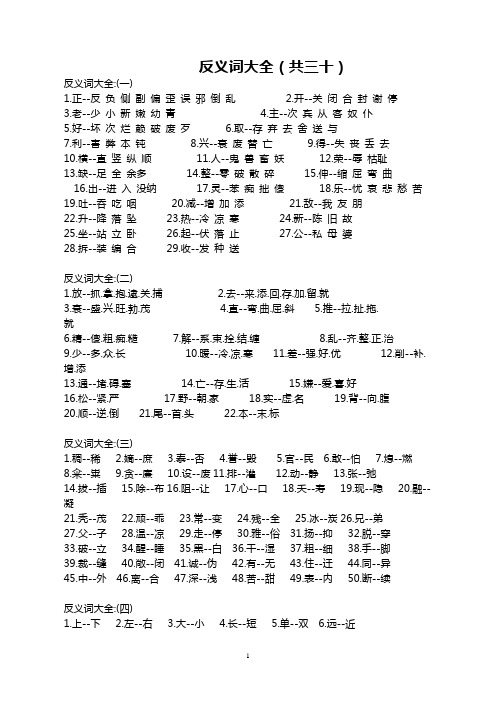
反义词大全(共三十)反义词大全:(一)1.正--反负侧副偏歪误邪倒乱2.开--关闭合封谢停3.老--少小新嫩幼青4.主--次宾从客奴仆5.好--坏次烂赖破废歹6.取--存弃去舍送与7.利--害弊本钝8.兴--衰废替亡9.得--失丧丢去10.横--直竖纵顺11.人--鬼兽畜妖12.荣--辱枯耻13.缺--足全余多14.整--零破散碎15.伸--缩屈弯曲16.出--进入没纳17.灵--苯痴拙傻18.乐--忧哀悲愁苦19.吐--吞吃咽20.减--增加添21.敌--我友朋22.升--降落坠23.热--冷凉寒24.新--陈旧故25.坐--站立卧26.起--伏落止27.公--私母婆28.拆--装编合29.收--发种送反义词大全:(二)1.放--抓.拿.抱.逮.关.捕2.去--来.添.回.存.加.留.就3.衰--盛.兴.旺.勃.茂4.直--弯.曲.屈.斜5.推--拉.扯.拖.就6.精--傻.粗.痴.糙7.解--系.束.拴.结.缠8.乱--齐.整.正.治9.少--多.众.长10.暖--冷.凉.寒11.差--强.好.优12.削--补.增.添13.通--堵.碍.塞14.亡--存.生.活15.嫌--爱.喜.好16.松--紧.严17.野--朝.家18.实--虚.名19.背--向.腹20.顺--逆.倒21.尾--首.头22.本--末.标反义词大全:(三)1.稠--稀2.嫡--庶3.泰--否4.誉--毁5.官--民6.敢--怕7.熄--燃8.籴--粜9.贪--廉10.设--废11.排--灌12.动--静13.张--弛14.拔--插15.除--布16.阻--让17.心--口18.夭--寿19.现--隐20.融--凝21.秃--茂22.顽--乖23.常--变24.残--全25.冰--炭26.兄--弟27.父--子28.温--凉29.走--停30.雅--俗31.扬--抑32.脱--穿33.破--立34.醒--睡35.黑--白36.干--湿37.粗--细38.手--脚39.裁--缝40.敞--闭41.诚--伪42.有--无43.住--迁44.同--异45.中--外46.离--合47.深--浅48.苦--甜49.表--内50.断--续反义词大全:(四)1.上--下2.左--右3.大--小4.长--短5.单--双6.远--近7.沉--浮8.饱--饿9.分--合10.善--恶11.轻--重12.东--西13.南--北14.快--慢15.明--暗16.死--活17.古--今18.文--武19.哭--笑20.安--危21.忙--闲22.优--劣23.凶--吉24.详--略25.浓--淡26.难--易27.香--臭28.呼--吸29.软--硬30.水--火31.借--还32.攻--守33.春--秋34.始--终35.旱--涝36.省--费37.亲--疏38.忠--奸39.荤--素40.彼--此41.繁--简42.男--女43.城--乡44.爱--恨45.方--圆46.土--洋47.因--果48.祸--福49.贵--贱50.德--怨反义词大全:(五)1.厚--薄2.质--量3.寒--暑4.俯--仰5.俭--奢6.嫁--娶7.输--赢8.刚--柔9.经--纬10.供--求11.任--免12.凹--凸13.成--败14.褒--贬15.雌--雄16.当--赎17.信--疑18.销--购19.问--答20.进--退21.悲--欢22.点--面23.幼--长24.宝--废25.石--玉26.教--学27.君--臣28.尊--卑29.丰--歉30.乾--坤31.赔--赚32.辞--雇33.好--恶34.强--弱35.来--回36.奉--违37.夫--妻38.你--我39.集--散40.睁--闭41.急--缓42.畅--阻43.遐--迩44.瑕--瑜45.纯--杂46.响--哑47.险--夷48.未--已49.勇--怯50.青--黄反义词大全:(六)1.百孔千疮--万紫千红2.百年大计--权宜之计3.半路出家--科班出身4.包罗万象--挂一漏万5.背道而驰--并行不悖6.别有用心--直举胸情7.病入膏肓--举手成春8.波澜起伏--平铺直叙9.不假思索--深思熟虑10.不胜枚举--寥寥可数11.不相闻问--书来信往12.不屑一顾--另眼相看13.不翼而飞--舍浦珠还14.步履维艰--健步如飞15.步人后尘--独出心裁16.长篇累牍--简明扼要17.畅通无阻--寸步难行18.趁火打劫--救困扶危19.瞠目结舌--口若悬河20.成年累月--一朝一夕21.冲锋陷阵--临阵脱逃22.冲耳不闻--洗耳恭听23.臭名昭著--名满天下24.初出茅庐--老成持重25.初生之犊--惊弓之鸟26.出类拔萃--滥竽充数27.出头露面--隐姓埋名28.慈眉善眼--横眉怒目29.粗声大气--好声好气反义词大全:(七)1.俯首帖耳--桀骜不顺2.釜底抽薪--扬汤止沸3.改弦更张--旧调重弹4.高枕而卧--厉兵秣马5.孤芳自赏--自惭形秽6.骨瘦如柴--脑满肠肥7.顾此失彼--两全其美8.故步自封--勇猛精进9.国富民强--民穷财尽10.寒暑无间--一暴十寒11.好高务远--脚踏实地12.厚古薄今--厚今薄古13.灰心丧志--踌躇满志14.祸不单行--福无双至15.计划经济--市场经济16.寄人篱下--自立门户17.家徒四壁--金玉满堂18.嫁祸于人--引咎自责19.江郎才尽--七步之才20.骄兵必败--哀兵必胜21.今不如昔--今非昔比22.锦上添花--佛头着粪23.精诚团结--分崩离析24.迥然不同--如出一辙25.刻骨铭心--置若罔闻26.口蜜腹剑--倾心吐胆27.恋恋不舍--绝裾而去28.灵机一动--深思熟虑29.老态龙钟--童颜鹤发反义词大全:(八)1.任人唯亲--任人唯贤2.日月如梭--时光荏冉3.融会贯通--生吞活剥4.山河依旧--事过境迁5.姗姗来迟--捷足先登6.神采奕奕--没精打采7.生搬硬套--因地制宜8.生死攸关--无关痛痒9.如愿以偿--事与愿违10.若不禁风--拔山举鼎11.升堂入室--未学肤受12.盛气凌人--平易近人13.始终不渝--反复无常14.势不两立--唇齿相依15.守口如瓶--信口开河16.高瞻远瞩--鼠目寸光17.水乳交融--水火不容18.司空见惯--见所未见19.四平八稳--操之过急20.俗不可耐--文质彬彬21.随波逐流--自行其是22.随声附和--固执己见23.随遇而安--愤世疾俗24.损公肥私--大公无私25.天南地北--一衣带水26.甜言蜜语--金玉良言27.同舟共济--同床异梦28.兔死狐悲--幸灾乐祸29.歪歪扭扭--端端正正反义词大全:(九)1.有机可乘--无懈可击2.羽毛未丰--羽毛丰满3.乱七八糟--井井有条4.杂乱无章--有条不紊5.蒸蒸而上--每况愈下6.整齐划一--参差不齐7.直截了当--转弯抹角8.直言不讳--指桑骂槐9.趾高气扬--卑躬屈膝10.众寡悬殊--旗鼓相当11.众说纷纭--异口同声12.恣行无忌--谨言慎行13.自食其力--不劳而获14.左顾右盼--目不斜视15.坐失良机--机不可失16.应接不暇--应付自如17.万古长青--昙花一现18.心领神会--迷惑不解19.间接经验--直接经验20.流动资经--固定资经21.天然免疫--人工免疫22.隐花植物--显花植物23.爱才如命--挥金如土24.欣欣向荣--日暮途穷25.表里如一--两面三刀26.实事求是--弄虚作假27.精益求精--敷衍了事28.束手无策--千方百计29.不声不响--惊天动地反义词大全:(十)1.袖手旁观--见义勇为2.虚怀若谷--目空一切3.虚情假意--真心实意4.栩栩如生--死气沉沉5.悬崖勒马--执迷不悟6.血海深仇--雨露之恩7.揠苗助长--顺其自然8.言必有中--言不及义9.言之无物--言之有物10.叶落归根--背井离乡11.衣冠楚楚--衣衫褴褛12.一触即发--牢不可破13.一技之长--一无所长14.一览无余--管中窥豹15.一日千里--停滞不前16.一视同仁--厚此薄彼17.贪得无厌--分文不取18.天下太平--兵荒马乱19.通情达理--蛮横无理20.徒劳无益--劳苦功高21.徒有虚名--名副其实22.推波助澜--息事宁人23.望尘莫及--迎头赶上24.忘恩负义--感恩戴德25.委靡不振--精神抖擞26.未老先衰--老当益壮27.问长问短--不闻不问28.无的放失--有的放矢29.无恶不作--大发慈悲反义词大全:(十一)1.面不改色--面无人色2.明目张胆--偷偷摸摸3.名垂千古--名震一时4.名列前茅--名落孙山5.目不识丁--识文断字6.莫逆之交--一面之交7.藕断丝连--一刀两断8.暗箭难防--明枪易躲9.白璧微瑕--白璧无瑕10.百废待举--百废俱兴11.笨口拙舌--巧舌如簧12.不慌不忙--心慌意乱13.步步为营--长驱直入14.同义词--反义词15.必然性--偶然性16.羊肠小道--康庄大道金光大道17.仰人鼻息--独立自主自力更生18.垂头丧气--斗志昂扬兴高采烈19.光明正大--鬼鬼祟祟阴谋诡计20.理屈词穷--理直气壮义正词严21.门庭若市--门可罗雀门无蹄辙22.密密麻麻--稀稀拉拉稀稀落落23.莫不关心--关怀备至休戚相关24.年迈力衰--年富力强年轻力壮25.舍己为人--自私自利损人利己26.一无所有--无所不有应有尽有27.一心一意—三心二意反义词大全:(十二)1.被动--主动2.白米--糙米3.悲观--乐观4.笔试--口试5.笔译--口译6.便服--礼服7.便函--公函8.粗放--集约9.大写--小写10.淡季--旺季11.淡月--旺月12.地方--中央13.地狱--天堂14.动态--静态15.耳生--耳熟16.房东--房客17.丰收--歉收18.肯定--否定19.付方--收方20.感性--理性21.干线--支线22.公家--私人23.公事--私事24.公诉--自诉25.故杀--误杀26.官邸--私邸27.广义--狭义28.宏观--微观29.后天--先天30.活结--死结31.积极--消极32.寄籍--原籍33.寄读--走读34.间接--直接35.贱民--良民36.近因--远因37.净重--毛重38.净利--毛利39.绝对--相对40.口语--书面语41.利息--本金42.流动--固定43.密码--明码44.明人--盲人45.内服--外敷46.内功--外功47.内行--外行48.内在--外在反义词大全:(十三)1.逆水--顺水2.片面--全面3.生存--死亡4.文戏--武戏5.无方--有方6.细粮--粗粮7.先手--后手8.阳间--阴间9.阳文--阴文10.义务--权利11.音译--意译12.玉碎--瓦全13.直译--意译14.中餐--西餐15.主犯--从犯16.主攻--助攻17.主观--客观18.主人--客人19.专任--兼任20.坐商--行商21.细心--疏忽22.厌恶--喜爱23.防涝--抗旱24.记忆--忘却25.巨浪--微波26.分开--汇集27.楔入--退出28.贡献--索取29.极小--巨大30.赏赐--惩罚31.厄运--幸运32.稳定--摇摆33.指望--失望34.严重--轻松35.精确--大概36.独力--合力37.独立--依附38.短处--长处39.对立--统一40.恶化--好转41.恶意--善意42.繁茂--枯萎43.繁密--稀疏44.繁重--轻松45.反比--正比46.反常--正常47.反抗--服从48.方便--麻烦反义词大全:(十四)1.放肆--规矩2.放心--担心3.废除--缔结4.分离--结合5.分析--综合6.愤恨--喜爱7.分内--分外8.丰产--减产9.丰富--单调10.丰满--干瘪11.讽刺--恭维12.福星--灾星13.拂晓--傍晚14.腐败--清明15.俯视--仰望16.富贵--贫贱17.富强--贫困18.富饶--贫穷19.副品--正品20.附近--遥远21.干脆--拖沓22.干燥--潮湿23.干才--庸才24.干流--支流25.刚强--脆弱26.高超--低劣27.高大--矮小28.高见--浅见29.高洁--龌龊30.高就--屈就31.高亢--低沉32.高攀--低就33.隔离--接触34.个别--一般35.个性--共性36.工整--潦草37.光滑--粗糙38.光明--黑暗39.光荣--耻辱40.归纳--演绎41.过错--功劳42.过度--适度43.过去--现在44.搭伙--散伙45.搭救--陷害46.达观--悲观47.打击--鼓励48.大度--小气反义词大全:(十五)1.单薄--厚实2.单纯--复杂3.单独--共同4.淡季--旺季5.淡忘--铭记6.淡雅--妖艳7.淡月--旺月8.当地--外地9.倒霉--走运10.倒退--前进11.倒叙--顺叙12.得逞--未遂13.得到--失掉14.低沉--高昂15.低潮--高潮16.低级--高级17.低头--抬头18.敌对--友好19.抵赖--承认20.缔交--绝交21.地方--中央22.地下--地上23.典雅--粗俗24.东方--西方25.东洋--西洋26.动荡--安定27.动乱--太平28.动态--静态29.冻结--融化30.陡峭--平缓31.愁闷--开心32.愁容--笑脸33.仇恨--友谊34.出兵--收兵35.出工--收工36.出家--还俗37.出境--入境38.出生--死亡39.出售--收购40.出席--缺席41.出现--消失42.纯熟--生疏43.聪颖--呆笨44.匆匆--徐徐45.从犯--主犯46.粗心--细心47.粗略--仔细48.粗野--文明反义词大全:(十六)1.摈弃--采纳2.冰凉--滚热3.并重--偏重4.薄弱--雄厚5.猜忌--相信6.参加--退出7.残暴--慈善8.仓促--充裕9.苍白--红润10.苍穹--大地11.沧海--桑田12.拆穿--掩饰13.孱弱--强壮14.长久--短暂15.长途--短途16.畅快--烦闷17.撤回--呈上18.沉闷--爽朗19.沉睡--苏醒20.沉重--轻松21.沉着--慌张22.称赞--责备23.成绩--问题24.成事--败事25.成长--衰落26.诚实--虚假27.暗箭--明枪28.昂扬--低落29.昂首--俯首30.拔高--贬低31.罢工--复工32.白话--文言33.白皙--黝黑34.罢免--任用35.败北--胜利36.败笔--妙笔37.败兴--乘兴38.班师--出师39.帮助--欺负40.包围--突围41.褒义--贬义42.宝贝--废物43.饱满--干瘪44.保持--丢掉45.保存--销毁46.保管--丢掉47.保护--损害48.暴政--仁政反义词大全:(十七)1.背后--当面2.被动--主动3.被告--原告4.笨重--轻便5.彼岸--此岸6.必然--偶然7.必修--选修8.闭幕--开幕9.贬抑--褒扬10.贬值--升值11.消化--吸收12.消灭--保留13.消逝--出现14.销毁--保存15.小气--大方16.小人--君子17.小型--大型18.效果--动机19.孝顺--忤逆20.邪恶--正直21.邪气--正气22.斜视--正视23.协办--主办24.泄露--保密25.卸装--上装26.心虚--胆壮27.辛勤--懒惰28.新式--老式29.新异--陈旧30.修建--拆除31.袖珍--巨型32.序幕--尾声33.绚烂--暗淡34.寻常--特殊35.驯服--调皮36.驯顺--调皮37.压缩--发展38.安逸--劳碌39.安适--辛劳40.害怕--勇敢41.寒带--热带42.寒流--暖流43.豪门--寒门44.好感--恶感45.好看--难看46.好事--坏事47.好心--恶意48.好意--恶意反义词大全:(十八)1.和平--战争2.横死--善终3.后人--先人4.后退--前进5.忽然--逐渐6.糊涂--清楚7.滑稽--严肃8.滑溜--粗糙9.华丽--朴素10.化合--分离11.欢送--欢迎12.缓慢--飞快13.幻想--现实14.荒凉--繁华15.诙谐--严肃16.回顾--展望17.混杂--纯粹18.活泼--死板19.活跃--沉闷20.豁亮--昏暗21.获得--失掉22.积聚--散开23.吉利--凶险24.吉兆--凶兆25.集合--分散26.急迫--从容27.急燥--稳重28.加强--削弱29.加速--减速30.缄默--开腔31.监禁--开释32.坚决--迟疑33.艰苦--舒适34.奸猾--忠厚35.奸诈--忠厚36.简便--繁琐37.简单--复杂38.简洁--罗嗦39.简练--繁冗40.减员--增员41.践约--违约42.降落--起飞43.搅乱--澄清44.结巴--流利45.结果--原因46.解放--束缚47.谨慎--粗心48.进口--出口反义词大全:(十九)1.进步--保守2.晋级--降级3.晋升--降职4.禁止--允许5.近代--远古6.近古--远古7.精致--粗劣8.警惕--麻痹9.静止--运动10.就职--辞职11.旧居--新居12.剧烈--平和13.开拔--驻扎14.开化--野蛮15.开启--封闭16.开通--守旧17.开头--结尾18.开张--关闭19.空洞--充实20.空前--绝后21.口紧--口松22.酷爱--痛恨23.酷暑--严冬24.夸大--缩小25.亏本--赢利26.朗诵--默读27.老本--新功28.老大--少壮29.老练--幼稚30.扩大--缩小31.拉拢--打击32.冷漠--关心33.冷僻--常见34.离别--团聚35.离队--归队36.离奇--平淡37.离散--团聚38.离职--复职39.理论--实践40.理想--现实41.立体--平面42.立正--稍息43.利息--本金44.廉洁--贪贿45.联合--分散46.连续--间断47.良好--恶劣48.劣势--优势反义词大全:(二十)1.流露--隐藏2.沦陷--收复3.卖国--爱国4.漫长--短暂5.莽撞--细心6.没有--拥有7.美化--丑化8.媚骨--傲骨9.密致--稀疏10.明确--含糊11.耐心--急躁12.难受--舒服13.逆境--顺境14.逆流--顺流15.浓密--稀疏16.浓缩--稀释17.浓重--淡薄18.偶数--奇数19.排泄--摄取20.派遣--召还21.配角--主角22.偏向--公平23.片刻--多时24.漂亮--难看25.破例--照例26.破灭--实现27.破损--完好28.欺负--帮助29.漆黑--雪白30.恰当--失当31.谦恭--傲慢32.前方--后方33.前锋--后卫34.浅陋--渊博35.浅显--艰深36.欠缺--齐全37.强劲--微弱38.切题--离题39.亲热--冷淡40.清澈--混浊41.清洁--肮脏42.清朗--阴晦43.清廉--贪贿44.清亮--浑浊45.清明--腐败46.清癯--丰腴47.清音--浊音48.轻盈--蠢笨反义词大全:(二十一)1.权力--义务2.缺额--满额3.群众--干部4.人家--自己5.人间--天上6.人性--兽性7.荣誉--耻辱8.柔嫩--坚硬9.锐角--钝角10.锐利--迟钝11.闰年--平年12.洒脱--拘束13.丧事--喜事14.沙漠--绿洲15.上层--下层16.上面--下面17.神仙--凡人18.慎重--轻率19.升级--降级20.省力--费力21.盛世--乱世22.盛暑--严冬23.湿润--干燥24.师傅--徒弟25.失常--正常26.失利--得胜27.失算--得计28.失约--如约29.释放--逮捕30.过分--适当31.守业--创业32.手段--目的33.受骗--行骗34.受罪--享福35.疏松--严密36.疏通--堵塞37.输入--输出38.熟识--陌生39.熟手--生手40.衰竭--亢进41.衰退--旺盛42.爽利--邋遢43.顺从--反抗44.随便--严肃45.坦白--隐瞒46.坦然--狼狈47.狭隘--宏大48.上策--下策反义词大全:(二十二)1.下放--上交2.上岗--下岗3.上级--下级4.下降--上升5.下联--上联6.下面--上面7.下人--主人8.下调--上调9.下文--上文10.下限--上限11.下游--上游12.先遣--后援13.鲜艳--暗淡14.娴熟--生疏15.衔接--割断16.显赫--卑微17.现代--古代18.现任--前任19.限制--自由20.相连--分隔21.相通--堵塞22.香花--毒草23.享福--遭罪24.响亮--低沉25.响应--反对26.消耗--积蓄27.体力--脑力28.天才--蠢才29.天干--地支30.天灾--人祸31.甜美--苦涩32.甜头--苦头33.调解--挑拨34.调皮--驯顺35.听从--违抗36.停顿--进展37.停火--开火38.停留--前进39.停业--开业40.通畅--阻塞41.同化--异化42.统统--仅仅43.突然--逐渐44.团体--个人45.推销--采购46.推卸--承担47.拖拉--利索48.外表--内心反义词大全:(二十三)1.外调--内查2.外交--内政3.外科--内科4.外力--内力5.外露--深沉6.外围--核心7.外销--内销8.外延--内涵9.玩忽--忠于10.顽固--开明11.晚年--早年12.晚期--早期13.婉言--直言14.微小--巨大15.违反--符合16.维护--败坏17.伟大--渺小18.违背--遵从19.委婉--生硬20.未然--已然21.温饱--饥寒22.文科--理科23.乌黑--洁白24.无关--有关25.无视--正视26.无畏--恐惧27.无须--必须28.侮慢--敬爱29.务实--务虚30.误解--谅解31.希望--失望32.袭取--篡改33.喜好--厌恶34.喜悦--悲哀35.细小--巨大36.延长--缩短37.延缓--提早38.眼前--长远39.眼生--眼熟40.谣言--事实41.野蛮--文明42.异常--正常43.殷勤--怠慢44.隐瞒--暴露45.英雄--懦夫46.盈余--亏损47.永久--暂时48.勇敢--胆怯反义词大全:(二十四)1.犹豫--果断2.有机--无机3.有益--无益4.幼年--成年5.迂缓--迅速6.愚昧--智慧7.郁闷--畅快8.远视--近视9.悦耳--刺耳10.赞赏--贬斥11.糟蹋--爱惜12.糟糕--精彩13.真实--虚伪14.真理--谬论15.镇静--慌张16.争光--抹黑17.整体--部分18.正史--野史19.滞销--畅销20.治本--治标21.置疑--置信22.制止--允许23.质变--量变24.质量--数量25.中断--持续26.中间--旁边27.终点--起点28.众多--稀少29.主要--次要30.自然--人工31.自私--无私32.诅咒--祝愿33.嘴紧--嘴松34.嘴甜--嘴损35.尊贵--卑贱36.左倾--右倾37.左翼--右翼38.做作--真实.自然39.遵循--背离.违背40.尊重--鄙薄.侮辱41.尊敬--轻慢.侮慢42.罪过--功绩.功劳43.自愿--被迫.强制44.茁壮--孱弱.纤弱45.拙劣--高明.巧妙46.周密--粗疏.疏忽反义词大全:(二十五)1.先进--保守.后进2.粗壮--纤弱.纤细3.相逢--分别.离别4.简备--简明.简略5.详尽--简明.简要6.详情--简况.概况7.反抗--降服.降顺8.高涨--消沉.低落9.消费--积累.生产10.萧条--繁华.繁荣11.晦涩--晓畅.流畅12.新鲜--陈腐.陈旧13.休息--工作.劳动14.虚弱--健壮.强壮15.虚心--骄傲.自满16.许可--反对阻止18.喧闹--安谧.肃静19.削减--增加.增添20.迅速--迟缓.缓慢21.天然--人工.自然22.后来--起先.起初23.严厉--慈祥.温和24.隐蔽--暴露.显露25.阴沉--晴朗.响晴26.庸俗--高尚.文雅27.有利--不利.无利28.有趣--乏味.无聊29.愚蠢--聪明.聪颖30.愚笨--灵活.乖巧31.愉快--烦闷.痛苦32.悦耳--刺耳.难听33.停滞--发展.延续34.停止--进行.延续35.推翻--建立.扶植36.退缩--前进.进取37.外患--内患.内乱38.完整反义词大全:(二十六)1.合法--非法.违法2.合作--分工.单干3.和顺--倔强.凶暴4.后方--前方.前线5.糊涂--明白.清醒6.华丽--朴实.简陋7.怀疑--相信.信任8.激动--沉着.镇静9.机灵--呆板.笨拙10.继续--中止.中断11.急促--舒缓.缓慢12.简陋--豪华.华丽13.简略--详尽.详细14.减少--增加.增添15.降低--升高.增高16.揭露--掩盖.掩饰17.糟蹋--节省.节约18.解散--成立.集会19.酷寒--酷热.炎热20.酷热--酷寒.严寒21.宽敞--狭小.狭窄22.宽绰--穷困.狭窄23.宽大--狭小.窄小24.严惩--宽容.宽恕25.冷落--繁华.热闹26.冷清--热闹.红火27.利落--迟钝.拖沓28.害处--利益.益处29.廉价--高价.重价30.辽阔--狭小.窄小31.了解--陌生.生疏32.临时--长期.反义词大全:(二十七)1.朴素--花哨.艳丽2.齐整--凌乱.零乱3.平常--奇怪.奇特4.谦逊--傲慢.骄傲5.前辈--后辈.后代6.前面--后面.背后7.强大--弱小.虚弱8.强健--虚弱.孱弱9.强烈--柔和.微弱10.怯懦--大胆.勇敢11.切实--浮夸.空洞12.勤奋--懒惰.怠惰13.清楚--模糊.朦胧14.清淡--浓郁.油腻15.清静--热闹.喧闹16.轻巧--笨重.繁重17.部分--全体.全部18.缺陷--优点.长处19.热情--冷淡.淡漠20.凝固--熔化.融化21.冗长--简短.洗练22.弱小--强大.魁梧23.伤害--爱护.保护24.生动--枯燥.死板25.失败--胜利.成功26.失意--得意.得势27.逝世--出生.诞生28.瘦小--肥大.魁梧29.瘦削--肥胖.丰满30.舒畅--郁闷.抑郁31.熟练--生疏.生僻32.熟悉--陌生.反义词大全:(二十八)1.革命--改良.反动2.柔弱--刚健.刚劲3.高尚--卑鄙.卑劣4.窄小--广大.广阔5.打开--关上.盖上6.大意--小心.精心7.呆板--活泼.自然8.少量--大量.大批9.胆小--胆大.大胆10.当初--今日.现在11.当前--长远.以前12.地面--天空.高空13.地狱--天堂.天国14.客人--主人.东道15.斗争--调和.妥协16.厌恶--爱好.宠爱17.充实--单薄.空虚18.仇人--亲人.恩人19.一般--出众.出色20.处分--奖赏.奖励21.纯洁--肮脏.龌龊22.粗率--典雅.高雅23.冰冷--炽热.火热24.薄情--痴情.多情25.嘲笑--赞美.赞叹26.陈旧--崭新.簇新27.残缺--完好.健全28.拆卸--安装.装配29.常态--失态.变态30.霸道--人道.王道31.高兴--痛苦.悲痛.难过反义词大全:(二十九) 1.忘怀--想念. 挂念 .思念2.掩盖--暴露. 揭示. 坦露3.忧郁--高兴. 快乐. 兴奋4.幼稚--成熟. 老成 .老练5.迥异--相似. 相同 .相象6.详细--概要. 扼要. 粗略7.个人--集体. 大家. 大伙8.公开--秘密. 暗中. 隐蔽9.新颖--陈旧 .平常 .一般10.振奋--颓废. 颓丧 .萎靡11.振作--颓废. 颓丧.萎靡12.正确--差错. 错误. 荒谬13.直率--委婉. 隐晦 .油滑14.拙见--高见. 高论.卓见15.自卑--自大. 自傲. 自豪16.寒冷--温暖. 暖和. 炎热17.和气--粗暴. 蛮横.凶恶18.和善--凶恶. 凶狠. 粗暴19.黄昏--拂晓. 黎明. 破晓20.集中--分开. 分散.扩散21.寂静--喧闹 .喧哗. 喧嚣22.坚定--犹豫. 犹疑. 动摇23.简明--烦琐. 繁琐.繁冗24.将来--目前. 现在. 过去25.奖励--处分. 处罚. 惩罚26.接受--送出. 拒绝.进去27.接受--推辞. 谢绝. 抛弃28.进攻--防守. 退却. 撤退29.拘束--随便. 大方.洒脱反义词大全:(三十)1.深奥--浅显. 通俗. 浅近2.收缩--发展. 扩大. 膨胀3.守旧--创新. 革新. 开通4.疏远--亲近. 密切 .亲密5.讨厌--喜欢.喜爱.可爱6.庄重--草率.轻率.轻浮.轻佻7.自己--别人. 大家. 人家.他人8.遵循--违背. 违反. 违抗. 违犯9.郑重--草率. 潦草. 马虎.轻率10.正面--背面. 侧面. 反面 .背后11.幸福--悲伤. 痛苦. 灾难.悲惨12.虚伪--诚恳.诚实. 笃实. 老实13.细致--粗略. 马虎. 粗疏.粗糙14.狭窄--宽阔. 开阔. 广阔. 广泛15.反对--同意. 支持. 拥护.赞成16.丑陋--标致. 漂亮. 优美. 俊美. 美丽17.从容--慌乱. 慌忙. 紧迫.慌张18.暴露--掩盖. 包藏. 隐蔽. 隐藏19.和蔼--严厉. 粗暴. 蛮横.凶恶20.狡猾--老实. 忠诚. 诚实. 忠实21.快活--苦恼. 苦闷. 烦闷.忧愁22.宽广--狭隘. 狭小. 狭窄. 窄小23.浪费--节约. 节省。
反义词大全
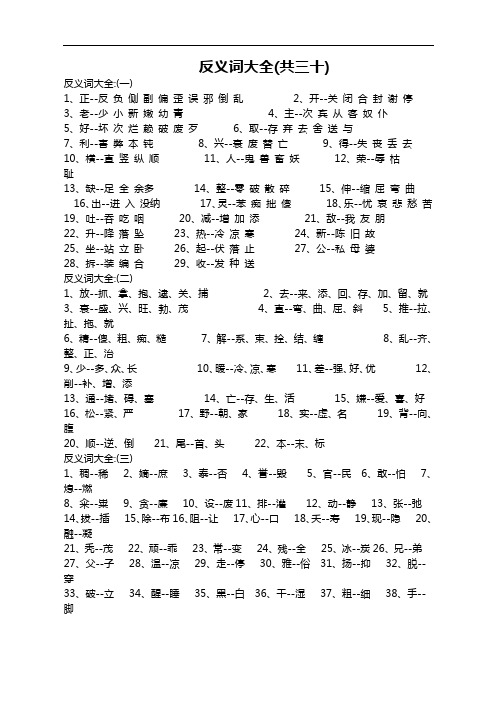
反义词大全(共三十)反义词大全:(一)1、正--反负侧副偏歪误邪倒乱2、开--关闭合封谢停3、老--少小新嫩幼青4、主--次宾从客奴仆5、好--坏次烂赖破废歹6、取--存弃去舍送与7、利--害弊本钝8、兴--衰废替亡9、得--失丧丢去10、横--直竖纵顺11、人--鬼兽畜妖12、荣--辱枯耻13、缺--足全余多14、整--零破散碎15、伸--缩屈弯曲16、出--进入没纳17、灵--苯痴拙傻18、乐--忧哀悲愁苦19、吐--吞吃咽20、减--增加添21、敌--我友朋22、升--降落坠23、热--冷凉寒24、新--陈旧故25、坐--站立卧26、起--伏落止27、公--私母婆28、拆--装编合29、收--发种送反义词大全:(二)1、放--抓、拿、抱、逮、关、捕2、去--来、添、回、存、加、留、就3、衰--盛、兴、旺、勃、茂4、直--弯、曲、屈、斜5、推--拉、扯、拖、就6、精--傻、粗、痴、糙7、解--系、束、拴、结、缠8、乱--齐、整、正、治9、少--多、众、长10、暖--冷、凉、寒11、差--强、好、优12、削--补、增、添13、通--堵、碍、塞14、亡--存、生、活15、嫌--爱、喜、好16、松--紧、严17、野--朝、家18、实--虚、名19、背--向、腹20、顺--逆、倒21、尾--首、头22、本--末、标反义词大全:(三)1、稠--稀2、嫡--庶3、泰--否4、誉--毁5、官--民6、敢--怕7、熄--燃8、籴--粜9、贪--廉10、设--废11、排--灌12、动--静13、张--弛14、拔--插15、除--布16、阻--让17、心--口18、夭--寿19、现--隐20、融--凝21、秃--茂22、顽--乖23、常--变24、残--全25、冰--炭26、兄--弟27、父--子28、温--凉29、走--停30、雅--俗31、扬--抑32、脱--穿33、破--立34、醒--睡35、黑--白36、干--湿37、粗--细38、手--脚39、裁--缝40、敞--闭41、诚--伪42、有--无43、住--迁44、同--异45、中--外46、离--合47、深--浅48、苦--甜49、表--内50、断--续反义词大全:(四)1、上--下2、左--右3、大--小4、长--短5、单--双6、远--近7、沉--浮8、饱--饿9、分--合10、善--恶11、轻--重12、东--西13、南--北14、快--慢15、明--暗16、死--活17、古--今18、文--武19、哭--笑20、安--危21、忙--闲22、优--劣23、凶--吉24、详--略25、浓--淡26、难--易27、香--臭28、呼--吸29、软--硬30、水--火31、借--还32、攻--守33、春--秋34、始--终35、旱--涝36、省--费37、亲--疏38、忠--奸39、荤--素40、彼--此41、繁--简42、男--女43、城--乡44、爱--恨45、方--圆46、土--洋47、因--果48、祸--福49、贵--贱50、德--怨反义词大全:(五)1、厚--薄2、质--量3、寒--暑4、俯--仰5、俭--奢6、嫁--娶7、输--赢8、刚--柔9、经--纬10、供--求11、任--免12、凹--凸13、成--败14、褒--贬15、雌--雄16、当--赎17、信--疑18、销--购19、问--答20、进--退21、悲--欢22、点--面23、幼--长24、宝--废25、石--玉26、教--学27、君--臣28、尊--卑29、丰--歉30、乾--坤31、赔--赚32、辞--雇33、好--恶34、强--弱35、来--回36、奉--违37、夫--妻38、您--我39、集--散40、睁--闭41、急--缓42、畅--阻43、遐--迩44、瑕--瑜45、纯--杂46、响--哑47、险--夷48、未--已49、勇--怯50、青--黄反义词大全:(六)1、百孔千疮--万紫千红2、百年大计--权宜之计3、半路出家--科班出身4、包罗万象--挂一漏万5、背道而驰--并行不悖6、别有用心--直举胸情7、病入膏肓--举手成春8、波澜起伏--平铺直叙9、不假思索--深思熟虑10、不胜枚举--寥寥可数11、不相闻问--书来信往12、不屑一顾--另眼相瞧13、不翼而飞--舍浦珠还14、步履维艰--健步如飞15、步人后尘--独出心裁16、长篇累牍--简明扼要17、畅通无阻--寸步难行18、趁火打劫--救困扶危19、瞠目结舌--口若悬河20、成年累月--一朝一夕21、冲锋陷阵--临阵脱逃22、冲耳不闻--洗耳恭听23、臭名昭著--名满天下24、初出茅庐--老成持重25、初生之犊--惊弓之鸟26、出类拔萃--滥竽充数27、出头露面--隐姓埋名28、慈眉善眼--横眉怒目29、粗声大气--好声好气反义词大全:(七)1、俯首帖耳--桀骜不顺2、釜底抽薪--扬汤止沸3、改弦更张--旧调重弹4、高枕而卧--厉兵秣马5、孤芳自赏--自惭形秽6、骨瘦如柴--脑满肠肥7、顾此失彼--两全其美8、故步自封--勇猛精进9、国富民强--民穷财尽10、寒暑无间--一暴十寒11、好高务远--脚踏实地12、厚古薄今--厚今薄古13、灰心丧志--踌躇满志14、祸不单行--福无双至15、计划经济--市场经济16、寄人篱下--自立门户17、家徒四壁--金玉满堂18、嫁祸于人--引咎自责19、江郎才尽--七步之才20、骄兵必败--哀兵必胜21、今不如昔--今非昔比22、锦上添花--佛头着粪23、精诚团结--分崩离析24、迥然不同--如出一辙25、刻骨铭心--置若罔闻26、口蜜腹剑--倾心吐胆27、恋恋不舍--绝裾而去28、灵机一动--深思熟虑29、老态龙钟--童颜鹤发反义词大全:(八)1、任人唯亲--任人唯贤2、日月如梭--时光荏冉3、融会贯通--生吞活剥4、山河依旧--事过境迁5、姗姗来迟--捷足先登6、神采奕奕--没精打采7、生搬硬套--因地制宜8、生死攸关--无关痛痒9、如愿以偿--事与愿违10、若不禁风--拔山举鼎11、升堂入室--未学肤受12、盛气凌人--平易近人13、始终不渝--反复无常14、势不两立--唇齿相依15、守口如瓶--信口开河16、高瞻远瞩--鼠目寸光17、水乳交融--水火不容18、司空见惯--见所未见19、四平八稳--操之过急20、俗不可耐--文质彬彬21、随波逐流--自行其就是22、随声附与--固执己见23、随遇而安--愤世疾俗24、损公肥私--大公无私25、天南地北--一衣带水26、甜言蜜语--金玉良言27、同舟共济--同床异梦28、兔死狐悲--幸灾乐祸29、歪歪扭扭--端端正正反义词大全:(九)1、有机可乘--无懈可击2、羽毛未丰--羽毛丰满3、乱七八糟--井井有条4、杂乱无章--有条不紊5、蒸蒸而上--每况愈下6、整齐划一--参差不齐7、直截了当--转弯抹角8、直言不讳--指桑骂槐9、趾高气扬--卑躬屈膝10、众寡悬殊--旗鼓相当11、众说纷纭--异口同声12、恣行无忌--谨言慎行13、自食其力--不劳而获14、左顾右盼--目不斜视15、坐失良机--机不可失16、应接不暇--应付自如17、万古长青--昙花一现18、心领神会--迷惑不解19、间接经验--直接经验20、流动资经--固定资经21、天然免疫--人工免疫22、隐花植物--显花植物23、爱才如命--挥金如土24、欣欣向荣--日暮途穷25、表里如一--两面三刀26、实事求就是--弄虚作假27、精益求精--敷衍了事28、束手无策--千方百计29、不声不响--惊天动地反义词大全:(十)1、袖手旁观--见义勇为2、虚怀若谷--目空一切3、虚情假意--真心实意4、栩栩如生--死气沉沉5、悬崖勒马--执迷不悟6、血海深仇--雨露之恩7、揠苗助长--顺其自然8、言必有中--言不及义9、言之无物--言之有物10、叶落归根--背井离乡11、衣冠楚楚--衣衫褴褛12、一触即发--牢不可破13、一技之长--一无所长14、一览无余--管中窥豹15、一日千里--停滞不前16、一视同仁--厚此薄彼17、贪得无厌--分文不取18、天下太平--兵荒马乱19、通情达理--蛮横无理20、徒劳无益--劳苦功高21、徒有虚名--名副其实22、推波助澜--息事宁人23、望尘莫及--迎头赶上24、忘恩负义--感恩戴德25、委靡不振--精神抖擞26、未老先衰--老当益壮27、问长问短--不闻不问28、无得放失--有得放矢29、无恶不作--大发慈悲反义词大全:(十一)1、面不改色--面无人色2、明目张胆--偷偷摸摸3、名垂千古--名震一时4、名列前茅--名落孙山5、目不识丁--识文断字6、莫逆之交--一面之交7、藕断丝连--一刀两断8、暗箭难防--明枪易躲9、白璧微瑕--白璧无瑕10、百废待举--百废俱兴11、笨口拙舌--巧舌如簧12、不慌不忙--心慌意乱13、步步为营--长驱直入14、同义词--反义词15、必然性--偶然性16、羊肠小道--康庄大道金光大道17、仰人鼻息--独立自主自力更生18、垂头丧气--斗志昂扬兴高采烈19、光明正大--鬼鬼祟祟阴谋诡计20、理屈词穷--理直气壮义正词严21、门庭若市--门可罗雀门无蹄辙22、密密麻麻--稀稀拉拉稀稀落落23、莫不关心--关怀备至休戚相关24、年迈力衰--年富力强年轻力壮25、舍己为人--自私自利损人利己26、一无所有--无所不有应有尽有27、一心一意—三心二意反义词大全:(十二)1、被动--主动2、白米--糙米3、悲观--乐观4、笔试--口试5、笔译--口译6、便服--礼服7、便函--公函8、粗放--集约9、大写--小写10、淡季--旺季11、淡月--旺月12、地方--中央13、地狱--天堂14、动态--静态15、耳生--耳熟16、房东--房客17、丰收--歉收18、肯定--否定19、付方--收方20、感性--理性21、干线--支线22、公家--私人23、公事--私事24、公诉--自诉25、故杀--误杀26、官邸--私邸27、广义--狭义28、宏观--微观29、后天--先天30、活结--死结31、积极--消极32、寄籍--原籍33、寄读--走读34、间接--直接35、贱民--良民36、近因--远因37、净重--毛重38、净利--毛利39、绝对--相对40、口语--书面语41、利息--本金42、流动--固定43、密码--明码44、明人--盲人45、内服--外敷46、内功--外功47、内行--外行48、内在--外在反义词大全:(十三)1、逆水--顺水2、片面--全面3、生存--死亡4、文戏--武戏5、无方--有方6、细粮--粗粮7、先手--后手8、阳间--阴间9、阳文--阴文10、义务--权利11、音译--意译12、玉碎--瓦全13、直译--意译14、中餐--西餐15、主犯--从犯16、主攻--助攻17、主观--客观18、主人--客人19、专任--兼任20、坐商--行商21、细心--疏忽22、厌恶--喜爱23、防涝--抗旱24、记忆--忘却25、巨浪--微波26、分开--汇集27、楔入--退出28、贡献--索取29、极小--巨大30、赏赐--惩罚31、厄运--幸运32、稳定--摇摆33、指望--失望34、严重--轻松35、精确--大概36、独力--合力37、独立--依附38、短处--长处39、对立--统一40、恶化--好转41、恶意--善意42、繁茂--枯萎43、繁密--稀疏44、繁重--轻松45、反比--正比46、反常--正常47、反抗--服从48、方便--麻烦反义词大全:(十四)1、放肆--规矩2、放心--担心3、废除--缔结4、分离--结合5、分析--综合6、愤恨--喜爱7、分内--分外8、丰产--减产9、丰富--单调10、丰满--干瘪11、讽刺--恭维12、福星--灾星13、拂晓--傍晚14、腐败--清明15、俯视--仰望16、富贵--贫贱17、富强--贫困18、富饶--贫穷19、副品--正品20、附近--遥远21、干脆--拖沓22、干燥--潮湿23、干才--庸才24、干流--支流25、刚强--脆弱26、高超--低劣27、高大--矮小28、高见--浅见29、高洁--龌龊30、高就--屈就31、高亢--低沉32、高攀--低就33、隔离--接触34、个别--一般35、个性--共性36、工整--潦草37、光滑--粗糙38、光明--黑暗39、光荣--耻辱40、归纳--演绎41、过错--功劳42、过度--适度43、过去--现在44、搭伙--散伙45、搭救--陷害46、达观--悲观47、打击--鼓励48、大度--小气反义词大全:(十五)1、单薄--厚实2、单纯--复杂3、单独--共同4、淡季--旺季5、淡忘--铭记6、淡雅--妖艳7、淡月--旺月8、当地--外地9、倒霉--走运10、倒退--前进11、倒叙--顺叙12、得逞--未遂13、得到--失掉14、低沉--高昂15、低潮--高潮16、低级--高级17、低头--抬头18、敌对--友好19、抵赖--承认20、缔交--绝交21、地方--中央22、地下--地上23、典雅--粗俗24、东方--西方25、东洋--西洋26、动荡--安定27、动乱--太平28、动态--静态29、冻结--融化30、陡峭--平缓31、愁闷--开心32、愁容--笑脸33、仇恨--友谊34、出兵--收兵35、出工--收工36、出家--还俗37、出境--入境38、出生--死亡39、出售--收购40、出席--缺席41、出现--消失42、纯熟--生疏43、聪颖--呆笨44、匆匆--徐徐45、从犯--主犯46、粗心--细心47、粗略--仔细48、粗野--文明反义词大全:(十六)1、摈弃--采纳2、冰凉--滚热3、并重--偏重4、薄弱--雄厚5、猜忌--相信6、参加--退出7、残暴--慈善8、仓促--充裕9、苍白--红润10、苍穹--大地11、沧海--桑田12、拆穿--掩饰13、孱弱--强壮14、长久--短暂15、长途--短途16、畅快--烦闷17、撤回--呈上18、沉闷--爽朗19、沉睡--苏醒20、沉重--轻松21、沉着--慌张22、称赞--责备23、成绩--问题24、成事--败事25、成长--衰落26、诚实--虚假27、暗箭--明枪28、昂扬--低落29、昂首--俯首30、拔高--贬低31、罢工--复工32、白话--文言33、白皙--黝黑34、罢免--任用35、败北--胜利36、败笔--妙笔37、败兴--乘兴38、班师--出师39、帮助--欺负40、包围--突围41、褒义--贬义42、宝贝--废物43、饱满--干瘪44、保持--丢掉45、保存--销毁46、保管--丢掉47、保护--损害48、暴政--仁政反义词大全:(十七)1、背后--当面2、被动--主动3、被告--原告4、笨重--轻便5、彼岸--此岸6、必然--偶然7、必修--选修8、闭幕--开幕9、贬抑--褒扬10、贬值--升值11、消化--吸收12、消灭--保留13、消逝--出现14、销毁--保存15、小气--大方16、小人--君子17、小型--大型18、效果--动机19、孝顺--忤逆20、邪恶--正直21、邪气--正气22、斜视--正视23、协办--主办24、泄露--保密25、卸装--上装26、心虚--胆壮27、辛勤--懒惰28、新式--老式29、新异--陈旧30、修建--拆除31、袖珍--巨型32、序幕--尾声33、绚烂--暗淡34、寻常--特殊35、驯服--调皮36、驯顺--调皮37、压缩--发展38、安逸--劳碌39、安适--辛劳40、害怕--勇敢41、寒带--热带42、寒流--暖流43、豪门--寒门44、好感--恶感45、好瞧--难瞧46、好事--坏事47、好心--恶意48、好意--恶意反义词大全:(十八)1、与平--战争2、横死--善终3、后人--先人4、后退--前进5、忽然--逐渐6、糊涂--清楚7、滑稽--严肃8、滑溜--粗糙9、华丽--朴素10、化合--分离11、欢送--欢迎12、缓慢--飞快13、幻想--现实14、荒凉--繁华15、诙谐--严肃16、回顾--展望17、混杂--纯粹18、活泼--死板19、活跃--沉闷20、豁亮--昏暗21、获得--失掉22、积聚--散开23、吉利--凶险24、吉兆--凶兆25、集合--分散26、急迫--从容27、急燥--稳重28、加强--削弱29、加速--减速30、缄默--开腔31、监禁--开释32、坚决--迟疑33、艰苦--舒适34、奸猾--忠厚35、奸诈--忠厚36、简便--繁琐37、简单--复杂38、简洁--罗嗦39、简练--繁冗40、减员--增员41、践约--违约42、降落--起飞43、搅乱--澄清44、结巴--流利45、结果--原因46、解放--束缚47、谨慎--粗心48、进口--出口反义词大全:(十九)1、进步--保守2、晋级--降级3、晋升--降职4、禁止--允许5、近代--远古6、近古--远古7、精致--粗劣8、警惕--麻痹9、静止--运动10、就职--辞职11、旧居--新居12、剧烈--平与13、开拔--驻扎14、开化--野蛮15、开启--封闭16、开通--守旧17、开头--结尾18、开张--关闭19、空洞--充实20、空前--绝后21、口紧--口松22、酷爱--痛恨23、酷暑--严冬24、夸大--缩小25、亏本--赢利26、朗诵--默读27、老本--新功28、老大--少壮29、老练--幼稚30、扩大--缩小31、拉拢--打击32、冷漠--关心33、冷僻--常见34、离别--团聚35、离队--归队36、离奇--平淡37、离散--团聚38、离职--复职39、理论--实践40、理想--现实41、立体--平面42、立正--稍息43、利息--本金44、廉洁--贪贿45、联合--分散46、连续--间断47、良好--恶劣48、劣势--优势反义词大全:(二十)1、流露--隐藏2、沦陷--收复3、卖国--爱国4、漫长--短暂5、莽撞--细心6、没有--拥有7、美化--丑化8、媚骨--傲骨9、密致--稀疏10、明确--含糊11、耐心--急躁12、难受--舒服13、逆境--顺境14、逆流--顺流15、浓密--稀疏16、浓缩--稀释17、浓重--淡薄18、偶数--奇数19、排泄--摄取20、派遣--召还21、配角--主角22、偏向--公平23、片刻--多时24、漂亮--难瞧25、破例--照例26、破灭--实现27、破损--完好28、欺负--帮助29、漆黑--雪白30、恰当--失当31、谦恭--傲慢32、前方--后方33、前锋--后卫34、浅陋--渊博35、浅显--艰深36、欠缺--齐全37、强劲--微弱38、切题--离题39、亲热--冷淡40、清澈--混浊41、清洁--肮脏42、清朗--阴晦43、清廉--贪贿44、清亮--浑浊45、清明--腐败46、清癯--丰腴47、清音--浊音48、轻盈--蠢笨反义词大全:(二十一)1、权力--义务2、缺额--满额3、群众--干部4、人家--自己5、人间--天上6、人性--兽性7、荣誉--耻辱8、柔嫩--坚硬9、锐角--钝角10、锐利--迟钝11、闰年--平年12、洒脱--拘束13、丧事--喜事14、沙漠--绿洲15、上层--下层16、上面--下面17、神仙--凡人18、慎重--轻率19、升级--降级20、省力--费力21、盛世--乱世22、盛暑--严冬23、湿润--干燥24、师傅--徒弟25、失常--正常26、失利--得胜27、失算--得计28、失约--如约29、释放--逮捕30、过分--适当31、守业--创业32、手段--目得33、受骗--行骗34、受罪--享福35、疏松--严密36、疏通--堵塞37、输入--输出38、熟识--陌生39、熟手--生手40、衰竭--亢进41、衰退--旺盛42、爽利--邋遢43、顺从--反抗44、随便--严肃45、坦白--隐瞒46、坦然--狼狈47、狭隘--宏大48、上策--下策反义词大全:(二十二)1、下放--上交2、上岗--下岗3、上级--下级4、下降--上升5、下联--上联6、下面--上面7、下人--主人8、下调--上调9、下文--上文10、下限--上限11、下游--上游12、先遣--后援13、鲜艳--暗淡14、娴熟--生疏15、衔接--割断16、显赫--卑微17、现代--古代18、现任--前任19、限制--自由20、相连--分隔21、相通--堵塞22、香花--毒草23、享福--遭罪24、响亮--低沉25、响应--反对26、消耗--积蓄27、体力--脑力28、天才--蠢才29、天干--地支30、天灾--人祸31、甜美--苦涩32、甜头--苦头33、调解--挑拨34、调皮--驯顺35、听从--违抗36、停顿--进展37、停火--开火38、停留--前进39、停业--开业40、通畅--阻塞41、同化--异化42、统统--仅仅43、突然--逐渐44、团体--个人45、推销--采购46、推卸--承担47、拖拉--利索48、外表--内心反义词大全:(二十三)1、外调--内查2、外交--内政3、外科--内科4、外力--内力5、外露--深沉6、外围--核心7、外销--内销8、外延--内涵9、玩忽--忠于10、顽固--开明11、晚年--早年12、晚期--早期13、婉言--直言14、微小--巨大15、违反--符合16、维护--败坏17、伟大--渺小18、违背--遵从19、委婉--生硬20、未然--已然21、温饱--饥寒22、文科--理科23、乌黑--洁白24、无关--有关25、无视--正视26、无畏--恐惧27、无须--必须28、侮慢--敬爱29、务实--务虚30、误解--谅解31、希望--失望32、袭取--篡改33、喜好--厌恶34、喜悦--悲哀35、细小--巨大36、延长--缩短37、延缓--提早38、眼前--长远39、眼生--眼熟40、谣言--事实41、野蛮--文明42、异常--正常43、殷勤--怠慢44、隐瞒--暴露45、英雄--懦夫46、盈余--亏损47、永久--暂时48、勇敢--胆怯反义词大全:(二十四)1、犹豫--果断2、有机--无机3、有益--无益4、幼年--成年5、迂缓--迅速6、愚昧--智慧7、郁闷--畅快8、远视--近视9、悦耳--刺耳10、赞赏--贬斥11、糟蹋--爱惜12、糟糕--精彩13、真实--虚伪14、真理--谬论15、镇静--慌张16、争光--抹黑17、整体--部分18、正史--野史19、滞销--畅销20、治本--治标21、置疑--置信22、制止--允许23、质变--量变24、质量--数量25、中断--持续26、中间--旁边27、终点--起点28、众多--稀少29、主要--次要30、自然--人工31、自私--无私32、诅咒--祝愿33、嘴紧--嘴松34、嘴甜--嘴损35、尊贵--卑贱36、左倾--右倾37、左翼--右翼38、做作--真实、自然39、遵循--背离、违背40、尊重--鄙薄、侮辱41、尊敬--轻慢、侮慢42、罪过--功绩、功劳43、自愿--被迫、强制44、茁壮--孱弱、纤弱45、拙劣--高明、巧妙46、周密--粗疏、疏忽反义词大全:(二十五)1、先进--保守、后进2、粗壮--纤弱、纤细3、相逢--分别、离别4、简备--简明、简略5、详尽--简明、简要6、详情--简况、概况7、反抗--降服、降顺8、高涨--消沉、低落9、消费--积累、生产10、萧条--繁华、繁荣11、晦涩--晓畅、流畅12、新鲜--陈腐、陈旧13、休息--工作、劳动14、虚弱--健壮、强壮15、虚心--骄傲、自满16、许可--反对阻止18、喧闹--安谧、肃静19、削减--增加、增添20、迅速--迟缓、缓慢21、天然--人工、自然22、后来--起先、起初23、严厉--慈祥、温与24、隐蔽--暴露、显露25、阴沉--晴朗、响晴26、庸俗--高尚、文雅27、有利--不利、无利28、有趣--乏味、无聊29、愚蠢--聪明、聪颖30、愚笨--灵活、乖巧31、愉快--烦闷、痛苦32、悦耳--刺耳、难听33、停滞--发展、延续34、停止--进行、延续35、推翻--建立、扶植36、退缩--前进、进取37、外患--内患、内乱38、完整反义词大全:(二十六)1、合法--非法、违法2、合作--分工、单干3、与顺--倔强、凶暴4、后方--前方、前线5、糊涂--明白、清醒6、华丽--朴实、简陋7、怀疑--相信、信任8、激动--沉着、镇静9、机灵--呆板、笨拙10、继续--中止、中断11、急促--舒缓、缓慢12、简陋--豪华、华丽13、简略--详尽、详细14、减少--增加、增添15、降低--升高、增高16、揭露--掩盖、掩饰17、糟蹋--节省、节约18、解散--成立、集会19、酷寒--酷热、炎热20、酷热--酷寒、严寒21、宽敞--狭小、狭窄22、宽绰--穷困、狭窄23、宽大--狭小、窄小24、严惩--宽容、宽恕25、冷落--繁华、热闹26、冷清--热闹、红火27、利落--迟钝、拖沓28、害处--利益、益处29、廉价--高价、重价30、辽阔--狭小、窄小31、了解--陌生、生疏32、临时--长期、反义词大全:(二十七)1、朴素--花哨、艳丽2、齐整--凌乱、零乱3、平常--奇怪、奇特4、谦逊--傲慢、骄傲5、前辈--后辈、后代6、前面--后面、背后7、强大--弱小、虚弱8、强健--虚弱、孱弱9、强烈--柔与、微弱10、怯懦--大胆、勇敢11、切实--浮夸、空洞12、勤奋--懒惰、怠惰13、清楚--模糊、朦胧14、清淡--浓郁、油腻15、清静--热闹、喧闹16、轻巧--笨重、繁重17、部分--全体、全部18、缺陷--优点、长处19、热情--冷淡、淡漠20、凝固--熔化、融化21、冗长--简短、洗练22、弱小--强大、魁梧23、伤害--爱护、保护24、生动--枯燥、死板25、失败--胜利、成功26、失意--得意、得势27、逝世--出生、诞生28、瘦小--肥大、魁梧29、瘦削--肥胖、丰满30、舒畅--郁闷、抑郁31、熟练--生疏、生僻32、熟悉--陌生、反义词大全:(二十八)1、革命--改良、反动2、柔弱--刚健、刚劲3、高尚--卑鄙、卑劣4、窄小--广大、广阔5、打开--关上、盖上6、大意--小心、精心7、呆板--活泼、自然8、少量--大量、大批9、胆小--胆大、大胆10、当初--今日、现在11、当前--长远、以前12、地面--天空、高空13、地狱--天堂、天国14、客人--主人、东道15、斗争--调与、妥协16、厌恶--爱好、宠爱17、充实--单薄、空虚18、仇人--亲人、恩人19、一般--出众、出色20、处分--奖赏、奖励21、纯洁--肮脏、龌龊22、粗率--典雅、高雅23、冰冷--炽热、火热24、薄情--痴情、多情25、嘲笑--赞美、赞叹26、陈旧--崭新、簇新27、残缺--完好、健全28、拆卸--安装、装配29、常态--失态、变态30、霸道--人道、王道31、高兴--痛苦、悲痛、难过反义词大全:(二十九) 1、忘怀--想念、挂念、思念2、掩盖--暴露、揭示、坦露3、忧郁--高兴、快乐、兴奋4、幼稚--成熟、老成、老练5、迥异--相似、相同、相象6、详细--概要、扼要、粗略7、个人--集体、大家、大伙8、公开--秘密、暗中、隐蔽9、新颖--陈旧、平常、一般10、振奋--颓废、颓丧、萎靡11、振作--颓废、颓丧、萎靡12、正确--差错、错误、荒谬13、直率--委婉、隐晦、油滑14、拙见--高见、高论、卓见15、自卑--自大、自傲、自豪16、寒冷--温暖、暖与、炎热17、与气--粗暴、蛮横、凶恶18、与善--凶恶、凶狠、粗暴19、黄昏--拂晓、黎明、破晓20、集中--分开、分散、扩散21、寂静--喧闹、喧哗、喧嚣22、坚定--犹豫、犹疑、动摇23、简明--烦琐、繁琐、繁冗24、将来--目前、现在、过去25、奖励--处分、处罚、惩罚26、接受--送出、拒绝、进去27、接受--推辞、谢绝、抛弃28、进攻--防守、退却、撤退29、拘束--随便、大方、洒脱反义词大全:(三十)1、深奥--浅显、通俗、浅近2、收缩--发展、扩大、膨胀3、守旧--创新、革新、开通4、疏远--亲近、密切、亲密5、讨厌--喜欢、喜爱、可爱6、庄重--草率、轻率、轻浮、轻佻7、自己--别人、大家、人家、她人8、遵循--违背、违反、违抗、违犯9、郑重--草率、潦草、马虎、轻率10、正面--背面、侧面、反面、背后11、幸福--悲伤、痛苦、灾难、悲惨12、虚伪--诚恳、诚实、笃实、老实13、细致--粗略、马虎、粗疏、粗糙14、狭窄--宽阔、开阔、广阔、广泛15、反对--同意、支持、拥护、赞成16、丑陋--标致、漂亮、优美、俊美、美丽17、从容--慌乱、慌忙、紧迫、慌张18、暴露--掩盖、包藏、隐蔽、隐藏19、与蔼--严厉、粗暴、蛮横、凶恶20、狡猾--老实、忠诚、诚实、忠实21、快活--苦恼、苦闷、烦闷、忧愁22、宽广--狭隘、狭小、狭窄、窄小23、浪费--节约、节省。
反义词大全

—瘦香—臭明—暗忙—闲凉—暖来—去尖—钝好—坏轻—重前—后左—右是—非有—无老—少深—浅高—低快—慢升—降入—出开—关斜—正落—升冷—热饿—饱贫—富死—活穷—富买—卖旧—新细—粗明—暗首—尾始—终洁白—漆黑美丽—丑陋仔细—马虎告别—会合舒服—难受粗心—细心出发—归来安宁—喧闹宽敞—狭窄困难—容易热闹—寂静空闲—忙碌打开—关闭流动—固定暖和—寒冷弯曲—笔直微笑—悲伤昂首—低头开始—结束现在—将来喜欢—讨厌欢快—沉重机灵—愚笨明白—糊涂希望—失望傍晚—清晨秘密—公开高大—矮小坚定—动摇张开—合拢经常—偶尔愤怒—高兴坚定—犹豫清楚—模糊熟悉—陌生保护—破坏勇敢—懦弱聪明—愚蠢失败—成功敞开—关闭飞快—缓慢明白—糊涂失败—成功烦恼—高兴特殊—一般特别—普通漂亮—丑陋高兴—伤心仔细—粗心精彩—枯燥洁净—肮脏心爱—厌恶飞快—缓慢极小—极大温和—暴躁好事—坏事奔跑—停止灾害—幸福坚硬—松软堵塞—畅通贵重—便宜锋利—迟钝聚集—分散新鲜—陈旧破碎—完整未来—现在诚实—狡猾可爱—可恨活泼—呆板赶紧—拖延透明—浑浊凉爽—炎热永远—短暂凉爽—闷热广阔—狭小相信—怀疑裂开—合拢相信—怀疑节省—浪费亲密—疏远高明—低劣热闹—冷清喜欢—讨厌茁壮—虚弱得意洋洋—垂头丧气斜—歪脚—足肥—胖降—落找—寻心惊肉跳—胆战心惊丝毫未动—未动分毫祝愿—祝福茁壮—强壮召唤—呼唤嘱咐—叮嘱希望—盼望闪烁—闪耀希望—盼望袭击—攻击打扰—打搅暖和—温和拜访—访问艳丽—鲜艳节省—节约美丽—漂亮快乐—欢乐时光—时间惊讶—惊奇亲密—亲切依然—依旧高明—高超喜欢—喜爱热闹—喧闹开心—快乐举行—进行凉爽—凉快广大—广阔永远—永久消失—消灭饥荒—饥饿广阔—宽阔飞翔—飞行奇怪—惊奇眨眼—瞬间聚集—聚拢根据—依据诚实—老实未来—将来称赞—赞扬发现—发觉赶紧—抓紧快乐—高兴解落—降落波纹—波浪颤动—颤抖颤动—抖动破碎—破裂珍珠—珍宝财富—财宝锋利—锐利伤心—难过高兴—快乐连忙—赶忙拦住—挡住极小—微小漂浮—漂移平时—平常奔跑—奔驰温和—温顺灾害—灾难帮助—关心温和—亲切无数—很多愿意—同意立刻—连忙如果—假如仔细—认真传说—传奇目录—名目招聘—聘请洁净—干净特殊—特别聆听—倾听领袖—首领盼望—希望费力—费劲使劲—用劲救护—抢救挑选—选择本事—本领烦恼—苦恼究竟—毕竟拼命—舍命浪费—白费干净—洁净录取—录用聊天—谈天盼望—希望耽误—耽搁敞开—放开躲藏—隐藏胆量—胆识飞快—飞速比赛—竞赛害怕—可怕亲爱—友爱保护—爱护谢谢—感谢清楚—清晰渐渐—慢慢面颊—脸蛋脖子—颈项歌唱—唱歌寻找—查找拾起—捡起办法—方法告别—离别准备—预备洁白—雪白美丽—秀丽出发—动身观察—观看很多—许多宾客—来宾安宁—安静逃窜—逃跑突然—忽然宽阔宽敞热闹—吵闹住所—住宅闪现—出现寺庙—寺院卧室—卧房流动—流淌连忙—赶忙忽然—突然好似—好像连忙—急忙正要—刚要浮上—浮现辽阔—宽阔昂首—仰头眼力—视力故乡—家乡本事—本领劝告—劝说依赖—依靠何必—为必凭着—靠着机灵—机智奔走—奔跑秘密—隐秘专心—用心著名—闻名奇怪—惊奇发现—发明好象—仿佛有趣—有味愤怒—气愤坚定—坚决仍旧—照旧弯弯曲曲—曲曲折折连绵不断—连绵起伏赞不绝口—赞叹不已反义词人声鼎沸—鸦雀无声不可计数—屈指可数生气勃勃—死气沉沉呼风唤雨—息事宁人坚固—松散凝结—离散陡峭—平坦伟大—渺小精美—粗俗温顺—凶猛沸腾—沉寂壮丽—晦暗呈现—消失静寂—嘈杂便宜—昂贵迟钝—敏捷兴奋—忧愁美丽—丑陋天堂—地狱模糊—清晰羡慕—不屑朦胧—清晰凶猛—温柔不识—相识舒服—难受弯曲—笔直懒惰—勤快宽裕—拮据隐藏—公开平坦—坎坷柔弱—坚强干燥—潮湿古老—现代故人—新交蜿蜒—笔直凝结-溶解增长—减短崭新—陈旧静谧—吵闹简单—复杂勇猛—怯懦附近—遥远寒冷—温暖温柔—凶恶尽职—失职轻盈—笨重隐隐约约—清清楚楚明—暗此—彼朝—暮闲-忙紧—松伸—缩扩散(聚集)微波(巨浪)聚集(分散)明艳(暗淡)蜿蜒(笔直)善良(凶恶)精湛(生疏)马虎(认真)生疏(熟练)卓越(普通)伟大(渺小)稀(密)朴实(华丽)安全(危险)冷淡(热情)伤害(保护)踌躇(果断)松散(紧凑)频繁(稀少)减产(增产)下降(上升)破坏(保护)容易(困难)灵巧(笨重)敏锐(迟钝)揭开(覆盖)立刻(迟缓)清楚(模糊)宽敞(狭窄)平衡(倾斜)提高(降低)沉寂(喧闹)黝黑(白皙)和平(战争)流畅(阻塞)坚强(柔弱)歪歪斜斜-端端正正枝繁叶茂-枯枝败叶垂头丧气-昂首挺胸迷惑不解-恍然大悟遵从(违反)骄傲(谦虚)完整(残缺)坚硬(柔软)糟蹋(爱惜)有限(无限)失望(希望)开阔(狭窄)清晰(模糊)温暖(寒冷)明白(疑惑)朴素(华丽)独特(普通)微弱(强烈)漆黑(明亮)消失(出现)责备(表扬)公开(秘密)固执(随和)特别(一般)明亮(暗淡)细致(粗糙)舒畅(难受)疑惑(明白)坚毅(动摇)容易(困难)成功(失败)悲惨(幸福)违抗(遵从)纯洁(混浊)错误(正确)坚定(动摇)凶恶(善良)违背(遵从)明白(糊涂)聚拢(分散)偶尔(经常)俊俏(丑陋)乌黑(洁白)光滑(粗糙)轻快(沉重)漂浮(沉浸)静止(移动)匿藏(暴露)漆黑(光明)温柔(粗暴)明澈(混浊)悠闲(忙碌)自在(拘束)枯萎(茂盛)依赖(自立)从容(慌张)优美(丑陋)粗俗(文雅)承认(否定)朦胧(清晰)疲倦(充沛)焦急(耐心)放肆(拘束)漂亮(丑陋)违抗(服从)陌生(熟悉)幽静(喧闹)警惕(麻痹)惦记(放心)打消(产生)难过(高兴)骄傲(谦虚)紧张(轻松)关切(冷淡)喜欢(讨厌)真理(谬论)强健(瘦弱)清晰(模糊)沉醉(苏醒)鲜明(暗淡)清凉(燥热)仰望(俯视)歇息-工作平坦-陡峭善良-凶恶片刻-长久僵硬-柔软注视-扫视狰狞-慈祥贫瘠-肥沃强大-弱小遭殃-幸运温柔-粗暴敏感-迟钝变化莫测-一成不变荒无人烟-人烟稠密震耳欲聋-鸦雀无声前赴后继-畏缩不前批评-表扬担心-放心倔强-柔顺明白-糊涂相信-怀疑镇定-惊慌稀少-稠密狭窄-宽阔慌忙-从容毅然-犹豫方便-麻烦便宜-昂贵爱慕-厌恶合拢-张开昏暗-明亮维护-破坏损失-受益清晰-模糊暖-寒缓-急宽-窄甘-苦外-内先-后利-钝鬻-买闲-忙干燥-湿润精通-生疏温暖-寒冷痛苦-欢乐故意-无意防御-进攻温和-凶狠可爱-讨厌黑暗-光明悦耳-刺耳伤害-保护神奇-普通发展-落后拥有-失去吝啬-大方幼稚-成熟含糊-清楚严重-轻微毫不犹豫-犹豫不决理直气壮-理屈词穷心惊肉跳-镇定自若一丝不苟-马马虎虎茂密-稀疏灿烂-黯淡团结-分裂兴旺-衰败特殊-普通歧视-重视杰出-平庸恶劣-良好显赫-卑微迟延-提前惩罚-奖励魁梧-矮小增添-减少朴素-奢侈蔑视-尊重诚意-假意拒绝-接受示弱-逞强好心-恶意破碎-完整酥软-坚硬炎热-寒冷仔细-马虎聪明-愚蠢力倦神疲-精力充沛熙熙攘攘-冷冷清清完整无缺-支离破碎隐隐约约-清清楚楚空虚-充实伶俐-笨拙诚实-说谎狭窄-宽阔晦暗-明亮勇敢-懦弱宽容-狭隘简陋-豪华异常-平常魁梧-瘦弱精致-粗糙幸福-痛苦。
反义词大全

安──危 凹──凸 尊──卑 本──末 褒──贬 宾──主 表──里 并──分
瘪──鼓 捕──放 藏──露 敞──盖 臣──君 成──败 沉──浮 钝──锐
耻──荣 纯──杂 穿──脱 次──好 旦──夕 倒──顺 当──赎 跌──涨
暴躁──温和 近处──远处 气愤──欢喜 粗心──细心 美丽──丑陋
洁白──乌黑 高兴──痛苦 宽阔──狭窄 新款──陈旧 兴旺──衰败
团结──分裂 敏捷──迟钝 危险──安全 常常──偶尔 幼稚──老练
含糊──清楚 严重──轻微 茂密──稀疏 光明──黑暗 微弱──强大
杰出──平庸 恶劣──良好 灿烂──暗淡 特殊──普通 异常──平常
陌生──熟悉 平坦──崎岖 光滑──粗糙 慎重──随便 喜欢──厌恶
痛快──难受 幽静──喧闹 崎岖──平坦 刚强──软弱 慌忙──镇定
熟识──生疏 伶俐──笨拙 怕羞──大方 镇定──慌张 团结──分裂
羞涩──大方 严寒──炎热 洒脱──拘谨 明朗──阴沉 沉重──轻盈
迂回──径直 清澈──浑浊 脆弱──坚强 饱满──干瘪 衰弱──强健
领──发 掩──藏 落──涨 官──民 灭──着 牡──牝 幕──朝 这──那
偶──奇 抛──拾 纳──吐 孬──好 恼──喜 嫩──老 赔──赚 偏──整
二字反义词
听从──违抗 诚实──虚伪 承认──否认 高兴──伤心 起劲──没劲
简单──复杂 容易──困难 熟练──生疏 准确──错误 温和──严厉
尊重──侮辱 激烈──平静 嘈杂──寂静 美丽──丑陋 信奉──背弃
失信──守信 率领──追随 退化──进化 凝结──溶解 伟大──渺小
反义词大全1000个
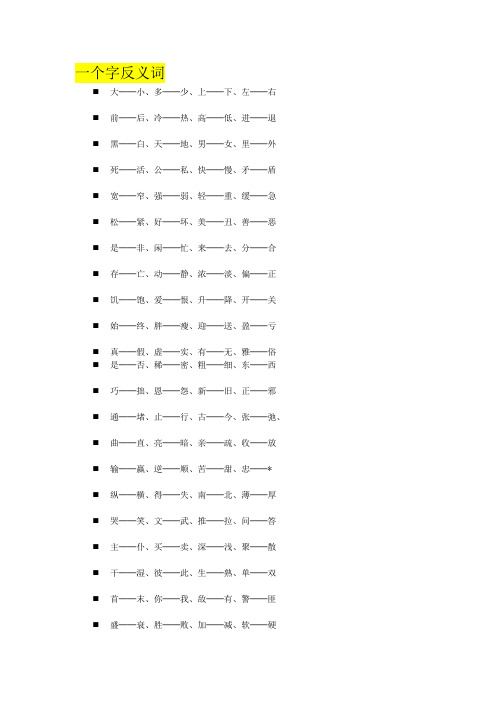
一个字反义词⏹大──小、多──少、上──下、左──右⏹前──后、冷──热、高──低、进──退⏹黑──白、天──地、男──女、里──外⏹死──活、公──私、快──慢、矛──盾⏹宽──窄、强──弱、轻──重、缓──急⏹松──紧、好──坏、美──丑、善──恶⏹是──非、闲──忙、来──去、分──合⏹存──亡、动──静、浓──淡、偏──正⏹饥──饱、爱──恨、升──降、开──关⏹始──终、胖──瘦、迎──送、盈──亏⏹真──假、虚──实、有──无、雅──俗⏹是──否、稀──密、粗──细、东──西⏹巧──拙、恩──怨、新──旧、正──邪⏹通──堵、止──行、古──今、张──弛、⏹曲──直、亮──暗、亲──疏、收──放⏹输──赢、逆──顺、苦──甜、忠──*⏹纵──横、得──失、南──北、薄──厚⏹哭──笑、文──武、推──拉、问──答⏹主──仆、买──卖、深──浅、聚──散⏹干──湿、彼──此、生──熟、单──双⏹首──末、你──我、敌──有、警──匪⏹盛──衰、胜──败、加──减、软──硬⏹阴──阳、顺──逆、反──正、祸──福⏹信──疑、错──对、藏──露、老──少⏹断──续、钝──锐、浓──淡、雌──雄⏹醒──睡、止──行、咸──淡、正──歪二个字的反义词⏹正常──异常、非凡──平凡、特别──一般⏹扫兴──高兴、轻蔑──敬重、开心──苦闷⏹寻常──异常、违背──遵循、怀疑──相信⏹强盛──衰败、尊重──侮辱、激烈──平静⏹嘈杂──寂静、美丽──丑陋、信奉──背弃⏹失信──守信、率领──追随、退化──进化⏹凝结──溶解、伟大──渺小、聚拢──分散⏹增添──减少、活泼──呆板、鲜艳──暗淡⏹严寒──酷暑、安谧──嘈杂、温暖──凉爽⏹柔和──严厉、拒绝──同意、清醒──糊涂⏹荒芜──耕种、清晰──浑浊、坚强──软弱⏹微云──浓云、纯熟──生疏、陌生──熟悉⏹平坦──崎岖、光滑──粗糙、慎重──随便⏹喜欢──厌恶、痛快──难受、幽静──喧闹⏹崎岖──平坦、刚强──软弱、慌忙──镇定⏹熟识──生疏、伶俐──笨拙、怕羞──大方⏹镇定──慌张、团结──分裂、羞涩──大方⏹严寒──炎热、洒脱──拘谨、明朗──阴沉⏹沉重──轻盈、迂回──径直、清澈──浑浊⏹脆弱──坚强、饱满──干瘪、衰弱──强健⏹犹豫──坚定、丰收──歉收、复杂──简单⏹淡妆──浓抹、相宜──不宜、自在──拘束⏹平常──奇特、勤劳──懒惰、喜欢──讨厌⏹密集──稀疏、胜利──失败、挺进──撤退⏹宽敞──狭窄、倾斜──竖直、闻名──无名⏹认识──陌生、有趣──乏味、舒畅──苦闷⏹结束──开始、紧张──轻松、整齐──纷乱⏹安全──危险、撒谎──诚实、慈祥──凶恶⏹可爱──可恶、紧张──轻松、仔细──粗心⏹附近──远方、赞许──反对、淡水──咸水⏹高兴──难过、飞快──缓慢、精彩──平淡⏹笨重──轻便、紧张──松弛、有趣──乏味⏹听从──违抗、诚实──虚伪、承认──否认⏹高兴──伤心、起劲──没劲、简单──复杂⏹容易──困难、熟练──生疏、准确──错误⏹温和──严厉、暴躁──温和、近处──远处⏹气愤──欢喜、粗心──细心、美丽──丑陋⏹洁白──乌黑、高兴──痛苦、宽阔──狭窄⏹新款──陈旧、兴旺──衰败、团结──分裂⏹敏捷──迟钝、危险──安全、常常──偶尔⏹幼稚──老练、含糊──清楚、严重──轻微⏹茂密──稀疏、光明──黑暗、微弱──强大⏹杰出──平庸、恶劣──良好、灿烂──暗淡⏹特殊──普通、异常──平常、简陋──豪华⏹诚意──假意、理屈──理直、拒绝──接受⏹惩罚──奖励、迟延──提前、示弱──逞强⏹好心──恶意、破碎──完整、酥软──坚硬⏹炎热──寒冷、诚实──撒谎、仔细──马虎⏹聪明──愚笨、空虚──充实、伶俐──笨拙⏹狭窄──宽阔、晦暗──明亮、勇敢──懦弱⏹宽容──严格、表扬──批评、一向──偶尔⏹善良──凶恶、寂静──热闹、聪明──愚笨⏹穷苦──富裕、精致──粗糙、健康──虚弱⏹忧虑──放心、糟糕──精彩、潮湿──干燥⏹喜欢──讨厌、危险──安全、寂寞──喧闹⏹奴隶──主人、紧张──松弛、统一──分裂⏹繁荣──衰败、精致──粗糙、权利──义务三个字的反义词⏹黑沉沉──亮堂堂、笑眯眯──哭啼啼、乐滋滋──悲切切⏹亮晶晶──黑乎乎、慢吞吞──急匆匆、瞧不起──瞧得起⏹黑黝黝──白花花、没出息──有出息、软绵绵──硬梆梆⏹暗沉沉──明朗朗、凉丝丝──热乎乎、乱哄哄──静悄悄⏹毛茸茸──光秃秃、乱蓬蓬──齐刷刷、雄纠纠──灰溜溜四个字的反义词⏹名副其实──名不副实、雪中送炭──雪上加霜⏹歪歪斜斜──端端正正、风平浪静──狂风恶浪⏹迷迷糊糊──清清楚楚、全神贯注──心不在焉⏹断断续续──连续不断、赏心悦目──触目惊心⏹一丝不苟──粗心大意、力倦神疲──精力充沛⏹万马奔腾──无声无息、暖暖和和──冷冷清清⏹吞吞吐吐──干干脆脆、毫不犹豫──犹豫不决⏹别具一格──普普通通、熙熙攘攘──冷冷清清⏹心惊肉跳──镇定自如、理直气壮──理屈词穷⏹一朝一夕──日久天长、悔过自新──执迷不悟⏹群策群力──孤掌难鸣、废寝忘食──饱食终日⏹沸沸扬扬──鸦雀无声、翻来覆去──简单明了⏹吵吵嚷嚷──冷冷清清、唇枪舌剑──心平气和⏹粗制滥造──精雕细刻、安居乐业──颠沛流离。
反义词大全
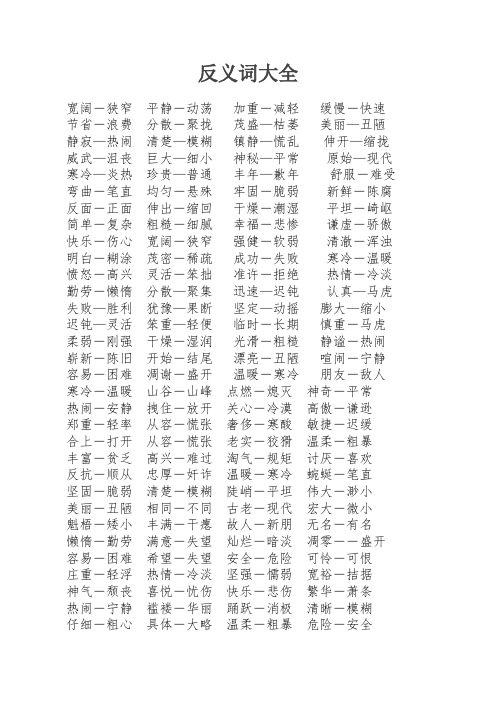
反义词大全宽阔―狭窄平静―动荡加重―减轻缓慢―快速节省―浪费分散―聚拢茂盛—枯萎美丽—丑陋静寂—热闹清楚—模糊镇静—慌乱伸开—缩拢威武—沮丧巨大—细小神秘—平常原始—现代寒冷—炎热珍贵—普通丰年—歉年舒服―难受弯曲―笔直均匀―悬殊牢固―脆弱新鲜―陈腐反面―正面伸出―缩回干燥―潮湿平坦―崎岖简单―复杂粗糙―细腻幸福―悲惨谦虚―骄傲快乐―伤心宽阔―狭窄强健―软弱清澈―浑浊明白―糊涂茂密―稀疏成功―失败寒冷―温暖愤怒―高兴灵活―笨拙准许―拒绝热情―冷淡勤劳―懒惰分散—聚集迅速—迟钝认真—马虎失败—胜利犹豫—果断坚定—动摇膨大—缩小迟钝—灵活笨重—轻便临时―长期慎重―马虎柔弱―刚强干燥―湿润光滑―粗糙静谧―热闹崭新―陈旧开始―结尾漂亮―丑陋喧闹―宁静容易―困难凋谢―盛开温暖―寒冷朋友―敌人寒冷―温暖山谷―山峰点燃―熄灭神奇―平常热闹―安静拽住―放开关心―冷漠高傲―谦逊郑重―轻率从容―慌张奢侈―寒酸敏捷―迟缓合上―打开从容―慌张老实―狡猾温柔―粗暴丰富―贫乏高兴―难过淘气―规矩讨厌―喜欢反抗―顺从忠厚―奸诈温暖―寒冷蜿蜒―笔直坚固―脆弱清楚―模糊陡峭―平坦伟大―渺小美丽―丑陋相同―不同古老―现代宏大―微小魁梧―矮小丰满―干瘪故人―新朋无名―有名懒惰―勤劳满意―失望灿烂―暗淡凋零――盛开容易―困难希望―失望安全―危险可怜―可恨庄重―轻浮热情―冷淡坚强―懦弱宽裕―拮据神气―颓丧喜悦―忧伤快乐―悲伤繁华―萧条热闹―宁静褴褛―华丽踊跃―消极清晰―模糊仔细―粗心具体―大略温柔―粗暴危险―安全匆匆―慢慢认识―陌生疏远―亲近聪明―愚蠢长处―短处现代―古代依赖―自立美好―丑陋舒适―艰苦输入―输出陌生―熟悉打开―关闭凶猛―温和笨重―轻巧迟钝―灵敏相似―相反特殊―一般美妙―蹩脚优良―低劣勤劳―懒惰正常—异常非凡—平凡特别—一般扫兴—高兴轻蔑—敬重开心—苦闷寻常—异常违背—遵循怀疑—相信强盛—衰败尊重—侮辱激烈—平静嘈杂—寂静美丽—丑陋信奉—背弃失信—守信率领—追随退化—进化凝结—溶解伟大—渺小聚拢—分散增添—减少活泼—呆板鲜艳—暗淡严寒—酷暑安谧—嘈杂温暖—凉爽柔和—严厉拒绝—同意清醒—糊涂荒芜—耕种清晰—浑浊坚强—软弱微云—浓云纯熟—生疏陌生—熟悉平坦—崎岖光滑—粗糙慎重—随便喜欢—厌恶痛快—难受幽静—喧闹崎岖—平坦刚强—软弱慌忙—镇定熟识—生疏伶俐—笨拙怕羞—大方镇定—慌张团结—分裂羞涩—大方严寒—炎热洒脱—拘谨明朗—阴沉沉重—轻盈迂回—径直清澈—浑浊脆弱—坚强饱满—干瘪衰弱—强健犹豫—坚定丰收—歉收复杂—简单淡妆—浓抹相宜—不宜自在—拘束平常—奇特勤劳—懒惰喜欢—讨厌密集—稀疏胜利—失败挺进—撤退宽敞—狭窄倾斜—竖直闻名—无名认识—陌生有趣—乏味舒畅—苦闷结束—开始紧张—轻松整齐—纷乱安全—危险撒谎—诚实慈祥—凶恶可爱—可恶紧张—轻松仔细—粗心附近—远方赞许—反对淡水—咸水高兴—难过飞快—缓慢精彩—平淡笨重—轻便紧张—松弛有趣---乏味听从—违抗诚实—虚伪承认—否认高兴—伤心起劲—没劲简单—复杂容易—困难熟练—生疏准确—错误温和—严厉暴躁—温和近处—远处气愤—欢喜粗心—细心美丽—丑陋洁白—乌黑高兴—痛苦宽阔—狭窄新款—陈旧兴旺—衰败团结—分裂敏捷—迟钝危险—安全常常—偶尔幼稚—老练含糊—清楚严重—轻微茂密—稀疏光明—黑暗微弱—强大杰出—平庸恶劣—良好灿烂—暗淡特殊—普通异常—平常简陋—豪华诚意—假意理屈—理直拒绝—接受惩罚—奖励迟延—提前示弱—逞强好心—恶意破碎—完整酥软—坚硬炎热—寒冷诚实—撒谎仔细—马虎聪明—愚笨空虚—充实伶俐—笨拙狭窄—宽阔晦暗—明亮勇敢—懦弱宽容—严格表扬—批评一向—偶尔善良—凶恶寂静—热闹聪明—愚笨穷苦—富裕精致—粗糙健康—虚弱忧虑—放心糟糕—精彩潮湿—干燥喜欢—讨厌危险—安全寂寞—喧闹奴隶—主人紧张—松弛统一—分裂繁荣—衰败精致—粗糙权利—义务俊俏—丑陋轻快—沉重鲜艳—暗淡增添—削减活泼—呆板聚拢—分散停止—开始玲珑—粗笨灵活—呆板陡峭—平坦特殊—一般送行—迎接舒适—难受悲惨—幸福愈合—开裂有名—无名镇定--慌张激烈--平静担心—放心成功—失败高兴—难受离开—回归害怕—勇敢忧伤—高兴飞快—缓慢严寒--温暖恶劣-优良湿润--干燥为难--容易狼狈--潇洒英勇--怯懦危险—安全朦胧—清楚便宜—昂贵喜欢—讨厌显赫—卑微朴素—奢华特殊—一般激动—平静蔑视—重视传统—现代亲近—疏远紧张—轻松坚强—软弱清楚—模糊魁梧—矮小失望—绝望感激—感谢失望—期望紧张—松懈宽阔―狭窄平静―动荡加重―减轻缓慢―快速节省―浪费分散―聚拢茂盛—枯萎美丽—丑陋静寂—热闹清楚—模糊镇静—慌乱伸开—缩拢威武—沮丧巨大—细小神秘—平常原始—现代寒冷—炎热珍贵—普通丰年—歉年舒服―难受弯曲―笔直均匀―悬殊牢固―脆弱新鲜―陈腐反面―正面伸出―缩回干燥―潮湿平坦―崎岖简单―复杂粗糙―细腻幸福―悲惨谦虚―骄傲快乐―伤心宽阔―狭窄强健―软弱清澈―浑浊明白―糊涂茂密―稀疏成功―失败寒冷―温暖愤怒―高兴灵活―笨拙准许―拒绝热情―冷淡勤劳―懒惰分散—聚集迅速—迟钝认真—马虎失败—胜利犹豫—果断坚定—动摇膨大—缩小迟钝—灵活笨重—轻便临时―长期慎重―马虎柔弱―刚强干燥―湿润光滑―粗糙静谧―热闹崭新―陈旧开始―结尾漂亮―丑陋喧闹―宁静容易―困难凋谢―盛开温暖―寒冷朋友―敌人寒冷―温暖山谷―山峰点燃―熄灭神奇―平常热闹―安静拽住―放开关心―冷漠高傲―谦逊郑重―轻率从容―慌张奢侈―寒酸敏捷―迟缓合上―打开从容―慌张老实―狡猾温柔―粗暴丰富―贫乏高兴―难过淘气―规矩讨厌―喜欢反抗―顺从忠厚―奸诈温暖―寒冷蜿蜒―笔直坚固―脆弱清楚―模糊陡峭―平坦伟大―渺小美丽―丑陋相同―不同古老―现代宏大―微小魁梧―矮小丰满―干瘪故人―新朋无名―有名懒惰―勤劳满意―失望灿烂―暗淡凋零―盛开容易―困难希望―失望幽静—喧闹安全―危险可怜―可恨庄重―轻浮热情―冷淡坚强―懦弱宽裕―拮据神气―颓丧喜悦―忧伤快乐―悲伤繁华―萧条热闹―宁静褴褛―华丽踊跃―消极清晰―模糊仔细―粗心具体―大略温柔―粗暴危险―安全匆匆―慢慢认识―陌生疏远―亲近聪明―愚蠢长处―短处现代―古代依赖―自立美好―丑陋舒适―艰苦输入―输出陌生―熟悉打开―关闭凶猛―温和笨重―轻巧迟钝―灵敏相似―相反特殊―一般美妙―蹩脚优良―低劣勤劳―懒惰正常—异常非凡—平凡特别—一般扫兴—高兴轻蔑—敬重开心—苦闷寻常—异常违背—遵循怀疑—相信强盛—衰败尊重—侮辱激烈—平静嘈杂—寂静美丽—丑陋信奉—背弃失信—守信率领—追随退化—进化凝结—溶解伟大—渺小聚拢—分散增添—减少活泼—呆板鲜艳—暗淡严寒—酷暑安谧—嘈杂温暖—凉爽柔和—严厉拒绝—同意清醒—糊涂荒芜—耕种清晰—浑浊坚强—软弱微云—浓云纯熟—生疏陌生—熟悉平坦—崎岖光滑—粗糙崎岖—平坦刚强—软弱慌忙—镇定熟识—生疏伶俐—笨拙怕羞—大方镇定—慌张团结—分裂羞涩—大方严寒—炎热洒脱—拘谨明朗—阴沉沉重—轻盈迂回—径直清澈—浑浊脆弱—坚强饱满—干瘪衰弱—强健犹豫—坚定丰收—歉收复杂—简单淡妆—浓抹相宜—不宜自在—拘束平常—奇特勤劳—懒惰喜欢—讨厌密集—稀疏胜利—失败挺进—撤退宽敞—狭窄倾斜—竖直闻名—无名认识—陌生有趣—乏味舒畅—苦闷结束—开始紧张—轻松整齐—纷乱安全—危险撒谎—诚实慈祥—凶恶可爱—可恶紧张—轻松仔细—粗心附近—远方赞许—反对淡水—咸水高兴—难过飞快—缓慢精彩—平淡笨重—轻便紧张—松弛有趣—乏味听从—违抗诚实—虚伪承认—否认高兴—伤心起劲—没劲简单—复杂容易—困难熟练—生疏准确—错误温和—严厉暴躁—温和近处—远处气愤—欢喜粗心—细心美丽—丑陋洁白—乌黑高兴—痛苦宽阔—狭窄新款—陈旧兴旺—衰败团结—分裂敏捷—迟钝危险—安全常常—偶尔幼稚—老练含糊—清楚严重—轻微茂密—稀疏光明—黑暗微弱—强大杰出—平庸恶劣—良好灿烂—暗淡特殊—普通异常—平常简陋—豪华诚意—假意理屈—理直拒绝—接受惩罚—奖励迟延—提前示弱—逞强好心—恶意破碎—完整酥软—坚硬炎热—寒冷诚实—撒谎仔细—马虎聪明—愚笨空虚—充实伶俐—笨拙狭窄—宽阔晦暗—明亮勇敢—懦弱宽容—严格表扬—批评一向—偶尔善良—凶恶寂静—热闹聪明—愚笨穷苦—富裕精致—粗糙健康—虚弱忧虑—放心糟糕—精彩潮湿—干燥喜欢—讨厌危险—安全寂寞—喧闹奴隶—主人紧张—松弛统一—分裂繁荣—衰败精致—粗糙权利—义务慎重—随便喜欢—厌恶痛快—难受富裕-贫穷接受-拒绝黎明-傍晚普通-特殊谦虚-骄傲坚硬-柔软公开-秘密大—小多—少上—下左—右前—后冷—热高—低进—退黑—白天—地男—女里—外死—活公—私快—慢矛—盾宽—窄强—弱轻—重缓—急松—紧好—坏美—丑善—恶是—非闲—忙来—去分—合存—亡动—静浓—淡偏—正凹―凸公―母朝―暮轻―重凉―暖浮―沉饥—饱爱—恨升—降开—关始—终胖—瘦迎—送盈—亏真—假虚—实有—无雅—俗是—否稀—密粗—细东—西巧—拙恩—怨新—旧正—邪通—堵止—行古—今张—弛曲—直亮—暗亲—疏收—放输—赢逆—顺苦—甜忠—奸纵—横得—失南—北薄—厚哭—笑文—武推—拉问—答主—仆买—卖深—浅聚—散干—湿彼—此生—熟单—双首—末你—我敌—友警—匪盛—衰胜—败加—减软—硬深—浅窄—宽远―近高―低冷―热横―竖同—异浑—清涨—降隐—现阴—阳顺—逆反—正祸—福信—疑错—对藏—露老—少断—续钝—锐浓—淡雌—雄醒—睡止—行咸—淡正—歪紧―松细―粗嫩―老无―有明―暗黑—白涨—降隐—现深—浅窄—宽远―近高―低冷―热横―竖同—异浑—清无―有紧―松明―暗细―粗嫩―老凹―凸浮―沉大—小多—少上—下左—右前—后冷—热高—低进—退黑—白天—地男—女里—外死—活公—私快—慢矛—盾宽—窄强—弱轻—重缓—急松—紧好—坏美—丑善—恶是—非闲—忙来—去分—合存—亡动—静浓—淡偏—正饥—饱爱—恨升—降开—关始—终胖—瘦迎—送盈—亏真—假虚—实有—无雅—俗是—否稀—密粗—细东—西巧—拙恩—怨新—旧正—邪通—堵止—行古—今张—弛曲—直亮—暗亲—疏收—放输—赢逆—顺苦—甜忠—奸纵—横得—失南—北薄—厚哭—笑文—武推—拉问—答主—仆买—卖深—浅聚—散干—湿彼—此生—熟单—双首—末你—我敌—友警—匪盛—衰胜—败加—减软—硬阴—阳顺—逆反—正祸—福信—疑错—对藏—露老—少断—续钝—锐浓—淡雌—雄醒—睡止—行咸—淡正—歪凉―暖矛-盾深-浅买-卖浓-淡善-恶明-暗朝―暮轻―重名副其实——名不副实雪中送炭——雪上加霜歪歪斜斜——端端正正风平浪静——狂风恶浪迷迷糊糊——清清楚楚全神贯注——心不在焉断断续续——连续不断赏心悦目——触目惊心一丝不苟——粗心大意力倦神疲——精力充沛万马奔腾——无声无息暖暖和和——冷冷清清吞吞吐吐——干干脆脆毫不犹豫——犹豫不决别具一格——普普通通熙熙攘攘——冷冷清清心惊肉跳——镇定自如理直气壮——理屈词穷一朝一夕——日久天长悔过自新——执迷不悟群策群力——孤掌难鸣废寝忘食——饱食终日沸沸扬扬——鸦雀无声翻来覆去——简单明了吵吵嚷嚷——冷冷清清唇枪舌剑——心平气和粗制滥造——精雕细刻安居乐业——颠沛流离勤勤恳恳―-懒懒散散隐隐约约―-清清楚楚享誉世界―默默无闻相背而行―相向而行一丝不苟―敷衍了事恍然大悟―百思不解筋疲力尽―精神抖擞柳暗花明—山穷水尽风平浪静—风号浪吼人声鼎沸――鸦雀无声一模一样—截然不同恍恍惚惚—清清楚楚端端正正--歪歪斜斜筋疲力尽—干劲十足面露愁容—面带微笑风平浪静—风号浪吼人声鼎沸―鸦雀无声恍恍惚惚—清清楚楚一模一样—截然不同笑盈盈—哭啼啼柳暗花明—山穷水尽勤勤恳恳―懒懒散散一丝不苟―敷衍了事隐隐约约―清清楚楚享誉世界―默默无闻相背而行――相向而行恍然大悟―百思不解筋疲力尽――精神抖擞名副其实——名不副实雪中送炭——雪上加霜歪歪斜斜——端端正正风平浪静——狂风恶浪迷迷糊糊——清清楚楚全神贯注——心不在焉断断续续——连续不断赏心悦目——触目惊心一丝不苟——粗心大意力倦神疲——精力充沛万马奔腾——无声无息暖暖和和——冷冷清清吞吞吐吐——干干脆脆毫不犹豫——犹豫不决别具一格——普普通通熙熙攘攘——冷冷清清心惊肉跳——镇定自如理直气壮——理屈词穷一朝一夕——日久天长悔过自新——执迷不悟群策群力——孤掌难鸣废寝忘食——饱食终日沸沸扬扬——鸦雀无声翻来覆去——简单明了吵吵嚷嚷——冷冷清清唇枪舌剑——心平气和粗制滥造——精雕细刻安居乐业——颠沛流离近义词兴许—也许轻巧—轻松迸裂—裂开炎热—酷热率先—首先忙碌—劳碌欣赏—赏识寻觅—寻找会晤—会见感触—感受振奋—振作生气—生机慈祥—慈爱晋谒—拜谒震动—震惊清楚—清晰朴素—简朴尊重—敬重著名—闻名伺候—服侍特殊—特别坚强—顽强担任—担当简单—简洁成竹在胸—胸有成竹呼唤—召唤安身—安家。
反义词大全

高—低
快—慢
升—降
入—出
开—关
斜—正
落—升
冷—热
饿—饱
贫—富
死—活
穷—富
买—卖
旧—新
细—粗
明—暗
首—尾
始—终
洁白—漆黑
美丽—丑陋
退化—进化
凝结—溶解
伟大—渺小
聚拢—分散
增添—减少
活泼—呆板
鲜艳—暗淡
严寒—酷暑
安谧—嘈杂
温暖—凉爽
柔和—严厉
拒绝—同意
清醒—糊涂
荒芜—耕种
清晰—浑浊
坚强—软弱
微云—浓云
纯熟—生疏
陌生—熟悉
平坦—崎岖
光滑—粗糙
迎—送
盈—亏
真—假
虚—实
有—无
雅—俗
是—否
稀—密
粗—细
东—西
巧—拙
恩—怨
新—旧
正—邪
通—堵
止—行
古—今
张—弛
曲—直
亮—暗
亲—疏
收—放
输—赢
逆—顺
苦—甜
忠—奸
纵—横
得—失
南—北
薄—厚
极小—极大
温和—暴躁
好事—坏事
奔跑—停止
灾害—幸福
坚硬—松软
堵塞—畅通
贵重—便宜
锋利—迟钝
聚集—分散
新鲜—陈旧
破碎—完整
未来—现在
诚实—狡猾
可爱—可恨
活泼—呆板
赶紧—拖延
反义词大全

反义词大全(学习必备)宽阔――狭窄平静――动荡风平浪静—风号浪吼涨—降隐—现人声鼎沸――鸦雀无声加重――减轻缓慢――快速节省――浪费分散――聚拢茂盛—枯萎美丽—丑陋静寂—热闹清楚—模糊镇静—慌乱伸开—缩拢威武—沮丧笑盈盈—哭啼啼恍恍惚惚—清清楚楚一模一样—截然不同巨大—细小神秘—平常原始—现代寒冷—炎热珍贵—普通深—浅窄—宽远――近高――低冷――热横――竖同—异浑—清丰年—歉年柳暗花明—山穷水尽舒服――难受弯曲――笔直紧――松均匀――悬殊牢固――脆弱新鲜――陈腐无――有明――暗反面――正面伸出――缩回细――粗嫩――老干燥――潮湿平坦――崎岖简单――复杂粗糙――细腻幸福――悲惨谦虚――骄傲快乐――伤心宽阔――狭窄强健――软弱清澈――浑浊勤勤恳恳――懒懒散散明白――糊涂茂密――稀疏成功――失败寒冷――温暖愤怒――高兴灵活――笨拙准许――拒绝热情――冷淡勤劳――懒惰分散—聚集迅速—迟钝认真—马虎失败—胜利犹豫—果断坚定—动摇膨大—缩小迟钝—灵活笨重—轻便临时――长期慎重――马虎柔弱――刚强干燥――湿润光滑――粗糙静谧――热闹凹――凸崭新――陈旧开始――结尾漂亮――丑陋喧闹――宁静容易――困难凋谢――盛开温暖――寒冷朋友――敌人寒冷――温暖山谷――山峰点燃――熄灭神奇――平常笑嘻嘻――哭兮兮热闹――安静拽住――放开关心――冷漠高傲――谦逊郑重――轻率从容――慌张一丝不苟――敷衍了事奢侈――寒酸敏捷――迟缓公――母合上――打开浮――沉从容――慌张老实――狡猾温柔――粗暴丰富――贫乏高兴――难过淘气――规矩讨厌――喜欢反抗――顺从忠厚――奸诈温暖――寒冷蜿蜒――笔直坚固――脆弱清楚――模糊陡峭――平坦伟大――渺小美丽――丑陋相同――不同古老――现代隐隐约约――清清楚楚享誉世界――默默无闻宏大――微小魁梧――矮小丰满――干瘪故人――新朋朝――暮轻――重无名――有名凉――暖懒惰――勤劳满意――失望相背而行――相向而行灿烂――暗淡凋零――盛开容易――困难希望――失望安全――危险可怜――可恨庄重――轻浮热情――冷淡坚强――懦弱恍然大悟――百思不解宽裕――拮据神气――颓丧喜悦――忧伤快乐――悲伤繁华――萧条热闹――宁静;褴褛――华丽踊跃――消极清晰――模糊仔细――粗心具体――大略温柔――粗暴危险――安全匆匆――慢慢筋疲力尽――精神抖擞认识――陌生疏远――亲近聪明――愚蠢长处――短处现代――古代依赖――自立美好――丑陋舒适――艰苦输入――输出陌生――熟悉打开――关闭凶猛――温和笨重――轻巧迟钝――灵敏相似――相反特殊――一般美妙――蹩脚优良――低劣勤劳――懒惰大——小多——少上——下左——右前——后冷——热高——低进——退黑——白天——地男——女里——外死——活公——私快——慢矛——盾宽——窄强——弱轻——重缓——急松——紧好——坏美——丑善——恶是——非闲——忙来——去分——合存——亡动——静浓——淡偏——正饥——饱爱——恨升——降开——关始——终胖——瘦迎——送盈——亏真——假虚——实有——无雅——俗是——否稀——密粗——细东——西巧——拙恩——怨新——旧正——邪通——堵止——行古——今张——弛曲——直亮——暗亲——疏收——放输——赢逆——顺苦——甜忠——奸纵——横得——失南——北薄——厚哭——笑文——武推——拉问——答主——仆买——卖深——浅聚——散干——湿彼——此生——熟单——双首——末你——我敌——友警——匪盛——衰胜——败加——减软——硬阴——阳顺——逆反——正祸——福信——疑错——对藏——露老——少断——续钝——锐浓——淡雌——雄醒——睡止——行咸——淡正——歪名副其实——名不副实雪中送炭——雪上加霜歪歪斜斜——端端正正风平浪静——狂风恶浪迷迷糊糊——清清楚楚全神贯注——心不在焉断断续续——连续不断赏心悦目——触目惊心一丝不苟——粗心大意力倦神疲——精力充沛万马奔腾——无声无息暖暖和和——冷冷清清吞吞吐吐——干干脆脆毫不犹豫——犹豫不决别具一格——普普通通熙熙攘攘——冷冷清清心惊肉跳——镇定自如理直气壮——理屈词穷一朝一夕——日久天长悔过自新——执迷不悟群策群力——孤掌难鸣废寝忘食——饱食终日沸沸扬扬——鸦雀无声翻来覆去——简单明了吵吵嚷嚷——冷冷清清唇枪舌剑——心平气和粗制滥造——精雕细刻安居乐业——颠沛流离正常——异常非凡——平凡特别——一般扫兴——高兴轻蔑——敬重开心——苦闷寻常——异常违背——遵循怀疑——相信强盛——衰败尊重——侮辱激烈——平静嘈杂——寂静美丽——丑陋信奉——背弃失信——守信率领——追随退化——进化凝结——溶解伟大——渺小聚拢——分散增添——减少活泼——呆板鲜艳——暗淡严寒——酷暑安谧——嘈杂温暖——凉爽柔和——严厉拒绝——同意清醒——糊涂荒芜——耕种清晰——浑浊坚强——软弱微云——浓云纯熟——生疏陌生——熟悉平坦——崎岖光滑——粗糙慎重——随便喜欢——厌恶痛快——难受幽静——喧闹崎岖——平坦刚强——软弱慌忙——镇定熟识——生疏伶俐——笨拙怕羞——大方镇定——慌张团结——分裂羞涩——大方严寒——炎热洒脱——拘谨明朗——阴沉沉重——轻盈迂回——径直清澈——浑浊脆弱——坚强饱满——干瘪衰弱——强健犹豫——坚定丰收——歉收复杂——简单淡妆——浓抹相宜——不宜自在——拘束平常——奇特勤劳——懒惰喜欢——讨厌密集——稀疏胜利——失败挺进——撤退宽敞——狭窄倾斜——竖直闻名——无名认识——陌生有趣——乏味舒畅——苦闷结束——开始紧张——轻松整齐——纷乱安全——危险撒谎——诚实慈祥——凶恶可爱——可恶紧张——轻松仔细——粗心附近——远方赞许——反对淡水——咸水高兴——难过飞快——缓慢精彩——平淡笨重——轻便紧张——松弛有趣——乏味听从——违抗诚实——虚伪承认——否认高兴——伤心起劲——没劲简单——复杂容易——困难熟练——生疏准确——错误温和——严厉暴躁——温和近处——远处气愤——欢喜粗心——细心美丽——丑陋洁白——乌黑高兴——痛苦宽阔——狭窄新款——陈旧兴旺——衰败团结——分裂敏捷——迟钝危险——安全常常——偶尔幼稚——老练含糊——清楚严重——轻微茂密——稀疏光明——黑暗微弱——强大杰出——平庸恶劣——良好灿烂——暗淡特殊——普通异常——平常简陋——豪华诚意——假意理屈——理直拒绝——接受惩罚——奖励迟延——提前示弱——逞强好心——恶意破碎——完整酥软——坚硬炎热——寒冷诚实——撒谎仔细——马虎聪明——愚笨空虚——充实伶俐——笨拙狭窄——宽阔晦暗——明亮勇敢——懦弱宽容——严格表扬——批评一向——偶尔善良——凶恶寂静——热闹聪明——愚笨穷苦——富裕精致——粗糙健康——虚弱忧虑——放心糟糕——精彩潮湿——干燥喜欢——讨厌危险——安全寂寞——喧闹奴隶——主人紧张——松弛统一——分裂繁荣——衰败精致——粗糙权利——义务黑—雪白俊俏—丑陋轻快—沉重鲜艳—暗淡增添—削减活泼—呆板聚拢—分散停止—开始玲珑—粗笨灵活—呆板陡峭—平坦特殊—一般送行—迎接舒适—难受悲惨—幸福愈合—开裂有名—无名离开—回归害怕—勇敢忧伤—高兴飞快—缓慢成功—失败镇定--慌张严寒--温暖恶劣-优良湿润--干燥为难--容易端端正正--歪歪斜斜激烈--平静狼狈--潇洒英勇--怯懦惬意——满意惊讶——吃惊朦胧——模糊优惠——优待精巧——精致完美——完善反驳——反对逻辑——规律反义词:危险——安全担心——放心朦胧——清楚高兴——难受便宜——昂贵喜欢——讨厌筋疲力尽——干劲十足兴许——也许轻巧——轻松率先——首先忙碌——劳碌欣赏——赏识寻觅——寻找会晤——会见感触——感受振奋——振作生气——生机慈祥——慈爱成竹在胸——胸有成竹反义词:魁梧——矮小敏锐—... 失望——绝望感激——感谢反义词:失望——期望紧张——松懈面露愁容——面带微笑一、近义词与反义词近义词:晋谒——拜谒震动——震惊朴素——简朴尊重——敬重著名——闻名伺候——服侍特殊——特别坚强——顽强担任——担当简单——简洁清楚——清晰反义词:显赫——卑微朴素——奢华特殊——一般激动——平静蔑视——重视传统——现代亲近——疏远紧张——轻松坚强——软弱清楚——模糊近义词:迸裂——裂开炎热——酷热呼唤——召唤安身——安家富裕对贫穷接受对拒绝黎明对傍晚普通对特殊矛对盾深对浅买对卖浓对淡善对恶明对暗谦虚对骄傲坚硬对柔软公开对秘密宽阔――狭窄平静――动荡风平浪静—风号浪吼涨—降隐—现人声鼎沸――鸦雀无声加重――减轻缓慢――快速节省――浪费分散――聚拢茂盛—枯萎美丽—丑陋静寂—热闹清楚—模糊镇静—慌乱伸开—缩拢威武—沮丧笑盈盈—哭啼啼恍恍惚惚—清清楚楚一模一样—截然不同巨大—细小神秘—平常原始—现代寒冷—炎热珍贵—普通深—浅窄—宽远――近高――低冷――热横――竖同—异浑—清丰年—歉年柳暗花明—山穷水尽舒服――难受弯曲――笔直紧――松均匀――悬殊牢固――脆弱新鲜――陈腐无――有明――暗反面――正面伸出――缩回细――粗嫩――老干燥――潮湿平坦――崎岖简单――复杂粗糙――细腻幸福――悲惨谦虚――骄傲快乐――伤心宽阔――狭窄强健――软弱清澈――浑浊勤勤恳恳――懒懒散散明白――糊涂茂密――稀疏成功――失败寒冷――温暖愤怒――高兴灵活――笨拙准许――拒绝热情――冷淡勤劳――懒惰分散—聚集迅速—迟钝认真—马虎失败—胜利犹豫—果断坚定—动摇膨大—缩小迟钝—灵活笨重—轻便临时――长期慎重――马虎柔弱――刚强干燥――湿润光滑――粗糙静谧――热闹凹――凸崭新――陈旧开始――结尾漂亮――丑陋喧闹――宁静容易――困难凋谢――盛开温暖――寒冷朋友――敌人寒冷――温暖山谷――山峰点燃――熄灭神奇――平常笑嘻嘻――哭兮兮热闹――安静拽住――放开关心――冷漠高傲――谦逊郑重――轻率从容――慌张一丝不苟――敷衍了事奢侈――寒酸敏捷――迟缓公――母合上――打开浮――沉从容――慌张老实――狡猾∙∙温柔――粗暴丰富――贫乏高兴――难过淘气――规矩讨厌――喜欢反抗――顺从忠厚――奸诈温暖――寒冷蜿蜒――笔直坚固――脆弱清楚――模糊陡峭――平坦伟大――渺小美丽――丑陋相同――不同古老――现代隐隐约约――清清楚楚享誉世界――默默无闻宏大――微小魁梧――矮小丰满――干瘪故人――新朋朝――暮轻――重无名――有名凉――暖懒惰――勤劳满意――失望相背而行――相向而行灿烂――暗淡凋零――盛开容易――困难希望――失望安全――危险可怜――可恨庄重――轻浮热情――冷淡坚强――懦弱恍然大悟――百思不解宽裕――拮据神气――颓丧喜悦――忧伤快乐――悲伤繁华――萧条热闹――宁静;褴褛――华丽踊跃――消极清晰――模糊仔细――粗心具体――大略温柔――粗暴危险――安全匆匆――慢慢筋疲力尽――精神抖擞认识――陌生疏远――亲近聪明――愚蠢长处――短处现代――古代依赖――自立美好――丑陋舒适――艰苦输入――输出陌生――熟悉打开――关闭凶猛――温和笨重――轻巧迟钝――灵敏相似――相反特殊――一般美妙――蹩脚优良――低劣勤劳――懒惰大——小多——少上——下左——右前——后冷——热高——低进——退黑——白天——地男——女里——外死——活公——私快——慢矛——盾宽——窄强——弱轻——重缓——急松——紧好——坏美——丑善——恶是——非闲——忙来——去分——合存——亡动——静浓——淡偏——正饥——饱爱——恨升——降开——关始——终胖——瘦迎——送盈——亏真——假虚——实有——无雅——俗是——否稀——密粗——细东——西巧——拙恩——怨新——旧正——邪通——堵止——行古——今张——弛曲——直亮——暗亲——疏收——放输——赢逆——顺苦——甜忠——奸纵——横得——失南——北薄——厚哭——笑文——武推——拉问——答主——仆买——卖深——浅聚——散干——湿彼——此生——熟单——双首——末你——我敌——友警——匪盛——衰胜——败加——减软——硬阴——阳顺——逆反——正祸——福信——疑错——对藏——露老——少断——续钝——锐浓——淡雌——雄醒——睡止——行咸——淡正——歪∙名副其实——名不副实雪中送炭——雪上加霜歪歪斜斜——端端正正风平浪静——狂风恶浪迷迷糊糊——清清楚楚全神贯注——心不在焉断断续续——连续不断赏心悦目——触目惊心一丝不苟——粗心大意力倦神疲——精力充沛万马奔腾——无声无息暖暖和和——冷冷清清吞吞吐吐——干干脆脆毫不犹豫——犹豫不决别具一格——普普通通熙熙攘攘——冷冷清清心惊肉跳——镇定自如理直气壮——理屈词穷一朝一夕——日久天长悔过自新——执迷不悟群策群力——孤掌难鸣废寝忘食——饱食终日沸沸扬扬——鸦雀无声翻来覆去——简单明了吵吵嚷嚷——冷冷清清唇枪舌剑——心平气和粗制滥造——精雕细刻安居乐业——颠沛流离∙<img border="0" fakesize="1" height="48"。
反义词大全500对

反义词大全500对1.高-低2.大-小3.强-弱4.快-慢5.亮-暗6.干燥-潮湿7.热-冷8.简单-复杂9.短-长10.宽-窄11.美-丑12.真-假13.轻-重14.新-旧15.平-斜16.平静-紧张17.正确-错误18.善良-邪恶19.简短-冗长20.安静-喧闹21.优点-缺点22.大胆-胆小23.真诚-虚伪24.透明-不透明25.丰富-贫乏26.好-坏27.开放-封闭28.充满-空虚29.有趣-无聊30.忠诚-背叛31.充足-不足32.健康-疾病33.整洁-肮脏34.繁忙-闲散35.活跃-懒散36.安全-危险37.老-年轻38.平坦-崎岖39.柔软-硬40.公正-不公正41.善-恶42.繁荣-衰退43.兴奋-没精神44.贵-便宜45.忠实-背信弃义46.有序-混乱47.安慰-不安48.隐私-公开49.舒适-不舒适50.慷慨-吝啬51.自由-束缚52.成功-失败53.乐观-悲观54.慢慢-快速55.和谐-不和谐56.正常-异常57.善良-邪恶58.勤奋-懒惰59.善良-邪恶60.清洁-肮脏61.真实-虚假62.爱-恨63.平和-紧张64.顺利-困难65.喜悦-悲伤66.积极-消极67.可靠-不可靠68.前进-后退69.温暖-寒冷70.清晰-模糊71.合理-不合理72.高兴-郁闷73.勇敢-胆怯74.多-少75.安详-不安详76.勇猛-胆小77.顺序-混乱78.智慧-愚蠢79.真诚-虚伪80.完美-不完美81.活力-无力82.宽容-偏见83.持久-短暂84.善良-邪恶85.真理-谎言86.悲观-乐观87.满足-不满足88.恢复-恶化89.欢迎-拒绝90.繁荣-衰退91.正直-不诚实92.忍耐-不耐烦93.尊重-轻视94.安全-危险95.喜爱-厌恶96.安宁-骚乱97.放松-紧张98.真实-虚假99.幸福-不幸100.成功-失败101.活跃-懒散102.平等-不公103.坚定-犹豫104.真心-假意105.亲密-疏远106.利益-损失107.自信-不自信108.美丽-丑陋109.无私-自私110.快乐-悲伤111.清醒-迷糊112.饥饿-饱食113.勇敢-胆怯114.热情-冷漠115.宽容-偏见116.成熟-不成熟117.真挚-虚伪118.适应-抗拒119.充满-空虚120.健康-疾病121.整洁-肮脏122.愉快-不快123.独立-依赖125.知识-无知126.安详-不安详127.谦虚-自负128.慷慨-吝啬129.自由-束缚130.成功-失败131.乐观-悲观132.慢慢-快速133.和谐-不和谐134.正常-异常135.笑容-哭泣136.勤奋-懒惰137.光明-黑暗138.清洁-肮脏139.真实-虚假140.完美-有缺陷141.坚强-脆弱142.善意-恶意143.虚弱-强壮144.敏捷-迟缓145.亲切-冷漠146.平衡-失衡147.安逸-不安逸148.喜笑-哭泣149.秩序-混乱150.清醒-迷糊151.和平-战争152.感激-不感激153.独立-依赖154.正直-不诚实155.高尚-卑劣156.宽恕-报复157.阳光-阴暗158.软弱-强大159.尊敬-蔑视160.忍耐-不耐烦161.公正-不公正162.喜悦-痛苦163.组织-混乱164.智慧-愚蠢165.祝福-诅咒166.珍惜-忽视167.支持-反对168.自豪-羞耻169.热心-冷漠170.平静-紧张171.平等-不平等172.强壮-虚弱173.开放-封闭174.温柔-粗鲁175.适应-抗拒176.善良-邪恶177.勇敢-胆怯178.幸福-不幸179.成功-失败180.亮-暗181.真实-虚假182.安全-危险183.充足-不足184.充满-空虚185.清洁-肮脏186.活跃-懒散187.透明-不透明188.安宁-不安189.舒适-不舒适190.慷慨-吝啬191.忠诚-背叛192.平坦-崎岖193.柔软-硬194.安慰-不安195.隐私-公开196.满意-不满意197.协作-对立198.朴实-虚华199.喜爱-厌恶200.喧闹-安静201.激烈-温和202.乐意-勉强203.畅通-堵塞204.高效-低效205.容易-困难206.富裕-贫穷207.正派-邪恶208.融洽-矛盾209.简略-详细210.公开-秘密211.喜闻-忧闻212.卓越-平庸213.温和-残酷214.温暖-冰冷215.充满-空虚216.乐观-悲观217.有序-混乱218.刺激-平淡219.省时-浪费220.喜庆-悲伤221.灵活-刚性222.井然-杂乱223.发展-停滞224.宽敞-狭窄225.喜爱-厌恶226.舒适-不舒适227.健全-脆弱228.快乐-悲伤229.积极-消极230.深-浅231.热情-冷漠232.开放-封闭233.多-少234.长-短235.直接-间接236.延迟-提前237.和谐-不和谐238.轻松-紧张239.正确-错误240.主动-被动241.公正-不公正242.虚伪-真实243.幸福-不幸244.快速-缓慢245.满足-不满足246.独立-依赖247.前进-后退248.清晰-模糊249.勇敢-胆怯250.安详-不安详251.善意-恶意252.真诚-虚伪253.完美-有缺陷254.坚强-脆弱255.慷慨-吝啬256.自由-束缚257.成功-失败258.乐观-悲观259.慢慢-快速260.和谐-不和谐261.正常-异常262.263.勤奋-懒散264. 265.清洁-肮脏266.真实-虚假267.完美-有缺陷268.坚强-脆弱269.慷慨-吝啬270.自由-束缚271.成功-失败272.乐观-悲观273.慢慢-快速274.和谐-不和谐275.正常-异常276. 277.勤奋-懒散278. 279.清洁-肮脏280.真实-虚假281.完美-有缺陷282.坚强-脆弱283.慷慨-吝啬284.自由-束缚285.成功-失败286.乐观-悲观287.慢慢-快速288.和谐-不和谐289.正常-异常290. 291.勤奋-懒散292.293.清洁-肮脏294.真实-虚假295.完美-有缺陷296.坚强-脆弱297.慷慨-吝啬298.自由-束缚299.成功-失败300.乐观-悲观301.慢慢-快速302.和谐-不和谐303.正常-异常304.305.勤奋-懒散306. 307.清洁-肮脏308.真实-虚假309.完美-有缺陷310.坚强-脆弱311.慷慨-吝啬312.自由-束缚313.成功-失败314.乐观-悲观315.慢慢-快速316.和谐-不和谐317.正常-异常318. 319.勤奋-懒散320. 321.清洁-肮脏322.真实-虚假323.完美-有缺陷324.坚强-脆弱325.慷慨-吝啬326.自由-束缚327.成功-失败328.乐观-悲观329.慢慢-快速330.和谐-不和谐331.正常-异常332. 333.勤奋-懒散334.335.清洁-肮脏336.真实-虚假337.完美-有缺陷338.坚强-脆弱339.慷慨-吝啬340.自由-束缚341.成功-失败342.乐观-悲观343.慢慢-快速344.和谐-不和谐345.正常-异常346.347.勤奋-懒散348. 349.清洁-肮脏350.真实-虚假351.完美-有缺陷352.坚强-脆弱353.慷慨-吝啬354.自由-束缚355.成功-失败356.乐观-悲观357.慢慢-快速358.和谐-不和谐359.正常-异常360. 361.勤奋-懒散362. 363.清洁-肮脏364.真实-虚假365.完美-有缺陷366.坚强-脆弱367.慷慨-吝啬368.自由-束缚369.成功-失败370.乐观-悲观371.慢慢-快速372.和谐-不和谐373.正常-异常374. 375.勤奋-懒散376.377.清洁-肮脏378.真实-虚假379.完美-有缺陷380.坚强-脆弱381.慷慨-吝啬382.自由-束缚383.成功-失败384.乐观-悲观385.慢慢-快速386.和谐-不和谐387.正常-异常388.389.勤奋-懒散390. 391.清洁-肮脏392.真实-虚假393.完美-有缺陷394.坚强-脆弱395.慷慨-吝啬396.自由-束缚397.成功-失败398.乐观-悲观399.慢慢-快速400.和谐-不和谐401.正常-异常402. 403.勤奋-懒散404. 405.清洁-肮脏406.真实-虚假407.完美-有缺陷408.坚强-脆弱409.慷慨-吝啬410.自由-束缚411.成功-失败412.乐观-悲观413.慢慢-快速414.和谐-不和谐415.正常-异常416. 417.勤奋-懒散418.419.清洁-肮脏420.真实-虚假421.完美-有缺陷422.坚强-脆弱423.慷慨-吝啬424.自由-束缚425.成功-失败426.乐观-悲观427.慢慢-快速428.和谐-不和谐429.正常-异常430.431.勤奋–懒惰432. 433.清洁-肮脏434.真实-虚假435.完美-有缺陷436.坚强-脆弱437.慷慨-吝啬438.自由-束缚439.成功-失败440.乐观-悲观441.慢慢-快速442.和谐-不和谐443.正常-异常444. 445.勤奋-懒446. 447.清洁-肮脏448.真实-虚假449.完美-有缺陷450.坚强-脆弱451.慷慨-吝啬452.自由-束缚453.成功-失败454.乐观-悲观455.慢慢-快速456.和谐-不和谐457.正常-异常458. 459.勤奋-懒460.461.清洁-肮脏462.真实-虚假463.完美-有缺陷464.坚强-脆弱465.慷慨-吝啬466.自由-束缚467.成功-失败468.乐观-悲观469.慢慢-快速470.和谐-不和谐471.正常-异常472.473.勤奋-懒474. 475.清洁-肮脏476.真实-虚假477.完美-有缺陷478.坚强-脆弱479.慷慨-吝啬480.自由-束缚481.成功-失败482.乐观-悲观483.慢慢-快速484.和谐-不和谐485.正常-异常486. 487.勤奋-懒488. 489.清洁-肮脏490.真实-虚假491.完美-有缺陷492.坚强-脆弱493.慷慨-吝啬494.自由-束缚495.成功-失败496.乐观-悲观497.慢慢-快速498.和谐-不和谐499.正常-异常500.。
反义词大全

胖—瘦香—臭明—暗忙—闲凉—暖来—去尖—钝好—坏轻—重前—后左—右是—非有—无老—少深—浅高—低快—慢升—降入—出开—关斜—正落—升冷—热饿—饱贫—富死—活穷—富买—卖旧—新细—粗明—暗首—尾始—终洁白—漆黑美丽—丑陋仔细—马虎告别—会合舒服—难受粗心—细心出发—归来安宁—喧闹宽敞—狭窄困难—容易热闹—寂静空闲—忙碌打开—关闭流动—固定暖和—寒冷弯曲—笔直微笑—悲伤昂首—低头开始—结束现在—将来喜欢—讨厌欢快—沉重机灵—愚笨明白—糊涂希望—失望傍晚—清晨秘密—公开高大—矮小坚定—动摇张开—合拢经常—偶尔愤怒—高兴坚定—犹豫清楚—模糊熟悉—陌生保护—破坏勇敢—懦弱聪明—愚蠢失败—成功敞开—关闭飞快—缓慢明白—糊涂失败—成功烦恼—高兴特殊—一般特别—普通漂亮—丑陋高兴—伤心仔细—粗心精彩—枯燥洁净—肮脏心爱—厌恶飞快—缓慢极小—极大温和—暴躁好事—坏事奔跑—停止灾害—幸福坚硬—松软堵塞—畅通贵重—便宜锋利—迟钝聚集—分散新鲜—陈旧破碎—完整未来—现在诚实—狡猾可爱—可恨活泼—呆板赶紧—拖延透明—浑浊凉爽—炎热永远—短暂凉爽—闷热广阔—狭小相信—怀疑裂开—合拢相信—怀疑节省—浪费亲密—疏远高明—低劣热闹—冷清喜欢—讨厌茁壮—虚弱得意洋洋—垂头丧气斜—歪脚—足肥—胖降—落找—寻心惊肉跳—胆战心惊丝毫未动—未动分毫祝愿—祝福茁壮—强壮召唤—呼唤嘱咐—叮嘱希望—盼望闪烁—闪耀希望—盼望袭击—攻击打扰—打搅暖和—温和拜访—访问艳丽—鲜艳节省—节约美丽—漂亮快乐—欢乐时光—时间惊讶—惊奇亲密—亲切依然—依旧高明—高超喜欢—喜爱热闹—喧闹开心—快乐举行—进行凉爽—凉快广大—广阔永远—永久消失—消灭饥荒—饥饿广阔—宽阔飞翔—飞行奇怪—惊奇眨眼—瞬间聚集—聚拢根据—依据诚实—老实未来—将来称赞—赞扬发现—发觉赶紧—抓紧快乐—高兴解落—降落波纹—波浪颤动—颤抖颤动—抖动破碎—破裂珍珠—珍宝财富—财宝锋利—锐利伤心—难过高兴—快乐连忙—赶忙拦住—挡住极小—微小漂浮—漂移平时—平常奔跑—奔驰温和—温顺灾害—灾难帮助—关心温和—亲切无数—很多愿意—同意立刻—连忙如果—假如仔细—认真传说—传奇目录—名目招聘—聘请洁净—干净特殊—特别聆听—倾听领袖—首领盼望—希望费力—费劲使劲—用劲救护—抢救挑选—选择本事—本领烦恼—苦恼究竟—毕竟拼命—舍命浪费—白费干净—洁净录取—录用聊天—谈天盼望—希望耽误—耽搁敞开—放开躲藏—隐藏胆量—胆识飞快—飞速比赛—竞赛害怕—可怕亲爱—友爱保护—爱护谢谢—感谢清楚—清晰渐渐—慢慢面颊—脸蛋脖子—颈项歌唱—唱歌寻找—查找拾起—捡起办法—方法告别—离别准备—预备洁白—雪白美丽—秀丽出发—动身观察—观看很多—许多宾客—来宾安宁—安静逃窜—逃跑突然—忽然宽阔宽敞热闹—吵闹住所—住宅闪现—出现寺庙—寺院卧室—卧房流动—流淌连忙—赶忙忽然—突然好似—好像连忙—急忙正要—刚要浮上—浮现辽阔—宽阔昂首—仰头眼力—视力故乡—家乡本事—本领劝告—劝说依赖—依靠何必—为必凭着—靠着机灵—机智奔走—奔跑秘密—隐秘专心—用心著名—闻名奇怪—惊奇发现—发明好象—仿佛有趣—有味愤怒—气愤坚定—坚决仍旧—照旧弯弯曲曲—曲曲折折连绵不断—连绵起伏赞不绝口—赞叹不已反义词人声鼎沸—鸦雀无声不可计数—屈指可数生气勃勃—死气沉沉呼风唤雨—息事宁人坚固—松散凝结—离散陡峭—平坦伟大—渺小精美—粗俗温顺—凶猛沸腾—沉寂壮丽—晦暗呈现—消失静寂—嘈杂便宜—昂贵迟钝—敏捷兴奋—忧愁美丽—丑陋天堂—地狱模糊—清晰羡慕—不屑朦胧—清晰凶猛—温柔不识—相识舒服—难受弯曲—笔直懒惰—勤快宽裕—拮据隐藏—公开平坦—坎坷柔弱—坚强干燥—潮湿古老—现代故人—新交蜿蜒—笔直凝结-溶解增长—减短崭新—陈旧静谧—吵闹简单—复杂勇猛—怯懦附近—遥远寒冷—温暖温柔—凶恶尽职—失职轻盈—笨重隐隐约约—清清楚楚明—暗此—彼朝—暮闲-忙紧—松伸—缩扩散(聚集)微波(巨浪)聚集(分散)明艳(暗淡)蜿蜒(笔直)善良(凶恶)精湛(生疏)马虎(认真)生疏(熟练)卓越(普通)伟大(渺小)稀(密)朴实(华丽)安全(危险)冷淡(热情)伤害(保护)踌躇(果断)松散(紧凑)频繁(稀少)减产(增产)下降(上升)破坏(保护)容易(困难)灵巧(笨重)敏锐(迟钝)揭开(覆盖)立刻(迟缓)清楚(模糊)宽敞(狭窄)平衡(倾斜)提高(降低)沉寂(喧闹)黝黑(白皙)和平(战争)流畅(阻塞)坚强(柔弱)歪歪斜斜-端端正正枝繁叶茂-枯枝败叶垂头丧气-昂首挺胸迷惑不解-恍然大悟遵从(违反)骄傲(谦虚)完整(残缺)坚硬(柔软)糟蹋(爱惜)有限(无限)失望(希望)开阔(狭窄)清晰(模糊)温暖(寒冷)明白(疑惑)朴素(华丽)独特(普通)微弱(强烈)漆黑(明亮)消失(出现)责备(表扬)公开(秘密)固执(随和)特别(一般)明亮(暗淡)细致(粗糙)舒畅(难受)疑惑(明白)坚毅(动摇)容易(困难)成功(失败)悲惨(幸福)违抗(遵从)纯洁(混浊)错误(正确)坚定(动摇)凶恶(善良)违背(遵从)明白(糊涂)聚拢(分散)偶尔(经常)俊俏(丑陋)乌黑(洁白)光滑(粗糙)轻快(沉重)漂浮(沉浸)静止(移动)匿藏(暴露)漆黑(光明)温柔(粗暴)明澈(混浊)悠闲(忙碌)自在(拘束)枯萎(茂盛)依赖(自立)从容(慌张)优美(丑陋)粗俗(文雅)承认(否定)朦胧(清晰)疲倦(充沛)焦急(耐心)放肆(拘束)漂亮(丑陋)违抗(服从)陌生(熟悉)幽静(喧闹)警惕(麻痹)惦记(放心)打消(产生)难过(高兴)骄傲(谦虚)紧张(轻松)关切(冷淡)喜欢(讨厌)真理(谬论)强健(瘦弱)清晰(模糊)沉醉(苏醒)鲜明(暗淡)清凉(燥热)仰望(俯视)歇息-工作平坦-陡峭善良-凶恶片刻-长久僵硬-柔软注视-扫视狰狞-慈祥贫瘠-肥沃强大-弱小遭殃-幸运温柔-粗暴敏感-迟钝变化莫测-一成不变荒无人烟-人烟稠密震耳欲聋-鸦雀无声前赴后继-畏缩不前批评-表扬担心-放心倔强-柔顺明白-糊涂相信-怀疑镇定-惊慌稀少-稠密狭窄-宽阔慌忙-从容毅然-犹豫方便-麻烦便宜-昂贵爱慕-厌恶合拢-张开昏暗-明亮维护-破坏损失-受益清晰-模糊暖-寒缓-急宽-窄甘-苦外-内先-后利-钝鬻-买闲-忙干燥-湿润精通-生疏温暖-寒冷痛苦-欢乐故意-无意防御-进攻温和-凶狠可爱-讨厌黑暗-光明悦耳-刺耳伤害-保护神奇-普通发展-落后拥有-失去吝啬-大方幼稚-成熟含糊-清楚严重-轻微毫不犹豫-犹豫不决理直气壮-理屈词穷心惊肉跳-镇定自若一丝不苟-马马虎虎茂密-稀疏灿烂-黯淡团结-分裂兴旺-衰败特殊-普通歧视-重视杰出-平庸恶劣-良好显赫-卑微迟延-提前惩罚-奖励魁梧-矮小增添-减少朴素-奢侈蔑视-尊重诚意-假意拒绝-接受示弱-逞强好心-恶意破碎-完整酥软-坚硬炎热-寒冷仔细-马虎聪明-愚蠢力倦神疲-精力充沛熙熙攘攘-冷冷清清完整无缺-支离破碎隐隐约约-清清楚楚空虚-充实伶俐-笨拙诚实-说谎狭窄-宽阔晦暗-明亮勇敢-懦弱宽容-狭隘简陋-豪华异常-平常魁梧-瘦弱精致-粗糙幸福-痛苦穷苦-富裕忧虑-放心蜷缩-伸直潮湿-干燥统一-分裂紧张-松弛寂寞-热闹危险-安全喜欢-讨厌繁荣-衰败淘气-老实大概-精确坚定-动摇忧伤-快乐漆黑-明亮节省-浪费寒冷-炎热悲伤-愉快俯-仰浮-沉饱-饥寒-暖隐-现漫不经心-全神贯注心平气和-暴跳如雷筋疲力尽-精神抖擞人声鼎沸-鸦雀无声垂头丧气-兴高采烈人山人海-寥寥无几愁眉紧锁-喜笑颜开不计其数-屈指可数持续-中断吃力-轻松凉爽-温暖消失-显现险峻-平缓茂盛-枯萎喧闹-寂静美丽-丑陋暴躁-温顺腼腆-大方减少-增加笨重-灵巧出色-一般熟悉-陌生骄傲-谦虚懦弱-坚强平静-动荡仪表-内心贫穷-富裕弯曲-笔直牢固-松散超常-失常沮丧-兴奋保护-破坏新鲜-腐烂集中-分散凝聚-分散粗糙-光滑藏匿-公开郑重-随意高昂-低落自在-拘束扩大-缩小柔和-严厉刚强-软弱出现-消失衰老-年轻淡雅-浓艳清醒-糊涂熟识-生疏伶俐-笨拙害羞-大方倾斜-竖直复杂-简单深沉-肤浅肯定-否定团结-分裂洒脱-拘谨明朗-阴沉迂回-径直残破-完整簇拥-分散陡峭-平缓热烈-平静沉着-惊慌坚强-脆弱崎岖-平坦严寒-酷暑慌忙-镇定安谧-嘈杂朴素-华丽健美-衰弱拘束-随便老实-狡猾个性-共性沉甸甸-轻飘飘深奥-浅显详细-简略贫瘠-肥沃敬佩-鄙视迅速-缓慢耐心-急躁名副其实-名不副实雪中送炭-雪上加霜歪歪斜斜-端端正正马马虎虎-认认真真扩散-集中综合-分解密切-疏远洪亮-低沉嘲笑-称赞遗憾-圆满盛气凌人-平易近人万古长青-昙花一现断断续续-连续不断目瞪口呆-谈笑自若重逢-离别偶尔-经常稀罕-平常寻常-特殊迅猛-缓慢慷慨-吝啬存在-消失朦胧-清晰浏览-精读冲锋-退却揳入-退出隐蔽-暴露精彩-糟糕放肆-谨慎及时-耽误快活-忧伤厄运-好运宠儿-弃儿指望-失望厌倦-喜爱平庸-优秀允许-禁止机灵-笨拙俊俏-丑陋漂浮-沉没精细-粗糙辽阔-狭小神奇-平庸特别-一般喜欢-讨厌黯淡-鲜亮关切-冷落真理-谬误开放-凋谢开放-封闭强壮-虚弱疑惑-坚信强盛-衰弱尊重-侮辱失信-守信坚强-软弱掩盖-揭露发掘-埋没承受-推却约莫-一定推测-断定镇定-紧张严寒-酷暑笨重-轻盈临时-长期严肃-活泼挺进-撤退湍急-平缓沉寂-喧闹抑制-张扬危险-安全清晰-浑浊漫不经心-专心致志垂头丧-气扬眉吐气宽阔――狭窄平静――动荡风平浪静—风号浪吼涨—降隐—现人声鼎沸――鸦雀无声加重――减轻缓慢――快速节省――浪费分散――聚拢茂盛—枯萎美丽—丑陋静寂—热闹清楚—模糊镇静—慌乱伸开—缩拢威武—沮丧笑盈盈—哭啼啼恍恍惚惚—清清楚楚一模一样—截然不同巨大—细小神秘—平常原始—现代寒冷—炎热珍贵—普通深—浅窄—宽远――近高――低冷――热横――竖同—异浑—清丰年—歉年柳暗花明—山穷水尽舒服――难受弯曲――笔直紧――松均匀――悬殊牢固――脆弱新鲜――陈腐无――有明――暗反面――正面伸出――缩回细――粗嫩――老干燥――潮湿平坦――崎岖简单――复杂粗糙――细腻幸福――悲惨谦虚――骄傲快乐――伤心宽阔――狭窄强健――软弱清澈――浑浊勤勤恳恳――懒懒散散明白――糊涂茂密――稀疏成功――失败寒冷――温暖愤怒――高兴灵活――笨拙准许――拒绝热情――冷淡勤劳――懒惰分散—聚集迅速—迟钝认真—马虎失败—胜利犹豫—果断坚定—动摇膨大—缩小迟钝—灵活笨重—轻便临时――长期慎重――马虎柔弱――刚强干燥――湿润光滑――粗糙静谧――热闹凹――凸崭新――陈旧开始――结尾漂亮――丑陋喧闹――宁静容易――困难凋谢――盛开温暖――寒冷朋友――敌人寒冷――温暖山谷――山峰点燃――熄灭神奇――平常笑嘻嘻――哭兮兮热闹――安静拽住――放开关心――冷漠高傲――谦逊郑重――轻率从容――慌张一丝不苟――敷衍了事奢侈――寒酸敏捷――迟缓公――母合上――打开浮――沉从容――慌张老实――狡猾温柔――粗暴丰富――贫乏高兴――难过淘气――规矩讨厌――喜欢反抗――顺从忠厚――奸诈温暖――寒冷蜿蜒――笔直坚固――脆弱清楚――模糊陡峭――平坦伟大――渺小美丽――丑陋相同――不同古老――现代隐隐约约――清清楚楚享誉世界――默默无闻宏大――微小魁梧――矮小丰满――干瘪故人――新朋朝――暮轻――重无名――有名凉――暖懒惰――勤劳满意――失望相背而行――相向而行灿烂――暗淡凋零――盛开容易――困难希望――失望安全――危险可怜――可恨庄重――轻浮热情――冷淡坚强――懦弱恍然大悟――百思不解宽裕――拮据神气――颓丧喜悦――忧伤快乐――悲伤繁华――萧条热闹――宁静褴褛――华丽踊跃――消极清晰――模糊仔细――粗心具体――大略温柔――粗暴危险――安全匆匆――慢慢筋疲力尽――精神抖擞认识――陌生疏远――亲近聪明――愚蠢长处――短处现代――古代依赖――自立美好――丑陋舒适――艰苦输入――输出陌生――熟悉打开――关闭凶猛――温和笨重――轻巧迟钝――灵敏相似――相反特殊――一般美妙――蹩脚优良――低劣勤劳――懒惰大——小多——少上——下左——右前——后冷——热高——低进——退黑——白天——地男——女里——外死——活公——私快——慢矛——盾宽——窄强——弱轻——重缓——急松——紧好——坏美——丑善——恶是——非闲——忙来——去分——合存——亡动——静浓——淡偏——正饥——饱爱——恨升——降开——关始——终胖——瘦迎——送盈——亏真——假虚——实有——无雅——俗是——否稀——密粗——细东——西巧——拙恩——怨新——旧正——邪通——堵止——行古——今张——弛曲——直亮——暗亲——疏收——放输——赢逆——顺苦——甜忠——奸纵——横得——失南——北薄——厚哭——笑文——武推——拉问——答主——仆买——卖深——浅聚——散干——湿彼——此生——熟单——双首——末你——我敌——友警——匪盛——衰胜——败加——减软——硬阴——阳顺——逆反——正祸——福信——疑错——对藏——露老——少断——续钝——锐浓——淡雌——雄醒——睡止——行咸——淡正——歪名副其实——名不副实雪中送炭——雪上加霜歪歪斜斜——端端正正风平浪静——狂风恶浪迷迷糊糊——清清楚楚全神贯注——心不在焉断断续续——连续不断赏心悦目——触目惊心一丝不苟——粗心大意力倦神疲——精力充沛万马奔腾——无声无息暖暖和和——冷冷清清吞吞吐吐——干干脆脆毫不犹豫——犹豫不决别具一格——普普通通熙熙攘攘——冷冷清清心惊肉跳——镇定自如理直气壮——理屈词穷一朝一夕——日久天长悔过自新——执迷不悟群策群力——孤掌难鸣废寝忘食——饱食终日沸沸扬扬——鸦雀无声翻来覆去——简单明了吵吵嚷嚷——冷冷清清唇枪舌剑——心平气和粗制滥造—精雕细刻安居乐业——颠沛流离正常——异常非凡——平凡特别——一般扫兴——高兴轻蔑——敬重开心——苦闷寻常——异常违背——遵循怀疑——相信强盛——衰败尊重——侮辱激烈——平静嘈杂——寂静美丽——丑陋信奉——背弃失信——守信率领——追随退化——进化凝结——溶解伟大——渺小聚拢——分散增添——减少活泼——呆板鲜艳——暗淡严寒——酷暑安谧——嘈杂温暖——凉爽柔和——严厉拒绝——同意清醒——糊涂荒芜——耕种清晰——浑浊坚强——软弱微云——浓云纯熟——生疏陌生——熟悉平坦——崎岖光滑——粗糙慎重——随便喜欢——厌恶痛快——难受幽静——喧闹崎岖——平坦刚强——软弱慌忙——镇定熟识——生疏伶俐——笨拙怕羞——大方镇定——慌张团结——分裂羞涩——大方严寒——炎热洒脱——拘谨明朗——阴沉沉重——轻盈迂回——径直清澈——浑浊脆弱——坚强饱满——干瘪衰弱——强健犹豫——坚定丰收——歉收复杂——简单淡妆——浓抹相宜——不宜自在——拘束平常——奇特勤劳——懒惰喜欢——讨厌密集——稀疏胜利——失败挺进——撤退宽敞——狭窄倾斜——竖直闻名——无名认识——陌生有趣——乏味舒畅——苦闷结束——开始紧张——轻松整齐——纷乱安全——危险撒谎——诚实慈祥——凶恶可爱——可恶紧张——轻松仔细——粗心附近——远方赞许——反对淡水——咸水高兴——难过飞快——缓慢精彩——平淡笨重——轻便紧张——松弛有趣——乏味听从——违抗诚实——虚伪承认——否认高兴——伤心起劲——没劲简单——复杂容易——困难熟练——生疏准确——错误温和——严厉暴躁——温和近处——远处气愤——欢喜粗心——细心美丽——丑陋洁白——乌黑高兴——痛苦宽阔——狭窄新款——陈旧兴旺——衰败团结——分裂敏捷——迟钝危险——安全常常——偶尔幼稚——老练含糊——清楚严重——轻微茂密——稀疏光明——黑暗微弱——强大杰出——平庸恶劣——良好灿烂——暗淡特殊——普通异常——平常简陋——豪华诚意——假意理屈——理直拒绝——接受惩罚——奖励迟延——提前示弱——逞强好心——恶意破碎——完整酥软——坚硬炎热——寒冷诚实——撒谎仔细——马虎聪明——愚笨空虚——充实伶俐——笨拙狭窄——宽阔晦暗——明亮勇敢——懦弱宽容——严格表扬——批评一向——偶尔善良——凶恶寂静——热闹聪明——愚笨穷苦——富裕精致——粗糙健康——虚弱忧虑——放心糟糕——精彩潮湿——干燥喜欢——讨厌危险——安全寂寞——喧闹奴隶—主人紧张——松弛统一——分裂繁荣——衰败精致——粗糙权利——义务黑—白俊俏—丑陋轻快—沉重鲜艳—暗淡增添—削减活泼—呆板聚拢—分散停止—开始玲珑—粗笨灵活—呆板陡峭—平坦特殊—一般送行—迎接舒适—难受悲惨—幸福愈合—开裂有名—无名离开—回归害怕—勇敢忧伤—高兴飞快—缓慢成功—失败镇定--慌张严寒--温暖恶劣-优良湿润--干燥为难--容易端端正正--歪歪斜斜激烈--平静狼狈--潇洒英勇--怯懦惬意——满意惊讶——吃惊朦胧——模糊优惠——优待精巧——精致完美——完善反驳——反对逻辑——规律危险——安全担心——放心朦胧——清楚高兴——难受便宜——昂贵喜欢——讨厌筋疲力尽——干劲十足兴许——也许轻巧——轻松率先——首先忙碌——劳碌欣赏——赏识寻觅——寻找会晤——会见感触——感受振奋——振作生气——生机慈祥——慈爱成竹在胸——胸有成竹魁梧——矮小失望——绝望感激——感谢失望——期望紧张——松懈面露愁容——面带微笑。
反义词大全

反义词大全宽阔――狭窄平静――动荡风平浪静—风号浪吼涨—降隐—现人声鼎沸――鸦雀无声加重――减轻缓慢――快速节省――浪费分散――聚拢茂盛—枯萎美丽—丑陋静寂—热闹清楚—模糊镇静—慌乱伸开—缩拢威武—沮丧笑盈盈—哭啼啼恍恍惚惚—清清楚楚一模一样—截然不同巨大—细小神秘—平常原始—现代寒冷—炎热珍贵—普通深—浅窄—宽远――近高――低冷――热横――竖同—异浑—清丰年—歉年柳暗花明—山穷水尽舒服――难受弯曲――笔直紧――松均匀――悬殊牢固――脆弱新鲜――陈腐无――有明――暗反面――正面伸出――缩回细――粗嫩――老干燥――潮湿平坦――崎岖简单――复杂粗糙――细腻幸福――悲惨谦虚――骄傲快乐――伤心宽阔――狭窄强健――软弱清澈――浑浊勤勤恳恳――懒懒散散明白――糊涂茂密――稀疏成功――失败寒冷――温暖愤怒――高兴灵活――笨拙准许――拒绝热情――冷淡勤劳――懒惰分散—聚集迅速—迟钝认真—马虎失败—胜利犹豫—果断坚定—动摇膨大—缩小迟钝—灵活笨重—轻便临时――长期慎重――马虎柔弱――刚强干燥――湿润光滑――粗糙静谧――热闹凹――凸崭新――陈旧开始――结尾漂亮――丑陋喧闹――宁静容易――困难凋谢――盛开温暖――寒冷朋友――敌人寒冷――温暖山谷――山峰点燃――熄灭神奇――平常笑嘻嘻――哭兮兮热闹――安静拽住――放开关心――冷漠高傲――谦逊郑重――轻率从容――慌张一丝不苟――敷衍了事奢侈――寒酸敏捷――迟缓公――母合上――打开浮――沉从容――慌张老实――狡猾温柔――粗暴丰富――贫乏高兴――难过淘气――规矩讨厌――喜欢反抗――顺从忠厚――奸诈温暖――寒冷蜿蜒――笔直坚固――脆弱清楚――模糊陡峭――平坦伟大――渺小美丽――丑陋相同――不同古老――现代隐隐约约――清清楚楚享誉世界――默默无闻宏大――微小魁梧――矮小丰满――干瘪故人――新朋朝――暮轻――重无名――有名凉――暖懒惰――勤劳满意――失望相背而行――相向而行灿烂――暗淡凋零――盛开容易――困难希望――失望安全――危险可怜――可恨庄重――轻浮热情――冷淡坚强――懦弱恍然大悟――百思不解宽裕――拮据神气――颓丧喜悦――忧伤快乐――悲伤繁华――萧条热闹――宁静;褴褛――华丽踊跃――消极清晰――模糊仔细――粗心具体――大略温柔――粗暴危险――安全匆匆――慢慢筋疲力尽――精神抖擞认识――陌生疏远――亲近聪明――愚蠢长处――短处现代――古代依赖――自立美好――丑陋舒适――艰苦输入――输出陌生――熟悉打开――关闭凶猛――温和笨重――轻巧迟钝――灵敏相似――相反特殊――一般美妙――蹩脚优良――低劣勤劳――懒惰大——小多——少上——下左——右前——后冷——热高——低进——退黑——白天——地男——女里——外死——活公——私快——慢矛——盾宽——窄强——弱轻——重缓——急松——紧好——坏美——丑善——恶是——非闲——忙来——去分——合存——亡动——静浓——淡偏——正饥——饱爱——恨升——降开——关始——终胖——瘦迎——送盈——亏真——假虚——实有——无雅——俗是——否稀——密粗——细东——西巧——拙恩——怨新——旧正——邪通——堵止——行古——今张——弛曲——直亮——暗亲——疏收——放输——赢逆——顺苦——甜忠——奸纵——横得——失南——北薄——厚哭——笑文——武推——拉问——答主——仆买——卖深——浅聚——散干——湿彼——此生——熟单——双首——末你——我敌——友警——匪盛——衰胜——败加——减软——硬阴——阳顺——逆反——正祸——福信——疑错——对藏——露老——少断——续钝——锐浓——淡雌——雄醒——睡止——行咸——淡正——歪名副其实——名不副实雪中送炭——雪上加霜歪歪斜斜——端端正正风平浪静——狂风恶浪迷迷糊糊——清清楚楚全神贯注——心不在焉断断续续——连续不断赏心悦目——触目惊心一丝不苟——粗心大意力倦神疲——精力充沛万马奔腾——无声无息暖暖和和——冷冷清清吞吞吐吐——干干脆脆毫不犹豫——犹豫不决别具一格——普普通通熙熙攘攘——冷冷清清心惊肉跳——镇定自如理直气壮——理屈词穷一朝一夕——日久天长悔过自新——执迷不悟群策群力——孤掌难鸣废寝忘食——饱食终日沸沸扬扬——鸦雀无声翻来覆去——简单明了吵吵嚷嚷——冷冷清清唇枪舌剑——心平气和粗制滥造——精雕细刻安居乐业——颠沛流离端端正正——歪歪斜斜筋疲力尽——干劲十足成竹在胸——胸有成竹面露愁容——面带微笑风平浪静—风号浪吼人声鼎沸――鸦雀无声正常——异常非凡——平凡特别——一般扫兴——高兴轻蔑——敬重开心——苦闷寻常——异常违背——遵循怀疑——相信强盛——衰败尊重——侮辱激烈——平静嘈杂——寂静美丽——丑陋信奉——背弃失信——守信率领——追随退化——进化凝结——溶解伟大——渺小聚拢——分散增添——减少活泼——呆板鲜艳——暗淡严寒——酷暑安谧——嘈杂温暖——凉爽柔和——严厉拒绝——同意清醒——糊涂荒芜——耕种清晰——浑浊坚强——软弱微云——浓云纯熟——生疏陌生——熟悉平坦——崎岖光滑——粗糙慎重——随便喜欢——厌恶痛快——难受幽静——喧闹崎岖——平坦刚强——软弱慌忙——镇定熟识——生疏伶俐——笨拙怕羞——大方镇定——慌张团结——分裂羞涩——大方严寒——炎热洒脱——拘谨明朗——阴沉沉重——轻盈迂回——径直清澈——浑浊脆弱——坚强饱满——干瘪衰弱——强健犹豫——坚定丰收——歉收复杂——简单淡妆——浓抹相宜——不宜自在——拘束平常——奇特勤劳——懒惰喜欢——讨厌密集——稀疏胜利——失败挺进——撤退宽敞——狭窄倾斜——竖直闻名——无名认识——陌生有趣——乏味舒畅——苦闷结束——开始紧张——轻松整齐——纷乱安全——危险撒谎——诚实慈祥——凶恶可爱——可恶紧张——轻松仔细——粗心附近——远方赞许——反对淡水——咸水高兴——难过飞快——缓慢精彩——平淡笨重——轻便紧张——松弛有趣——乏味听从——违抗诚实——虚伪承认——否认高兴——伤心起劲——没劲简单——复杂容易——困难熟练——生疏准确——错误温和——严厉暴躁——温和近处——远处气愤——欢喜粗心——细心美丽——丑陋洁白——乌黑高兴——痛苦宽阔——狭窄新款——陈旧兴旺——衰败团结——分裂敏捷——迟钝危险——安全常常——偶尔幼稚——老练含糊——清楚严重——轻微茂密——稀疏光明——黑暗微弱——强大杰出——平庸恶劣——良好灿烂——暗淡特殊——普通异常——平常简陋——豪华诚意——假意理屈——理直拒绝——接受惩罚——奖励迟延——提前示弱——逞强好心——恶意破碎——完整酥软——坚硬炎热——寒冷诚实——撒谎仔细——马虎聪明——愚笨空虚——充实伶俐——笨拙狭窄——宽阔晦暗——明亮勇敢——懦弱宽容——严格表扬——批评一向——偶尔善良——凶恶寂静——热闹聪明——愚笨穷苦——富裕精致——粗糙健康——虚弱忧虑——放心糟糕——精彩潮湿——干燥喜欢——讨厌危险——安全寂寞——喧闹奴隶——主人紧张——松弛统一——分裂繁荣——衰败精致——粗糙权利——义务乌黑——雪白俊俏——丑陋轻快——沉重鲜艳——暗淡增添——削减活泼——呆板聚拢——分散停止——开始玲珑——粗笨灵活——呆板陡峭——平坦特殊——一般送行——迎接舒适——难受悲惨——幸福愈合——开裂有名——无名离开——回归害怕——勇敢忧伤——高兴飞快——缓慢成功——失败镇定--——慌张严寒——温暖恶劣——优良湿润——干燥为难——容易激烈——平静狼狈——潇洒英勇——怯懦惬意——满意惊讶——吃惊朦胧——模糊优惠——优待精巧——精致完美——完善反驳——反对逻辑——规律危险——安全担心——放心朦胧——清楚高兴——难受便宜——昂贵喜欢——讨厌兴许——也许轻巧——轻松率先——首先忙碌——劳碌欣赏——赏识寻觅——寻找会晤——会见感触——感受振奋——振作生气——生机慈祥——慈爱魁梧——矮小敏锐—. .失望——绝望感激——感谢失望——期望紧张——松懈近义词:晋谒——拜谒震动——震惊朴素——简朴尊重——敬重著名——闻名伺候——服侍特殊——特别坚强——顽强担任——担当简单——简洁清楚——清晰迸裂——裂开炎热——酷热呼唤——召唤安身——安家反义词显赫——卑微朴素——奢华特殊——一般激动——平静蔑视——重视传统——现代亲近——疏远紧张——轻松坚强——软弱清楚——模糊富裕——贫穷接受——拒绝黎明——傍晚普通——特殊谦虚——骄傲坚硬——柔软公开——秘密宽阔――狭窄平静――动荡涨—降隐—现加重――减轻缓慢――快速节省――浪费分散――聚拢茂盛—枯萎美丽—丑陋静寂—热闹清楚—模糊镇静—慌乱伸开—缩拢威武—沮丧笑盈盈—哭啼啼巨大—细小神秘—平常原始—现代寒冷—炎热珍贵—普通丰年—歉年舒服――难受弯曲――笔直紧――松均匀――悬殊牢固――脆弱新鲜――陈腐反面――正面伸出――缩回干燥――潮湿平坦――崎岖简单――复杂粗糙――细腻幸福――悲惨谦虚――骄傲快乐――伤心宽阔――狭窄强健――软弱清澈――浑浊明白――糊涂茂密――稀疏成功――失败寒冷――温暖愤怒――高兴灵活――笨拙准许――拒绝热情――冷淡勤劳――懒惰分散—聚集迅速—迟钝认真—马虎失败—胜利犹豫—果断坚定—动摇膨大—缩小迟钝—灵活笨重—轻便临时――长期慎重――马虎柔弱――刚强干燥――湿润光滑――粗糙静谧――热闹崭新――陈旧开始――结尾漂亮――丑陋喧闹――宁静容易――困难凋谢――盛开温暖――寒冷朋友――敌人寒冷――温暖山谷――山峰点燃――熄灭神奇――平常笑嘻嘻――哭兮兮热闹――安静拽住――放开关心――冷漠高傲――谦逊郑重――轻率从容――慌张奢侈――寒酸敏捷――迟缓合上――打开从容――慌张老实――狡猾温柔――粗暴丰富――贫乏高兴――难过淘气――规矩讨厌――喜欢反抗――顺从忠厚――奸诈温暖――寒冷蜿蜒――笔直坚固――脆弱清楚――模糊陡峭――平坦伟大――渺小美丽――丑陋相同――不同古老――现代宏大――微小魁梧――矮小丰满――干瘪故人――新朋朝――暮无名――有名懒惰――勤劳满意――失望灿烂――暗淡凋零――盛开容易――困难希望――失望安全――危险可怜――可恨庄重――轻浮热情――冷淡坚强――懦弱宽裕――拮据神气――颓丧喜悦――忧伤快乐――悲伤繁华――萧条热闹――宁静;褴褛――华丽踊跃――消极清晰――模糊仔细――粗心具体――大略温柔――粗暴危险――安全匆匆――慢慢认识――陌生疏远――亲近聪明――愚蠢长处――短处现代――古代依赖――自立美好――丑陋舒适――艰苦输入――输出陌生――熟悉打开――关闭凶猛――温和笨重――轻巧迟钝――灵敏相似――相反特殊――一般美妙――蹩脚优良――低劣勤劳――懒惰恍恍惚惚—清清楚楚柳暗花明—山穷水尽一模一样—截然不同勤勤恳恳――懒懒散散一丝不苟――敷衍了事隐隐约约――清清楚楚享誉世界――默默无闻相背而行――相向而行恍然大悟――百思不解筋疲力尽――精神抖擞名副其实——名不副实雪中送炭——雪上加霜歪歪斜斜——端端正正风平浪静——狂风恶浪迷迷糊糊——清清楚楚全神贯注——心不在焉断断续续——连续不断赏心悦目——触目惊心一丝不苟——粗心大意力倦神疲——精力充沛万马奔腾——无声无息暖暖和和——冷冷清清吞吞吐吐——干干脆脆毫不犹豫——犹豫不决别具一格——普普通通熙熙攘攘——冷冷清清心惊肉跳——镇定自如理直气壮——理屈词穷一朝一夕——日久天长悔过自新——执迷不悟群策群力——孤掌难鸣废寝忘食——饱食终日沸沸扬扬——鸦雀无声翻来覆去——简单明了吵吵嚷嚷——冷冷清清唇枪舌剑——心平气和粗制滥造——精雕细刻安居乐业——颠沛流离正常——异常非凡——平凡特别——一般扫兴——高兴轻蔑——敬重开心——苦闷寻常——异常违背——遵循怀疑——相信强盛——衰败尊重——侮辱激烈——平静嘈杂——寂静美丽——丑陋信奉——背弃失信——守信率领——追随退化——进化凝结——溶解伟大——渺小聚拢——分散增添——减少活泼——呆板鲜艳——暗淡严寒——酷暑安谧——嘈杂温暖——凉爽柔和——严厉拒绝——同意清醒——糊涂荒芜——耕种清晰——浑浊坚强——软弱微云——浓云纯熟——生疏陌生——熟悉平坦——崎岖光滑——粗糙慎重——随便喜欢——厌恶痛快——难受幽静——喧闹崎岖——平坦刚强——软弱慌忙——镇定熟识——生疏伶俐——笨拙怕羞——大方镇定——慌张团结——分裂羞涩——大方严寒——炎热洒脱——拘谨明朗——阴沉沉重——轻盈迂回——径直清澈——浑浊脆弱——坚强饱满——干瘪衰弱——强健犹豫——坚定丰收——歉收复杂——简单淡妆——浓抹相宜——不宜自在——拘束平常——奇特勤劳——懒惰喜欢——讨厌密集——稀疏胜利——失败挺进——撤退宽敞——狭窄倾斜——竖直闻名——无名认识——陌生有趣——乏味舒畅——苦闷结束——开始紧张——轻松整齐——纷乱安全——危险撒谎——诚实慈祥——凶恶可爱——可恶紧张——轻松仔细——粗心附近——远方赞许——反对淡水——咸水高兴——难过飞快——缓慢精彩——平淡笨重——轻便紧张——松弛有趣——乏味听从——违抗诚实——虚伪承认——否认高兴——伤心起劲——没劲简单——复杂容易——困难熟练——生疏准确——错误温和——严厉暴躁——温和近处——远处气愤——欢喜粗心——细心美丽——丑陋洁白——乌黑高兴——痛苦宽阔——狭窄新款——陈旧兴旺——衰败团结——分裂敏捷——迟钝危险——安全常常——偶尔幼稚——老练含糊——清楚严重——轻微茂密——稀疏光明——黑暗微弱——强大杰出——平庸恶劣——良好灿烂——暗淡特殊——普通异常——平常简陋——豪华诚意——假意理屈——理直拒绝——接受惩罚——奖励迟延——提前示弱——逞强好心——恶意破碎——完整酥软——坚硬炎热——寒冷诚实——撒谎仔细——马虎聪明——愚笨空虚——充实伶俐——笨拙狭窄——宽阔晦暗——明亮勇敢——懦弱宽容——严格表扬——批评一向——偶尔善良——凶恶寂静——热闹聪明——愚笨穷苦——富裕精致——粗糙健康——虚弱忧虑——放心糟糕——精彩潮湿——干燥喜欢——讨厌危险——安全寂寞——喧闹奴隶——主人紧张——松弛统一——分裂繁荣——衰败精致——粗糙权利——义务乌黑——雪白俊俏——丑陋轻快——沉重鲜艳——暗淡增添——削减活泼——呆板聚拢——分散停止——开始玲珑——粗笨灵活——呆板陡峭——平坦特殊——一般送行——迎接舒适——难受悲惨——幸福愈合——开裂有名——无名离开——回归害怕——勇敢忧伤——高兴飞快——缓慢成功——失败镇定——慌张严寒——温暖恶劣——优良湿润——干燥为难——容易激烈——平静狼狈——潇洒英勇——怯懦惬意——满意惊讶——吃惊朦胧——模糊优惠——优待精巧——精致完美——完善反驳——反对逻辑——规律反义词:危险——安全担心——放心朦胧——清楚高兴——难受便宜——昂贵喜欢——讨厌筋疲力尽——干劲十足兴许——也许轻巧——轻松率先——首先忙碌——劳碌欣赏——赏识寻觅——寻找会晤——会见感触——感受振奋——振作生气——生机慈祥——慈爱成竹在胸——胸有成竹反义词:魁梧——矮小敏锐—... 失望——绝望感激——感谢反义词:失望——期望紧张——松懈面露愁容——面带微笑单字反义词:矛——盾深——浅买——卖浓——淡善——恶明——暗大——小多——少上——下左——右前——后冷——热高——低进——退黑——白天——地男——女里——外死——活公——私快——慢矛——盾宽——窄强——弱轻——重缓——急松——紧好——坏美——丑善——恶是——非闲——忙来——去分——合存——亡动——静浓——淡偏——正饥——饱爱——恨升——降开——关始——终胖——瘦迎——送盈——亏真——假虚——实有——无雅——俗是——否稀——密粗——细东——西巧——拙恩——怨新——旧正——邪通——堵止——行古——今张——弛曲——直亮——暗亲——疏收——放输——赢逆——顺苦——甜忠——奸纵——横得——失南——北薄——厚哭——笑文——武推——拉问——答主——仆买——卖深——浅聚——散干——湿彼——此生——熟单——双首——末你——我敌——友警——匪盛——衰胜——败加——减软——硬阴——阳顺——逆反——正祸——福信——疑错——对藏——露老——少断——续钝——锐浓——淡雌——雄醒——睡止——行咸——淡正——歪无――有明――暗细――粗嫩――老深—浅窄—宽远――近公――母凹――凸冷――热横――竖同—异浑—清高――低浮――沉轻――重凉――暖。
反义词大全
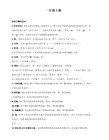
统一──分裂 繁荣──衰败 权利──义务 标志──丑陋 博大──肤浅
正常──异常 非凡──平凡 特别──一般 扫兴──高兴 轻蔑──敬重
开心──苦闷 寻常──异常 违背──遵循 怀疑──相信 强盛──衰败
是──非 闲──忙 来──去 分──合 存──亡 动──静 浓──淡 偏──正
饥──饱 爱──恨 升──降 开──关 始──终 胖──瘦 迎──送 盈──亏
真──假 虚──实 有──无 雅──俗 是──否 稀──密 粗──细 东──西
炎热──寒冷 诚实──撒谎 仔细──马虎 聪明──愚笨 空虚──充实
伶俐──笨拙 晦暗──明亮 勇敢──懦弱 宽容──严格 表扬──批评
一向──偶尔 善良──凶恶 寂静──热闹 穷苦──富裕 精致──粗糙
健康──虚弱 忧虑──放心 糟糕──精彩 便利──麻烦 表象──实质
含糊──清楚 严重──轻微 茂密──稀疏 光明──黑暗 微弱──强大
杰出──平庸 恶劣──良好 灿烂──暗淡 特殊──普通 异常──平常
简陋──豪华 诚意──假意 理屈──理直 拒绝──接受 惩罚──奖励
迟延──提前 示弱──逞强 好心──恶意 破碎──完整 酥软──坚硬
挺进──撤退 宽敞──狭窄 倾斜──竖直 闻名──无名 认识──陌生
舒畅──苦闷 结束──开始 紧张──轻松 整齐──纷乱 撒谎──诚实
慈祥──凶恶 可爱──可恶 紧张──轻松 附近──远方 赞许──反对
紧张──松弛 高兴──难过 飞快──缓慢 精彩──平淡 笨重──轻便
四字反义词
爱不释手 ── 不屑一顾 爱财如命 ── 妒贤嫉能 唯利是图 ── 仗义疏财
反义词大全
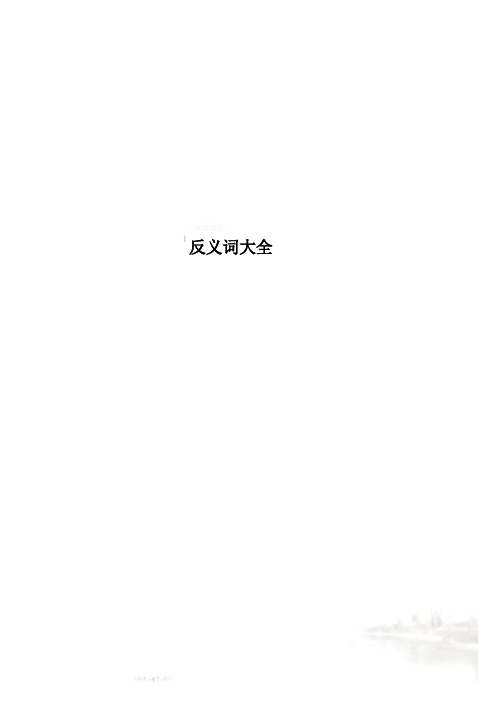
反义词大全反义词大全(共三十)反义词大全:(一)1.正--反负侧副偏歪误邪倒乱2.开--关闭合封谢停3.老--少小新嫩幼青4.主--次宾从客奴仆5.好--坏次烂赖破废歹6.取--存弃去舍送与7.利--害弊本钝8.兴--衰废替亡9.得--失丧丢去10.横--直竖纵顺11.人--鬼兽畜妖12.荣--辱枯耻13.缺--足全余多14.整--零破散碎15.伸--缩屈弯曲16.出--进入没纳17.灵--苯痴拙傻18.乐--忧哀悲愁苦19.吐--吞吃咽20.减--增加添21.敌--我友朋22.升--降落坠23.热--冷凉寒24.新--陈旧故25.坐--站立卧26.起--伏落止27.公--私母婆28.拆--装编合29.收--发种送反义词大全:(二)1.放--抓.拿.抱.逮.关.捕2.去--来.添.回.存.加.留.就3.衰--盛.兴.旺.勃.茂4.直--弯.曲.屈.斜5.推--拉.扯.拖.就6.精--傻.粗.痴.糙7.解--系.束.拴.结.缠8.乱--齐.整.正.治9.少--多.众.长10.暖--冷.凉.寒11.差--强.好.优12.削--补.增.添13.通--堵.碍.塞14.亡--存.生.活15.嫌--爱.喜.好16.松--紧.严17.野--朝.家18.实--虚.名19.背--向.腹20.顺--逆.倒21.尾--首.头22.本--末.标反义词大全:(三)1.稠--稀2.嫡--庶3.泰--否4.誉--毁5.官--民6.敢--怕7.熄--燃8.籴--粜9.贪--廉10.设--废11.排--灌12.动--静13.张--弛14.拔--插15.除--布16.阻--让17.心--口18.夭--寿19.现--隐20.融--凝21.秃--茂22.顽--乖23.常--变24.残--全25.冰--炭26.兄--弟27.父--子28.温--凉29.走--停30.雅--俗31.扬--抑32.脱--穿33.破--立34.醒--睡35.黑--白36.干--湿37.粗--细38.手--脚39.裁--缝40.敞--闭41.诚--伪42.有--无43.住--迁44.同--异45.中--外46.离--合47.深--浅48.苦--甜49.表--内50.断--续反义词大全:(四)1.上--下2.左--右3.大--小4.长--短5.单--双6.远--近7.沉--浮8.饱--饿9.分--合10.善--恶11.轻--重12.东--西13.南--北14.快--慢15.明--暗16.死--活17.古--今18.文--武19.哭--笑20.安--危21.忙--闲22.优--劣23.凶--吉24.详--略25.浓--淡26.难--易27.香--臭28.呼--吸29.软--硬30.水--火31.借--还32.攻--守33.春--秋34.始--终35.旱--涝36.省--费37.亲--疏38.忠--奸39.荤--素40.彼--此41.繁--简42.男--女43.城--乡44.爱--恨45.方--圆46.土--洋47.因--果48.祸--福49.贵--贱50.德--怨反义词大全:(五)1.厚--薄2.质--量3.寒--暑4.俯--仰5.俭--奢6.嫁--娶7.输--赢8.刚--柔9.经--纬10.供--求11.任--免12.凹--凸13.成--败14.褒--贬15.雌--雄16.当--赎17.信--疑18.销--购19.问--答20.进--退21.悲--欢22.点--面23.幼--长24.宝--废25.石--玉26.教--学27.君--臣28.尊--卑29.丰--歉30.乾--坤31.赔--赚32.辞--雇33.好--恶34.强--弱35.来--回36.奉--违37.夫--妻38.你--我39.集--散40.睁--闭41.急--缓42.畅--阻43.遐--迩44.瑕--瑜45.纯--杂46.响--哑47.险--夷48.未--已49.勇--怯50.青--黄反义词大全:(六)1.百孔千疮--万紫千红2.百年大计--权宜之计3.半路出家--科班出身4.包罗万象--挂一漏万5.背道而驰--并行不悖6.别有用心--直举胸情7.病入膏肓--举手成春8.波澜起伏--平铺直叙9.不假思索--深思熟虑10.不胜枚举--寥寥可数11.不相闻问--书来信往12.不屑一顾--另眼相看13.不翼而飞--舍浦珠还14.步履维艰--健步如飞15.步人后尘--独出心裁16.长篇累牍--简明扼要17.畅通无阻--寸步难行18.趁火打劫--救困扶危19.瞠目结舌--口若悬河20.成年累月--一朝一夕21.冲锋陷阵--临阵脱逃22.冲耳不闻--洗耳恭听23.臭名昭著--名满天下24.初出茅庐--老成持重25.初生之犊--惊弓之鸟26.出类拔萃--滥竽充数27.出头露面--隐姓埋名28.慈眉善眼--横眉怒目29.粗声大气--好声好气反义词大全:(七)1.俯首帖耳--桀骜不顺2.釜底抽薪--扬汤止沸3.改弦更张--旧调重弹4.高枕而卧--厉兵秣马5.孤芳自赏--自惭形秽6.骨瘦如柴--脑满肠肥7.顾此失彼--两全其美8.故步自封--勇猛精进9.国富民强--民穷财尽10.寒暑无间--一暴十寒11.好高务远--脚踏实地12.厚古薄今--厚今薄古13.灰心丧志--踌躇满志14.祸不单行--福无双至15.计划经济--市场经济16.寄人篱下--自立门户17.家徒四壁--金玉满堂18.嫁祸于人--引咎自责19.江郎才尽--七步之才20.骄兵必败--哀兵必胜21.今不如昔--今非昔比22.锦上添花--佛头着粪23.精诚团结--分崩离析24.迥然不同--如出一辙25.刻骨铭心--置若罔闻26.口蜜腹剑--倾心吐胆27.恋恋不舍--绝裾而去28.灵机一动--深思熟虑29.老态龙钟--童颜鹤发反义词大全:(八)1.任人唯亲--任人唯贤2.日月如梭--时光荏冉3.融会贯通--生吞活剥4.山河依旧--事过境迁5.姗姗来迟--捷足先登6.神采奕奕--没精打采7.生搬硬套--因地制宜8.生死攸关--无关痛痒9.如愿以偿--事与愿违10.若不禁风--拔山举鼎11.升堂入室--未学肤受12.盛气凌人--平易近人13.始终不渝--反复无常14.势不两立--唇齿相依15.守口如瓶--信口开河16.高瞻远瞩--鼠目寸光17.水乳交融--水火不容18.司空见惯--见所未见19.四平八稳--操之过急20.俗不可耐--文质彬彬21.随波逐流--自行其是22.随声附和--固执己见23.随遇而安--愤世疾俗24.损公肥私--大公无私25.天南地北--一衣带水26.甜言蜜语--金玉良言27.同舟共济--同床异梦28.兔死狐悲--幸灾乐祸29.歪歪扭扭--端端正正反义词大全:(九)1.有机可乘--无懈可击2.羽毛未丰--羽毛丰满3.乱七八糟--井井有条4.杂乱无章--有条不紊5.蒸蒸而上--每况愈下6.整齐划一--参差不齐7.直截了当--转弯抹角8.直言不讳--指桑骂槐9.趾高气扬--卑躬屈膝10.众寡悬殊--旗鼓相当11.众说纷纭--异口同声12.恣行无忌--谨言慎行13.自食其力--不劳而获14.左顾右盼--目不斜视15.坐失良机--机不可失16.应接不暇--应付自如17.万古长青--昙花一现18.心领神会--迷惑不解19.间接经验--直接经验20.流动资经--固定资经21.天然免疫--人工免疫22.隐花植物--显花植物23.爱才如命--挥金如土24.欣欣向荣--日暮途穷25.表里如一--两面三刀26.实事求是--弄虚作假27.精益求精--敷衍了事28.束手无策--千方百计29.不声不响--惊天动地反义词大全:(十)1.袖手旁观--见义勇为2.虚怀若谷--目空一切3.虚情假意--真心实意4.栩栩如生--死气沉沉5.悬崖勒马--执迷不悟6.血海深仇--雨露之恩7.揠苗助长--顺其自然8.言必有中--言不及义9.言之无物--言之有物10.叶落归根--背井离乡11.衣冠楚楚--衣衫褴褛12.一触即发--牢不可破13.一技之长--一无所长14.一览无余--管中窥豹15.一日千里--停滞不前16.一视同仁--厚此薄彼17.贪得无厌--分文不取18.天下太平--兵荒马乱19.通情达理--蛮横无理20.徒劳无益--劳苦功高21.徒有虚名--名副其实22.推波助澜--息事宁人23.望尘莫及--迎头赶上24.忘恩负义--感恩戴德25.委靡不振--精神抖擞26.未老先衰--老当益壮27.问长问短--不闻不问28.无的放失--有的放矢29.无恶不作--大发慈悲反义词大全:(十一)1.面不改色--面无人色2.明目张胆--偷偷摸摸3.名垂千古--名震一时4.名列前茅--名落孙山5.目不识丁--识文断字6.莫逆之交--一面之交7.藕断丝连--一刀两断8.暗箭难防--明枪易躲9.白璧微瑕--白璧无瑕10.百废待举--百废俱兴11.笨口拙舌--巧舌如簧12.不慌不忙--心慌意乱13.步步为营--长驱直入14.同义词--反义词15.必然性--偶然性16.羊肠小道--康庄大道金光大道17.仰人鼻息--独立自主自力更生18.垂头丧气--斗志昂扬兴高采烈19.光明正大--鬼鬼祟祟阴谋诡计20.理屈词穷--理直气壮义正词严21.门庭若市--门可罗雀门无蹄辙22.密密麻麻--稀稀拉拉稀稀落落23.莫不关心--关怀备至休戚相关24.年迈力衰--年富力强年轻力壮25.舍己为人--自私自利损人利己26.一无所有--无所不有应有尽有27.一心一意—三心二意反义词大全:(十二)1.被动--主动2.白米--糙米3.悲观--乐观4.笔试--口试5.笔译--口译6.便服--礼服7.便函--公函8.粗放--集约9.大写--小写10.淡季--旺季11.淡月--旺月12.地方--中央13.地狱--天堂14.动态--静态15.耳生--耳熟16.房东--房客17.丰收--歉收18.肯定--否定19.付方--收方20.感性--理性21.干线--支线22.公家--私人23.公事--私事24.公诉--自诉25.故杀--误杀26.官邸--私邸27.广义--狭义28.宏观--微观29.后天--先天30.活结--死结31.积极--消极32.寄籍--原籍33.寄读--走读34.间接--直接35.贱民--良民36.近因--远因37.净重--毛重38.净利--毛利39.绝对--相对40.口语--书面语41.利息--本金42.流动--固定43.密码--明码44.明人--盲人45.内服--外敷46.内功--外功47.内行--外行48.内在--外在反义词大全:(十三)1.逆水--顺水2.片面--全面3.生存--死亡4.文戏--武戏5.无方--有方6.细粮--粗粮7.先手--后手8.阳间--阴间9.阳文--阴文10.义务--权利11.音译--意译12.玉碎--瓦全13.直译--意译14.中餐--西餐15.主犯--从犯16.主攻--助攻17.主观--客观18.主人--客人19.专任--兼任20.坐商--行商21.细心--疏忽22.厌恶--喜爱23.防涝--抗旱24.记忆--忘却25.巨浪--微波26.分开--汇集27.楔入--退出28.贡献--索取29.极小--巨大30.赏赐--惩罚31.厄运--幸运32.稳定--摇摆33.指望--失望34.严重--轻松35.精确--大概36.独力--合力37.独立--依附38.短处--长处39.对立--统一40.恶化--好转41.恶意--善意42.繁茂--枯萎43.繁密--稀疏44.繁重--轻松45.反比--正比46.反常--正常47.反抗--服从48.方便--麻烦反义词大全:(十四)1.放肆--规矩2.放心--担心3.废除--缔结4.分离--结合5.分析--综合6.愤恨--喜爱7.分内--分外8.丰产--减产9.丰富--单调10.丰满--干瘪11.讽刺--恭维12.福星--灾星13.拂晓--傍晚14.腐败--清明15.俯视--仰望16.富贵--贫贱17.富强--贫困18.富饶--贫穷19.副品--正品20.附近--遥远21.干脆--拖沓22.干燥--潮湿23.干才--庸才24.干流--支流25.刚强--脆弱26.高超--低劣27.高大--矮小28.高见--浅见29.高洁--龌龊30.高就--屈就31.高亢--低沉32.高攀--低就33.隔离--接触34.个别--一般35.个性--共性36.工整--潦草37.光滑--粗糙38.光明--黑暗39.光荣--耻辱40.归纳--演绎41.过错--功劳42.过度--适度43.过去--现在44.搭伙--散伙45.搭救--陷害46.达观--悲观47.打击--鼓励48.大度--小气反义词大全:(十五)1.单薄--厚实2.单纯--复杂3.单独--共同4.淡季--旺季5.淡忘--铭记6.淡雅--妖艳7.淡月--旺月8.当地--外地9.倒霉--走运10.倒退--前进11.倒叙--顺叙12.得逞--未遂13.得到--失掉14.低沉--高昂15.低潮--高潮16.低级--高级17.低头--抬头18.敌对--友好19.抵赖--承认20.缔交--绝交21.地方--中央22.地下--地上23.典雅--粗俗24.东方--西方25.东洋--西洋26.动荡--安定27.动乱--太平28.动态--静态29.冻结--融化30.陡峭--平缓31.愁闷--开心32.愁容--笑脸33.仇恨--友谊34.出兵--收兵35.出工--收工36.出家--还俗37.出境--入境38.出生--死亡39.出售--收购40.出席--缺席41.出现--消失42.纯熟--生疏43.聪颖--呆笨44.匆匆--徐徐45.从犯--主犯46.粗心--细心47.粗略--仔细48.粗野--文明反义词大全:(十六)1.摈弃--采纳2.冰凉--滚热3.并重--偏重4.薄弱--雄厚5.猜忌--相信6.参加--退出7.残暴--慈善8.仓促--充裕9.苍白--红润10.苍穹--大地11.沧海--桑田12.拆穿--掩饰13.孱弱--强壮14.长久--短暂15.长途--短途16.畅快--烦闷17.撤回--呈上18.沉闷--爽朗19.沉睡--苏醒20.沉重--轻松21.沉着--慌张22.称赞--责备23.成绩--问题24.成事--败事25.成长--衰落26.诚实--虚假27.暗箭--明枪28.昂扬--低落29.昂首--俯首30.拔高--贬低31.罢工--复工32.白话--文言33.白皙--黝黑34.罢免--任用35.败北--胜利36.败笔--妙笔37.败兴--乘兴38.班师--出师39.帮助--欺负40.包围--突围41.褒义--贬义42.宝贝--废物43.饱满--干瘪44.保持--丢掉45.保存--销毁46.保管--丢掉47.保护--损害48.暴政--仁政反义词大全:(十七)1.背后--当面2.被动--主动3.被告--原告4.笨重--轻便5.彼岸--此岸6.必然--偶然7.必修--选修8.闭幕--开幕9.贬抑--褒扬10.贬值--升值11.消化--吸收12.消灭--保留13.消逝--出现14.销毁--保存15.小气--大方16.小人--君子17.小型--大型18.效果--动机19.孝顺--忤逆20.邪恶--正直21.邪气--正气22.斜视--正视23.协办--主办24.泄露--保密25.卸装--上装26.心虚--胆壮27.辛勤--懒惰28.新式--老式29.新异--陈旧30.修建--拆除31.袖珍--巨型32.序幕--尾声33.绚烂--暗淡34.寻常--特殊35.驯服--调皮36.驯顺--调皮37.压缩--发展38.安逸--劳碌39.安适--辛劳40.害怕--勇敢41.寒带--热带42.寒流--暖流43.豪门--寒门44.好感--恶感45.好看--难看46.好事--坏事47.好心--恶意48.好意--恶意反义词大全:(十八)1.和平--战争2.横死--善终3.后人--先人4.后退--前进5.忽然--逐渐6.糊涂--清楚7.滑稽--严肃8.滑溜--粗糙9.华丽--朴素10.化合--分离11.欢送--欢迎12.缓慢--飞快13.幻想--现实14.荒凉--繁华15.诙谐--严肃16.回顾--展望17.混杂--纯粹18.活泼--死板19.活跃--沉闷20.豁亮--昏暗21.获得--失掉22.积聚--散开23.吉利--凶险24.吉兆--凶兆25.集合--分散26.急迫--从容27.急燥--稳重28.加强--削弱29.加速--减速30.缄默--开腔31.监禁--开释32.坚决--迟疑33.艰苦--舒适34.奸猾--忠厚35.奸诈--忠厚36.简便--繁琐37.简单--复杂38.简洁--罗嗦39.简练--繁冗40.减员--增员41.践约--违约42.降落--起飞43.搅乱--澄清44.结巴--流利45.结果--原因46.解放--束缚47.谨慎--粗心48.进口--出口反义词大全:(十九)1.进步--保守2.晋级--降级3.晋升--降职4.禁止--允许5.近代--远古6.近古--远古7.精致--粗劣8.警惕--麻痹9.静止--运动10.就职--辞职11.旧居--新居12.剧烈--平和13.开拔--驻扎14.开化--野蛮15.开启--封闭16.开通--守旧17.开头--结尾18.开张--关闭19.空洞--充实20.空前--绝后21.口紧--口松22.酷爱--痛恨23.酷暑--严冬24.夸大--缩小25.亏本--赢利26.朗诵--默读27.老本--新功28.老大--少壮29.老练--幼稚30.扩大--缩小31.拉拢--打击32.冷漠--关心33.冷僻--常见34.离别--团聚35.离队--归队36.离奇--平淡37.离散--团聚38.离职--复职39.理论--实践40.理想--现实41.立体--平面42.立正--稍息43.利息--本金44.廉洁--贪贿45.联合--分散46.连续--间断47.良好--恶劣48.劣势--优势反义词大全:(二十)1.流露--隐藏2.沦陷--收复3.卖国--爱国4.漫长--短暂5.莽撞--细心6.没有--拥有7.美化--丑化8.媚骨--傲骨9.密致--稀疏10.明确--含糊11.耐心--急躁12.难受--舒服13.逆境--顺境14.逆流--顺流15.浓密--稀疏16.浓缩--稀释17.浓重--淡薄18.偶数--奇数19.排泄--摄取20.派遣--召还21.配角--主角22.偏向--公平23.片刻--多时24.漂亮--难看25.破例--照例26.破灭--实现27.破损--完好28.欺负--帮助29.漆黑--雪白30.恰当--失当31.谦恭--傲慢32.前方--后方33.前锋--后卫34.浅陋--渊博35.浅显--艰深36.欠缺--齐全37.强劲--微弱38.切题--离题39.亲热--冷淡40.清澈--混浊41.清洁--肮脏42.清朗--阴晦43.清廉--贪贿44.清亮--浑浊45.清明--腐败46.清癯--丰腴47.清音--浊音48.轻盈--蠢笨反义词大全:(二十一)1.权力--义务2.缺额--满额3.群众--干部4.人家--自己5.人间--天上6.人性--兽性7.荣誉--耻辱8.柔嫩--坚硬9.锐角--钝角10.锐利--迟钝11.闰年--平年12.洒脱--拘束13.丧事--喜事14.沙漠--绿洲15.上层--下层16.上面--下面17.神仙--凡人18.慎重--轻率19.升级--降级20.省力--费力21.盛世--乱世22.盛暑--严冬23.湿润--干燥24.师傅--徒弟25.失常--正常26.失利--得胜27.失算--得计28.失约--如约29.释放--逮捕30.过分--适当31.守业--创业32.手段--目的33.受骗--行骗34.受罪--享福35.疏松--严密36.疏通--堵塞37.输入--输出38.熟识--陌生39.熟手--生手40.衰竭--亢进41.衰退--旺盛42.爽利--邋遢43.顺从--反抗44.随便--严肃45.坦白--隐瞒46.坦然--狼狈47.狭隘--宏大48.上策--下策反义词大全:(二十二)1.下放--上交2.上岗--下岗3.上级--下级4.下降--上升5.下联--上联6.下面--上面7.下人--主人8.下调--上调9.下文--上文10.下限--上限11.下游--上游12.先遣--后援13.鲜艳--暗淡14.娴熟--生疏15.衔接--割断16.显赫--卑微17.现代--古代18.现任--前任19.限制--自由20.相连--分隔21.相通--堵塞22.香花--毒草23.享福--遭罪24.响亮--低沉25.响应--反对26.消耗--积蓄27.体力--脑力28.天才--蠢才29.天干--地支30.天灾--人祸31.甜美--苦涩32.甜头--苦头33.调解--挑拨34.调皮--驯顺35.听从--违抗36.停顿--进展37.停火--开火38.停留--前进39.停业--开业40.通畅--阻塞41.同化--异化42.统统--仅仅43.突然--逐渐44.团体--个人45.推销--采购46.推卸--承担47.拖拉--利索48.外表--内心反义词大全:(二十三)1.外调--内查2.外交--内政3.外科--内科4.外力--内力5.外露--深沉6.外围--核心7.外销--内销8.外延--内涵9.玩忽--忠于10.顽固--开明11.晚年--早年12.晚期--早期13.婉言--直言14.微小--巨大15.违反--符合16.维护--败坏17.伟大--渺小18.违背--遵从19.委婉--生硬20.未然--已然21.温饱--饥寒22.文科--理科23.乌黑--洁白24.无关--有关25.无视--正视26.无畏--恐惧27.无须--必须28.侮慢--敬爱29.务实--务虚30.误解--谅解31.希望--失望32.袭取--篡改33.喜好--厌恶34.喜悦--悲哀35.细小--巨大36.延长--缩短37.延缓--提早38.眼前--长远39.眼生--眼熟40.谣言--事实41.野蛮--文明42.异常--正常43.殷勤--怠慢44.隐瞒--暴露45.英雄--懦夫46.盈余--亏损47.永久--暂时48.勇敢--胆怯反义词大全:(二十四)1.犹豫--果断2.有机--无机3.有益--无益4.幼年--成年5.迂缓--迅速6.愚昧--智慧7.郁闷--畅快8.远视--近视9.悦耳--刺耳10.赞赏--贬斥11.糟蹋--爱惜12.糟糕--精彩13.真实--虚伪14.真理--谬论15.镇静--慌张16.争光--抹黑17.整体--部分18.正史--野史19.滞销--畅销20.治本--治标21.置疑--置信22.制止--允许23.质变--量变24.质量--数量25.中断--持续26.中间--旁边27.终点--起点28.众多--稀少29.主要--次要30.自然--人工31.自私--无私32.诅咒--祝愿33.嘴紧--嘴松34.嘴甜--嘴损35.尊贵--卑贱36.左倾--右倾37.左翼--右翼38.做作--真实.自然39.遵循--背离.违背40.尊重--鄙薄.侮辱41.尊敬--轻慢.侮慢42.罪过--功绩.功劳43.自愿--被迫.强制44.茁壮--孱弱.纤弱45.拙劣--高明.巧妙46.周密--粗疏.疏忽反义词大全:(二十五)1.先进--保守.后进2.粗壮--纤弱.纤细3.相逢--分别.离别4.简备--简明.简略5.详尽--简明.简要6.详情--简况.概况7.反抗--降服.降顺8.高涨--消沉.低落9.消费--积累.生产10.萧条--繁华.繁荣11.晦涩--晓畅.流畅12.新鲜--陈腐.陈旧13.休息--工作.劳动14.虚弱--健壮.强壮15.虚心--骄傲.自满16.许可--反对阻止18.喧闹--安谧.肃静19.削减--增加.增添20.迅速--迟缓.缓慢21.天然--人工.自然22.后来--起先.起初23.严厉--慈祥.温和24.隐蔽--暴露.显露25.阴沉--晴朗.响晴26.庸俗--高尚.文雅27.有利--不利.无利28.有趣--乏味.无聊29.愚蠢--聪明.聪颖30.愚笨--灵活.乖巧31.愉快--烦闷.痛苦32.悦耳--刺耳.难听33.停滞--发展.延续34.停止--进行.延续35.推翻--建立.扶植36.退缩--前进.进取37.外患--内患.内乱38.完整反义词大全:(二十六)1.合法--非法.违法2.合作--分工.单干3.和顺--倔强.凶暴4.后方--前方.前线5.糊涂--明白.清醒6.华丽--朴实.简陋7.怀疑--相信.信任8.激动--沉着.镇静9.机灵--呆板.笨拙10.继续--中止.中断11.急促--舒缓.缓慢12.简陋--豪华.华丽13.简略--详尽.详细14.减少--增加.增添15.降低--升高.增高16.揭露--掩盖.掩饰17.糟蹋--节省.节约18.解散--成立.集会19.酷寒--酷热.炎热20.酷热--酷寒.严寒21.宽敞--狭小.狭窄22.宽绰--穷困.狭窄23.宽大--狭小.窄小24.严惩--宽容.宽恕25.冷落--繁华.热闹26.冷清--热闹.红火27.利落--迟钝.拖沓28.害处--利益.益处29.廉价--高价.重价30.辽阔--狭小.窄小31.了解--陌生.生疏32.临时--长期.反义词大全:(二十七)1.朴素--花哨.艳丽2.齐整--凌乱.零乱3.平常--奇怪.奇特4.谦逊--傲慢.骄傲5.前辈--后辈.后代6.前面--后面.背后7.强大--弱小.虚弱8.强健--虚弱.孱弱9.强烈--柔和.微弱10.怯懦--大胆.勇敢11.切实--浮夸.空洞12.勤奋--懒惰.怠惰13.清楚--模糊.朦胧14.清淡--浓郁.油腻15.清静--热闹.喧闹16.轻巧--笨重.繁重17.部分--全体.全部18.缺陷--优点.长处19.热情--冷淡.淡漠20.凝固--熔化.融化21.冗长--简短.洗练22.弱小--强大.魁梧23.伤害--爱护.保护24.生动--枯燥.死板25.失败--胜利.成功26.失意--得意.得势27.逝世--出生.诞生28.瘦小--肥大.魁梧29.瘦削--肥胖.丰满30.舒畅--郁闷.抑郁31.熟练--生疏.生僻32.熟悉--陌生.反义词大全:(二十八)1.革命--改良.反动2.柔弱--刚健.刚劲3.高尚--卑鄙.卑劣4.窄小--广大.广阔5.打开--关上.盖上6.大意--小心.精心7.呆板--活泼.自然8.少量--大量.大批9.胆小--胆大.大胆10.当初--今日.现在11.当前--长远.以前12.地面--天空.高空13.地狱--天堂.天国14.客人--主人.东道15.斗争--调和.妥协16.厌恶--爱好.宠爱17.充实--单薄.空虚18.仇人--亲人.恩人19.一般--出众.出色20.处分--奖赏.奖励21.纯洁--肮脏.龌龊22.粗率--典雅.高雅23.冰冷--炽热.火热24.薄情--痴情.多情25.嘲笑--赞美.赞叹26.陈旧--崭新.簇新27.残缺--完好.健全28.拆卸--安装.装配29.常态--失态.变态30.霸道--人道.王道31.高兴--痛苦.悲痛.难过反义词大全:(二十九) 1.忘怀--想念. 挂念 .思念2.掩盖--暴露. 揭示. 坦露3.忧郁--高兴. 快乐. 兴奋4.幼稚--成熟. 老成 .老练5.迥异--相似. 相同 .相象6.详细--概要. 扼要. 粗略7.个人--集体. 大家. 大伙8.公开--秘密. 暗中. 隐蔽9.新颖--陈旧 .平常 .一般10.振奋--颓废. 颓丧 .萎靡11.振作--颓废. 颓丧.萎靡12.正确--差错. 错误. 荒谬13.直率--委婉. 隐晦 .油滑14.拙见--高见. 高论.卓见15.自卑--自大. 自傲. 自豪16.寒冷--温暖. 暖和. 炎热17.和气--粗暴. 蛮横.凶恶18.和善--凶恶. 凶狠. 粗暴19.黄昏--拂晓. 黎明. 破晓20.集中--分开. 分散.扩散21.寂静--喧闹 .喧哗. 喧嚣22.坚定--犹豫. 犹疑. 动摇23.简明--烦琐. 繁琐.繁冗24.将来--目前. 现在. 过去25.奖励--处分. 处罚. 惩罚26.接受--送出. 拒绝.进去27.接受--推辞. 谢绝. 抛弃28.进攻--防守. 退却. 撤退29.拘束--随便. 大方.洒脱反义词大全:(三十)1.深奥--浅显. 通俗. 浅近2.收缩--发展. 扩大. 膨胀3.守旧--创新. 革新. 开通4.疏远--亲近. 密切 .亲密5.讨厌--喜欢.喜爱.可爱6.庄重--草率.轻率.轻浮.轻佻7.自己--别人. 大家. 人家.他人8.遵循--违背. 违反. 违抗. 违犯9.郑重--草率. 潦草. 马虎.轻率10.正面--背面. 侧面. 反面 .背后11.幸福--悲伤. 痛苦. 灾难.悲惨12.虚伪--诚恳.诚实. 笃实. 老实13.细致--粗略. 马虎. 粗疏.粗糙14.狭窄--宽阔. 开阔. 广阔. 广泛15.反对--同意. 支持. 拥护.赞成16.丑陋--标致. 漂亮. 优美. 俊美. 美丽17.从容--慌乱. 慌忙. 紧迫.慌张18.暴露--掩盖. 包藏. 隐蔽. 隐藏19.和蔼--严厉. 粗暴. 蛮横.凶恶20.狡猾--老实. 忠诚. 诚实. 忠实21.快活--苦恼. 苦闷. 烦闷.忧愁22.宽广--狭隘. 狭小. 狭窄. 窄小23.浪费--节约. 节省。
反义词大全
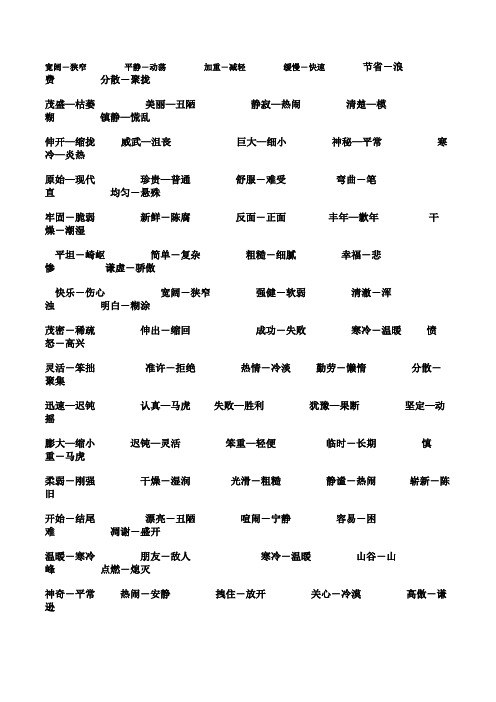
宽阔―狭窄平静―动荡加重―减轻缓慢―快速节省―浪费分散―聚拢茂盛—枯萎美丽—丑陋静寂—热闹清楚—模糊镇静—慌乱伸开—缩拢威武—沮丧巨大—细小神秘—平常寒冷—炎热原始—现代珍贵—普通舒服―难受弯曲―笔直均匀―悬殊牢固―脆弱新鲜―陈腐反面―正面丰年—歉年干燥―潮湿平坦―崎岖简单―复杂粗糙―细腻幸福―悲惨谦虚―骄傲快乐―伤心宽阔―狭窄强健―软弱清澈―浑浊明白―糊涂茂密―稀疏伸出―缩回成功―失败寒冷―温暖愤怒―高兴灵活―笨拙准许―拒绝热情―冷淡勤劳―懒惰分散―聚集迅速—迟钝认真—马虎失败—胜利犹豫—果断坚定—动摇膨大—缩小迟钝—灵活笨重—轻便临时―长期慎重―马虎柔弱―刚强干燥―湿润光滑―粗糙静谧―热闹崭新―陈旧开始―结尾漂亮―丑陋喧闹―宁静容易―困难凋谢―盛开温暖―寒冷朋友―敌人寒冷―温暖山谷―山峰点燃―熄灭神奇―平常热闹―安静拽住―放开关心―冷漠高傲―谦逊郑重―轻率从容―慌张奢侈―寒酸敏捷―迟缓合上―打开老实―狡猾温柔―粗暴丰富―贫乏高兴―难过淘气―规矩讨厌―喜欢反抗―顺从忠厚―奸诈温暖―寒冷蜿蜒―笔直坚固―脆弱清楚―模糊陡峭―平坦伟大―渺小美丽―丑陋相同―不同古老―现代宏大―微小魁梧―矮小丰满―干瘪故人―新朋无名―有名懒惰―勤劳满意―失望灿烂―暗淡凋零―盛开容易―困难希望―失望安全―危险可怜―可恨庄重―轻浮热情―冷淡坚强―懦弱宽裕―拮据神气―颓丧喜悦―忧伤快乐―悲伤繁华―萧条热闹―宁静褴褛―华丽踊跃―消极清晰―模糊仔细―粗心具体―大略温柔―粗暴危险―安全匆匆―慢慢认识―陌生疏远―亲近聪明―愚蠢长处―短处现代―古代依赖―自立舒适―艰苦输入―输出陌生―熟悉打开―关闭凶猛―温和笨重―轻巧迟钝―灵敏相似―相反特殊―一般美妙―蹩脚优良―低劣勤劳―懒惰俊俏—丑陋轻快—沉重鲜艳—暗淡增添—削减活泼—呆板聚拢—分散停止—开始玲珑—粗笨灵活—呆板陡峭—平坦送行—迎接舒适—难受悲惨—幸福愈合—开裂有名—无名离开—回归害怕—勇敢忧伤—高兴飞快—缓慢成功—失败镇定-- 慌张严寒--温暖恶劣—优良湿润--干燥为难--容易惬意—满意惊讶—吃惊朦胧—模糊优惠—优待精巧—精致完美—完善反驳—反对逻辑—规律危险—安全担心—放心朦胧—清楚高兴—难受便宜—昂贵喜欢—讨厌兴许—也许轻巧—轻松率先—首先忙碌—劳碌欣赏—赏识寻觅—寻找会晤—会见感触—感受振奋—振作生气—生机慈祥—慈爱忧虑—放心糟糕—精彩感激—感谢失望—期望紧张—松懈激烈-- 平静狼狈-- 潇洒英勇--怯懦繁荣—衰败精致—粗糙权利—义务穷苦—富裕精致—粗糙健康—虚弱潮湿—干燥喜欢—讨厌危险—安全寂寞—喧闹奴隶—主人紧张—松弛统一—分裂诚意—假意理屈—理直拒绝—接受惩罚—奖励迟延—提前示弱—逞强好心—恶意破碎—完整酥软—坚硬炎热—寒冷诚实—撒谎仔细—马虎正常—异常非凡—平凡特别—一般扫兴—高兴轻蔑—敬重开心—苦闷寻常—异常违背—遵循怀疑—相信强盛—衰败尊重—侮辱激烈—平静嘈杂—寂静美丽—丑陋信奉—背弃失信—守信率领—追随退化—进化凝结—溶解伟大—渺小聚拢—分散增添—减少活泼—呆板鲜艳—暗淡严寒—酷暑安谧—嘈杂温暖—凉爽柔和—严厉拒绝—同意清醒—糊涂荒芜—耕种清晰—浑浊坚强—软弱纯熟—生疏陌生—熟悉平坦——崎岖光滑——粗糙慎重——随便喜欢——厌恶痛快——难受幽静——喧闹崎岖——平坦刚强——软弱慌忙——镇定熟识——生疏伶俐——笨拙怕羞——大方镇定——慌张团结——分裂羞涩——大方严寒——炎热洒脱——拘谨明朗——阴沉沉重——轻盈迂回——径直清澈——浑浊脆弱——坚强饱满——干瘪衰弱——强健犹豫——坚定丰收——歉收复杂——简单淡妆——浓抹相宜——不宜自在——拘束平常——奇特勤劳——懒惰喜欢——讨厌密集——稀疏胜利——失败挺进——撤退宽敞——狭窄倾斜——竖直闻名——无名认识——陌生有趣——乏味舒畅——苦闷结束——开始紧张——轻松整齐——纷乱安全——危险撒谎——诚实慈祥——凶恶可爱——可恶紧张——轻松仔细——粗心附近——远方赞许——反对淡水——咸水高兴——难过飞快——缓慢精彩——平淡笨重——轻便紧张——松弛有趣——乏味听从——违抗诚实——虚伪承认——否认高兴——伤心起劲——没劲简单——复杂容易——困难熟练——生疏准确——错误温和——严厉暴躁——温和近处——远处气愤——欢喜粗心——细心美丽——丑陋洁白——乌黑高兴——痛苦宽阔——狭窄新款——陈旧兴旺——衰败团结——分裂敏捷——迟钝危险——安全常常——偶尔幼稚——老练含糊——清楚严重——轻微茂密——稀疏光明——黑暗微弱——强大杰出——平庸恶劣——良好灿烂——暗淡特殊——普通异常——平常简陋——豪华笑盈盈—哭啼啼笑嘻嘻――哭兮兮恍恍惚惚—清清楚楚一模一样—截然不同柳暗花明—山穷水尽风平浪静—风号浪吼人声鼎沸―鸦雀无声勤勤恳恳―懒懒散散一丝不苟―敷衍了事隐隐约约―清清楚楚享誉世界―默默无闻相背而行―相向而行恍然大悟―百思不解筋疲力尽―精神抖擞名副其实——名不副实雪中送炭——雪上加霜歪歪斜斜——端端正正风平浪静——狂风恶浪迷迷糊糊——清清楚楚全神贯注——心不在焉断断续续——连续不断赏心悦目——触目惊心一丝不苟——粗心大意力倦神疲——精力充沛万马奔腾——无声无息暖暖和和——冷冷清清吞吞吐吐——干干脆脆毫不犹豫——犹豫不决别具一格——普普通通熙熙攘攘——冷冷清清心惊肉跳——镇定自如理直气壮——理屈词穷一朝一夕——日久天长悔过自新——执迷不悟群策群力——孤掌难鸣废寝忘食——饱食终日沸沸扬扬——鸦雀无声翻来覆去——简单明了吵吵嚷嚷——冷冷清清唇枪舌剑——心平气和粗制滥造——精雕细刻安居乐业——颠沛流离端端正正——歪歪斜斜面露愁容——面带微笑筋疲力尽——干劲十足成竹在胸——胸有成竹大——小多——少上——下左——右前——后冷——热高——低进——退黑——白天——地男——女里——外死——活公——私快——慢矛——盾宽——窄强——弱轻——重缓——急松——紧好——坏美——丑善——恶是——非闲——忙来——去分——合存——亡动——静浓——淡偏——正饥——饱爱——恨升——降开——关始——终胖——瘦迎——送盈——亏真——假虚——实有——无雅——俗是——否稀——密粗——细东——西巧——拙恩——怨新——旧正——邪通——堵止——行古——今张——弛曲——直亮——暗亲——疏收——放输——赢逆——顺苦——甜忠——奸纵——横得——失南——北薄——厚哭——笑文——武推——拉问——答主——仆买——卖深——浅聚——散干——湿彼——此生——熟单——双首——末你——我敌——友警——匪盛——衰胜——败加——减软——硬阴——阳顺——逆反——正祸——福信——疑错——对藏——露老——少断——续钝——锐浓——淡雌——雄醒——睡止——行咸——淡正——歪凉——暖深——浅窄——宽远——近高——低冷——热横——竖涨——降隐——现同——异浑——清紧——松无——有明——暗细——粗嫩——老凹——凸公——母浮——沉朝——暮轻——重输——赢逆——顺苦——甜忠——奸纵——横得——失南——北薄——厚哭——笑文——武推——拉问——答主——仆买——卖深——浅聚——散干——湿彼——此生——熟单——双首——末你——我敌——友警——匪盛——衰胜——败加——减软——硬阴——阳顺——逆反——正祸——福信——疑错——对藏——露老——少断——续钝——锐浓——淡雌——雄醒——睡止——行咸——淡正——歪凉——暖深——浅窄——宽远——近高——低冷——热横——竖涨——降隐——现同——异浑——清紧——松无——有明——暗细——粗嫩——老凹——凸公——母浮——沉朝——暮轻——重。
- 1、下载文档前请自行甄别文档内容的完整性,平台不提供额外的编辑、内容补充、找答案等附加服务。
- 2、"仅部分预览"的文档,不可在线预览部分如存在完整性等问题,可反馈申请退款(可完整预览的文档不适用该条件!)。
- 3、如文档侵犯您的权益,请联系客服反馈,我们会尽快为您处理(人工客服工作时间:9:00-18:30)。
正常──异常 非凡──平凡 特别──一般 扫兴──高兴 轻蔑──敬重 开心──苦闷 寻常──异常 违背──遵循 怀疑──相信 强盛──衰败 尊重──侮辱 激烈──平静 嘈杂──寂静 美丽──丑陋 信奉──背弃 失信──守信 率领──追随 退化──进化 凝结──溶解 伟大──渺小 聚拢──分散 增添──减少 活泼──呆板 鲜艳──暗淡 严寒──酷暑 安谧──嘈杂 温暖──凉爽 可爱──可恶 紧张──轻松 仔细──粗心
2. The term antonym (and the related antonymy) has also been commonly used as a term that is synonymous with opposite; however, the term also has other more restricted meanings. One usage has antonym referring to both gradable opposites, such as long : short, and (nongradable) complementary opposites, such as male : female, while opposites of the types up : down and precede : follow are excluded from the definition.
Types pf antonyms
plementaries互补性反义词 互补性反义词 Complementary opposites are pairs that express absolute opposites, like mortal —— immortal, single——married, male——female, dead——alive
3. A third usage (particularly that of the influential Lyons 1968, 1977) defines the term antonym as referring to only gradable opposites (the long : short type) while the other types are referred to with different terms. Therefore, as Crystal (2003) warns, the terms antonymy and antonym should be regarded with care. In this article, the usage of Lyons (1963, 1977) and Cruse (1986, 2004) will be followed where antonym is restricted to gradable opposites and opposite is used as the general term referring to any of the subtypes discussed below.
Though the word antonym was only coined by philologists in the 19th century, such relationships are a fundamental part of a language, in contrast to synonyms, which are a result of history and drawing of fine distinctions, or homonyms, which are mostly etymological accidents or coincidences. Languages often have ways of creating antonyms as an easy extension of lexicon. For example, English has the prefixes in- and un-, so unreal is the antonym of real and indocile is of docile. Some planned languages abundantly use such devices to reduce vocabulary multiplication. Esperanto has mal- (compare bona = "good" and malbona = "bad"), Damin has kuri- (tjitjuu "small", kuritjitjuu "large") and Newspeak has un- (as in ungood, "bad").
常见反义词列表
前──后 冷──热 高──低 进──退 死──活 公──私 快──慢 矛──盾 宽──窄 强──弱 轻──重 缓──急 松──紧 好──坏 美──丑 善──恶 是──非 闲──忙 来──去 分──合 存──亡 动──静 浓──淡 偏──正 饥──饱 爱──恨 升──降 开──关 始──终 胖──瘦 迎──送 盈──亏 真──假 虚──实 有──无 雅──俗
2.gradable opposites等级性反义词 等级性反义词 For the purposes of this article (see introduction), antonyms, from the Greek anti ("opposite") and onoma ("name") are gradable opposites. Gradable opposites lie at opposite ends of a continuous spectrum of meanings; examples are hot and cold, slow and fast, and fat and skinny. Words may have several different antonyms, depending on the meaning: both long and tall can be antonyms of short.
反义词就是两个意思相反的词,包括:绝 对反义词和相对反义词。分为成对的意 义相反、互相对立的词。如:真-假,动静,拥护-反对。这类反义词所表达的概 念意义互相排斥。或成对的经常处于并 举、对待位置的词。如:春-秋,黑-白, 高山-平地。这类反义词没有矛盾对立关 系,但对比鲜明。
注意事项 1、组成反义词(Antonym)的一对词必须属于同一 意义范畴,如:长-短(长度),开头-结尾(过程), 古-今(时间)。 2、不是任何一个词都有反义词。反义词以形容词 最多,其次是动词;表示具体事物的名词(书、笔)大 部分没有反义词。 3、多义词 ( polysemy )可以有几个跟不同义项相配 的反义词,如:快-慢、钝,清淡-浓郁、油腻。 4、反义词包括:绝对反义词(Contradictory antonym)和相对反义词(C容词才有反义词。确定的 动词、名词之类的没有反义词,比如“飞”没有反义词; “鸟”没有反义词。
3.Relational antonyms (Converses) 换 位性反义词 are pairs in which one describes a relationship between two objects and the other describes the same relationship when the two objects are reversed,such as parent and child, teacher and student, or buy and sell.
含有反义词的成语
翻来覆去 继往开来 截长补短 空前绝后 弄假成真 头重脚轻 同甘共苦 假公济私 争先恐后 花天酒地 顾此失彼 扬长避短 取长补短 除旧布新 七上八下 积少成多 声东击西 惩前毖后 转败为胜 前仰后合 厚此薄彼 说长道短 今是昨非 你死我活 完整无缺 尺短寸长 喜新厌旧 自始至终 开天辟地 天罗地网 虎头蛇尾 街头巷尾 三长两短 口是心非 似是而非 拈轻怕重 借古讽今 避重就轻 瞻前顾后 凶多吉少 眼高手低 返老还童 惊天动地 顶天立地
What is
1.
?
In lexical semantics, opposites are words that lie in an inherently incompatible binary relationship as in the opposite pairs male : female, long : short, up : down, and precede : follow. The notion of incompatibility here refers to the fact that one word in an opposite pair entails that it is not the other pair member. For example, something that is long entails that it is not short. It is referred to as a 'binary' relationship because there are two members in a set of opposites. The relationship between opposites is known as opposition. A member of a pair of opposites can generally be determined by the question What is the opposite of X ?
